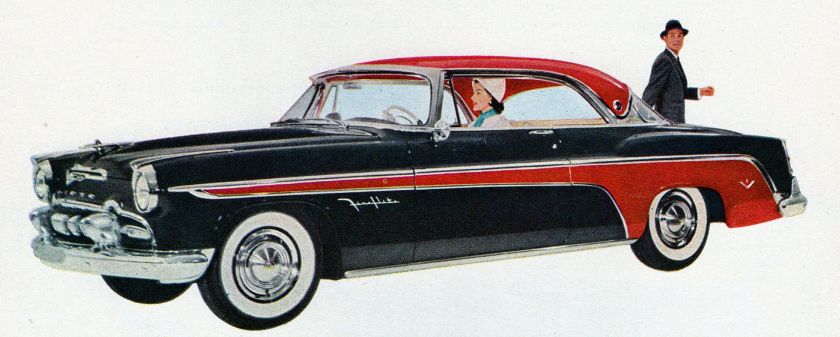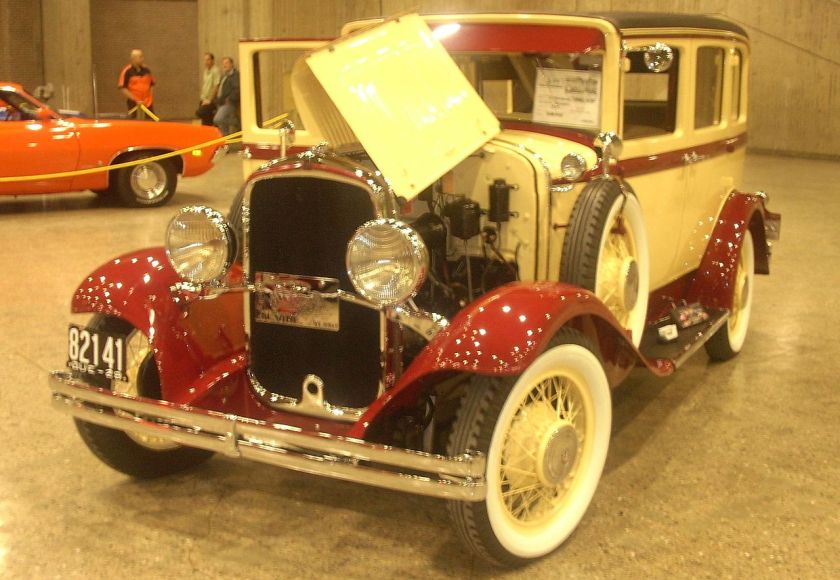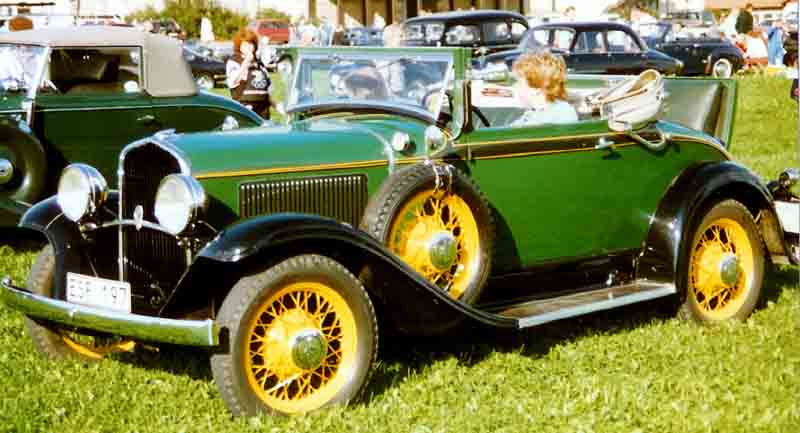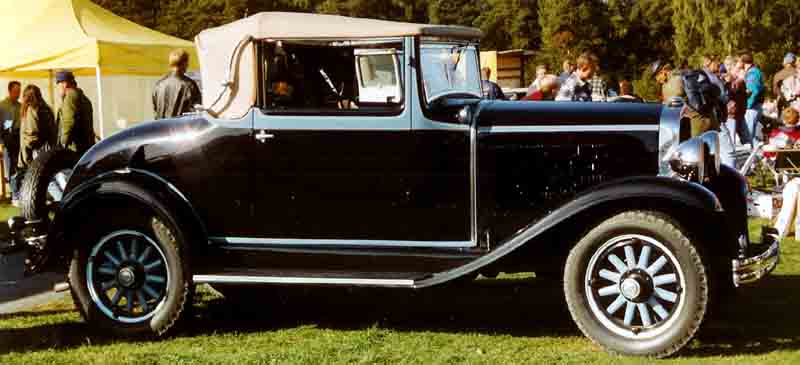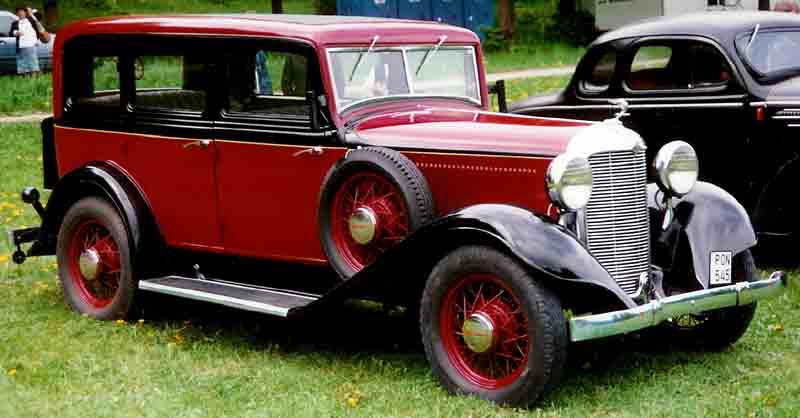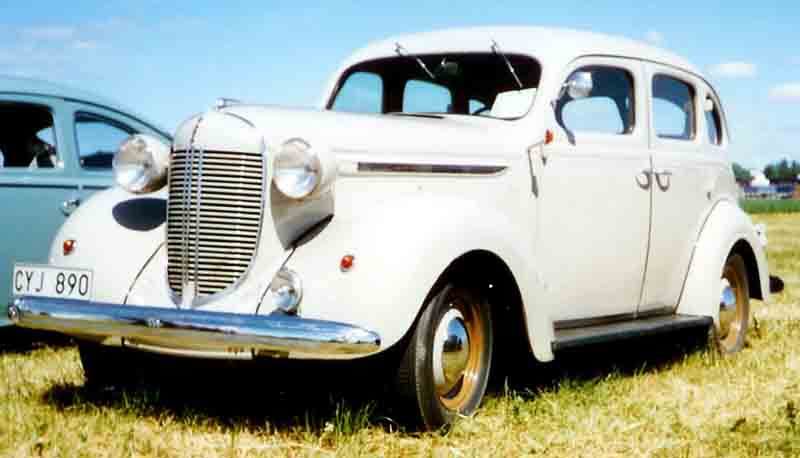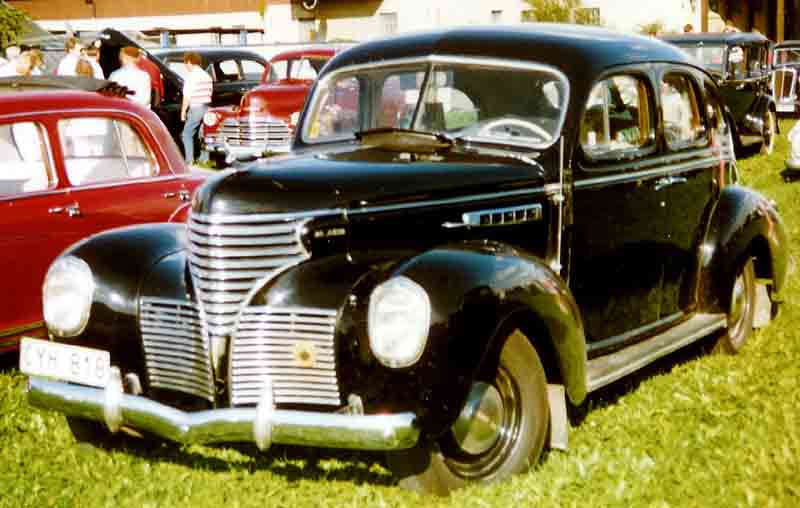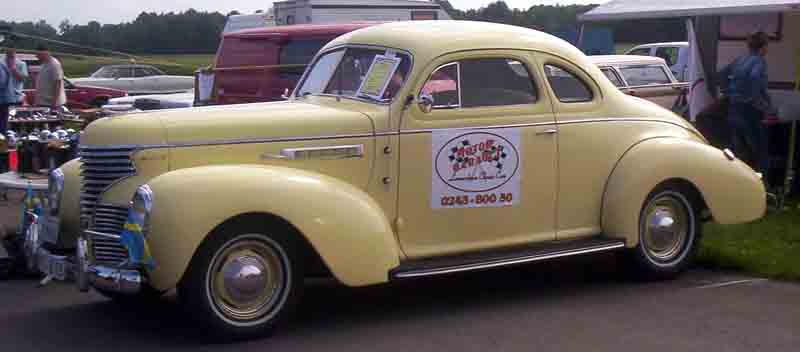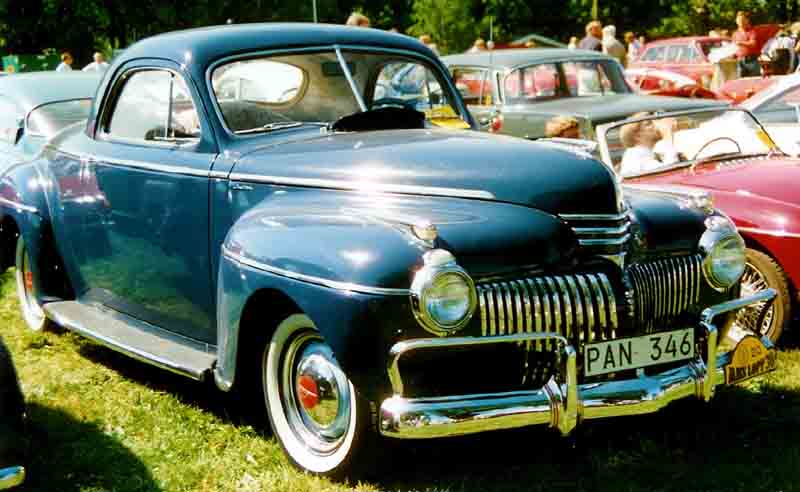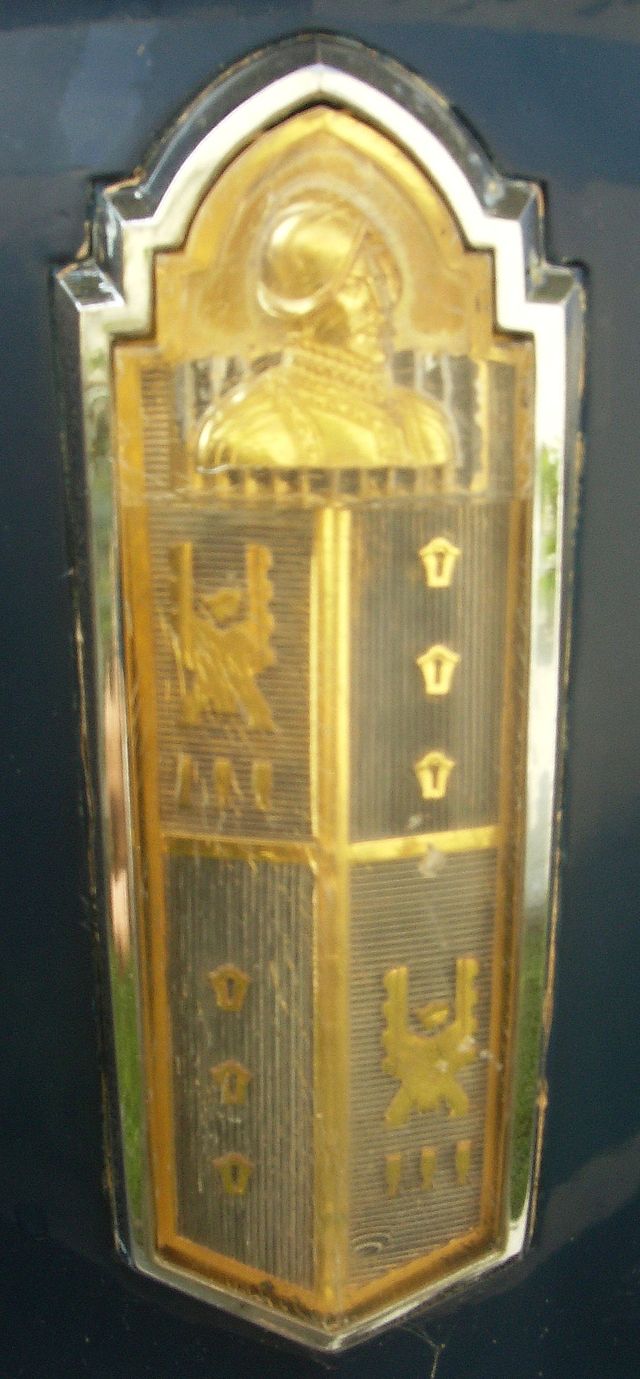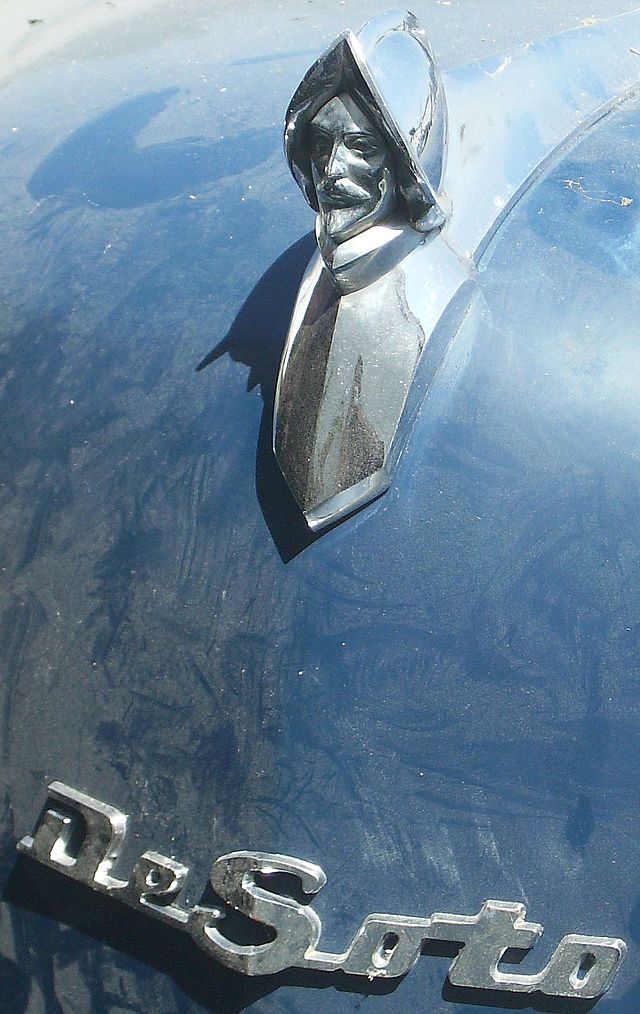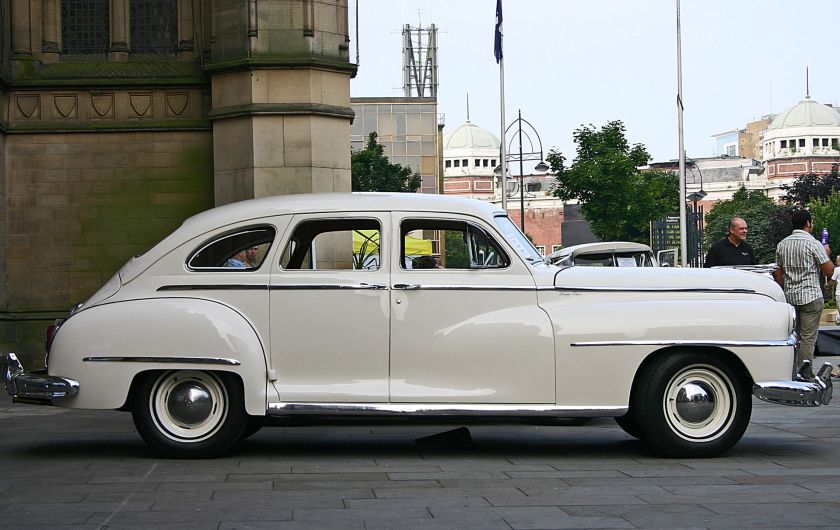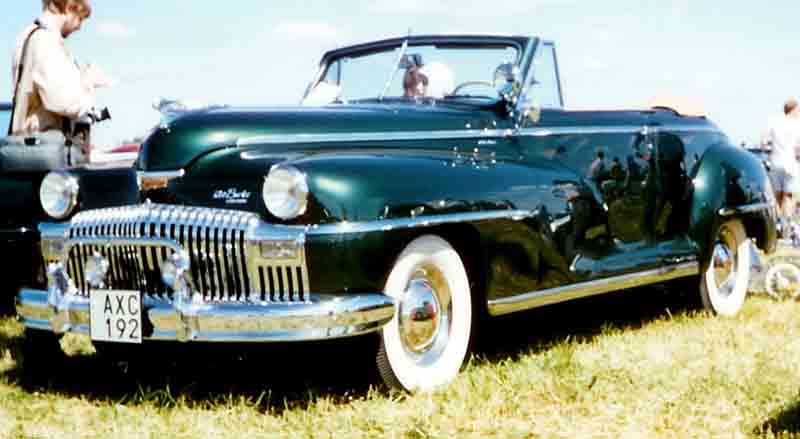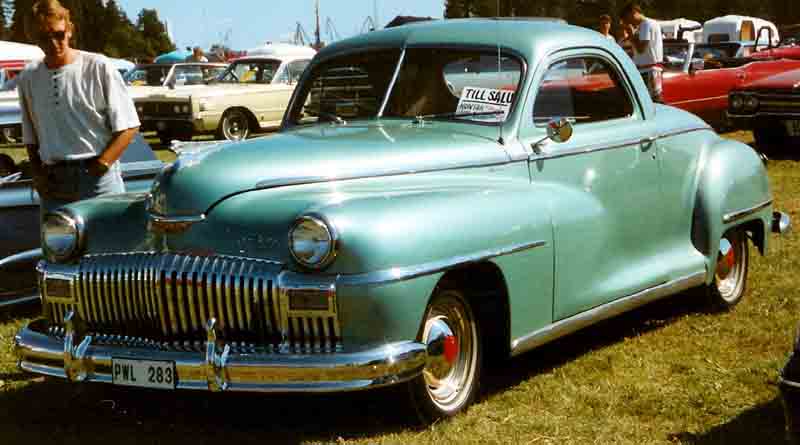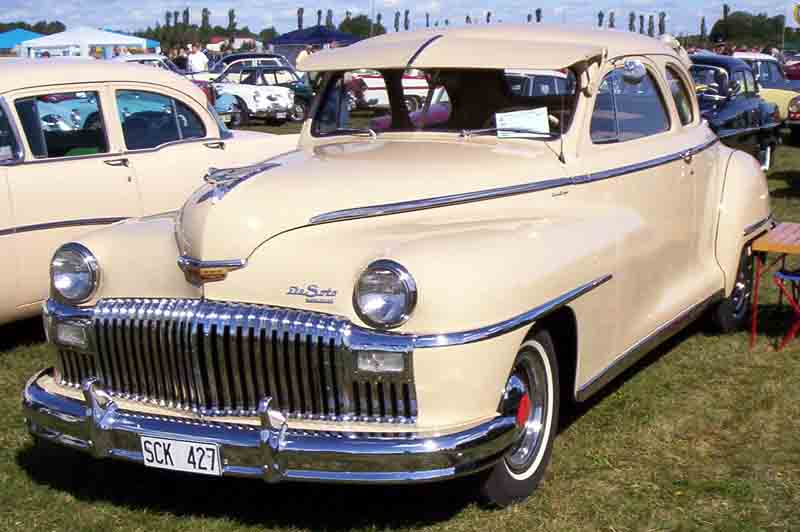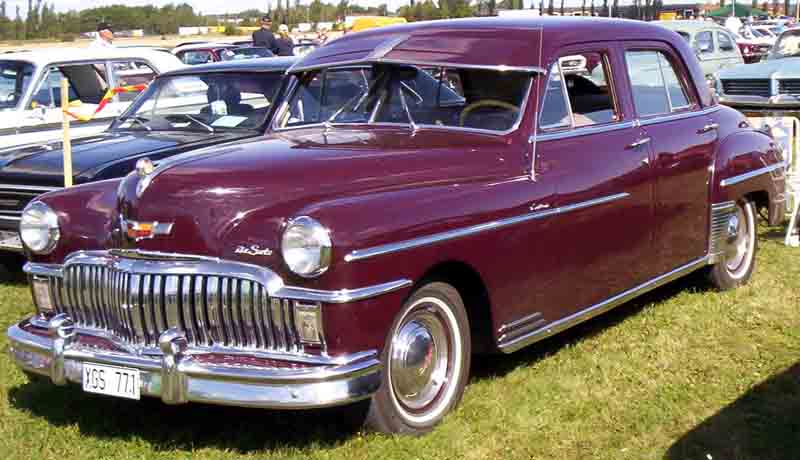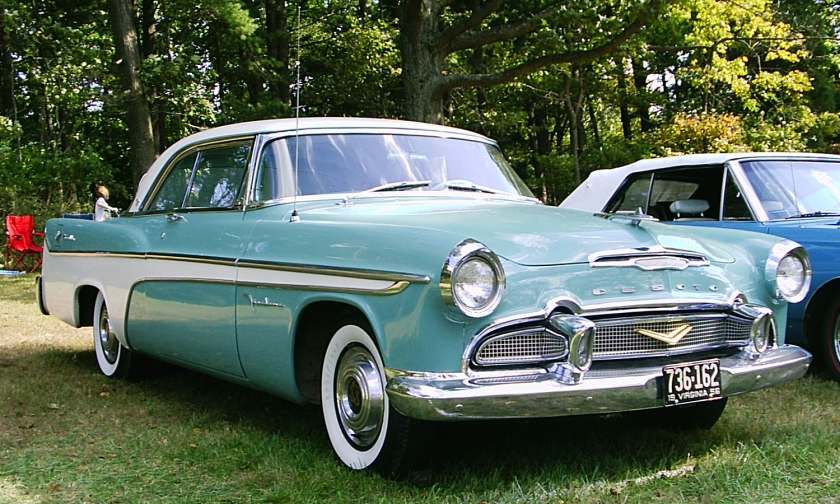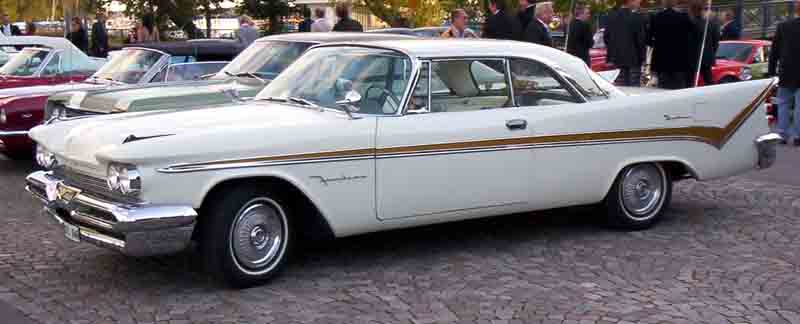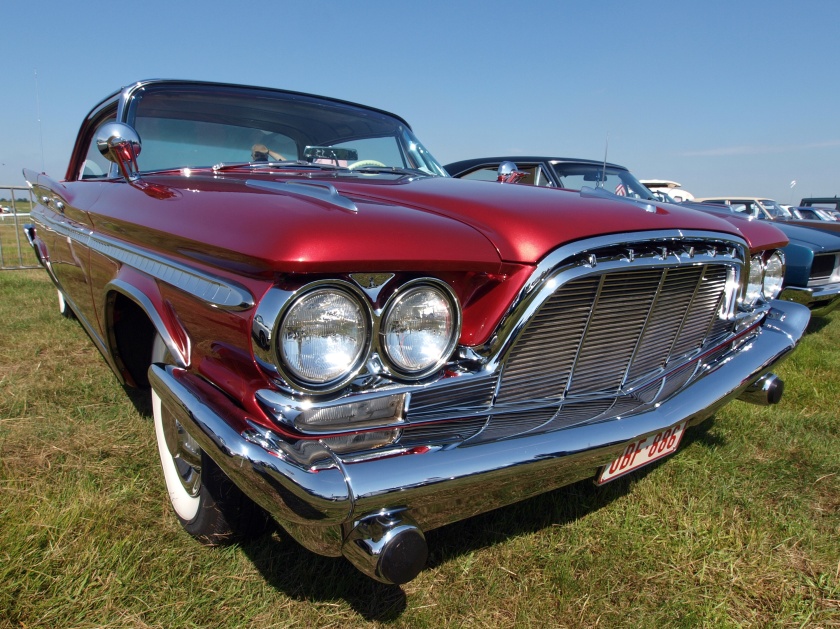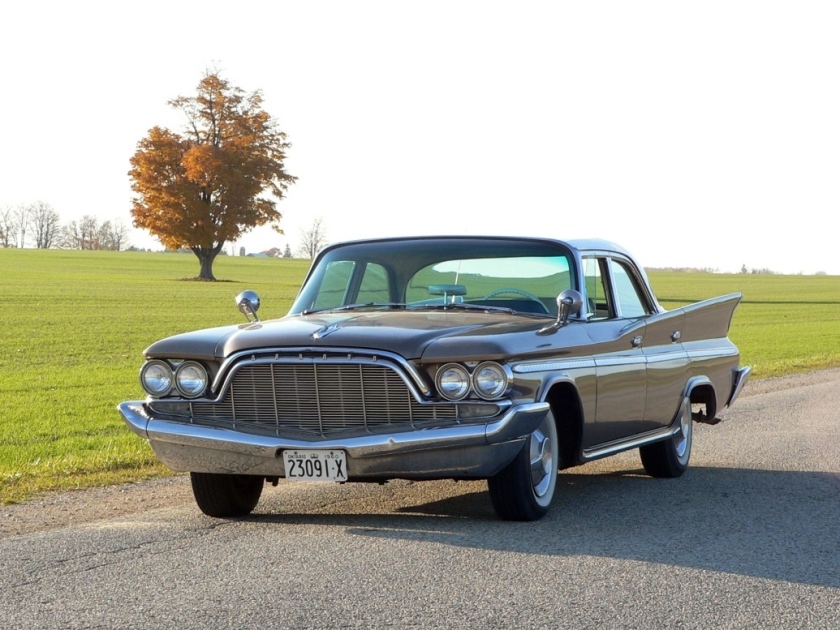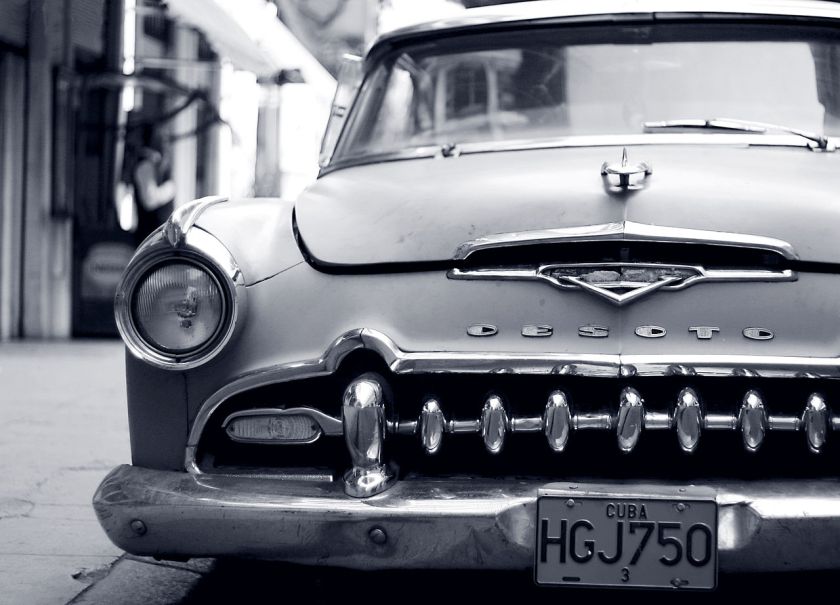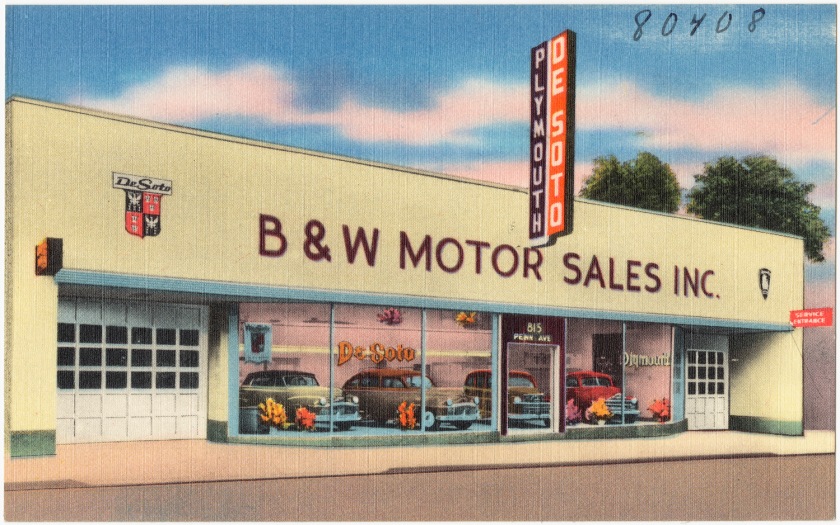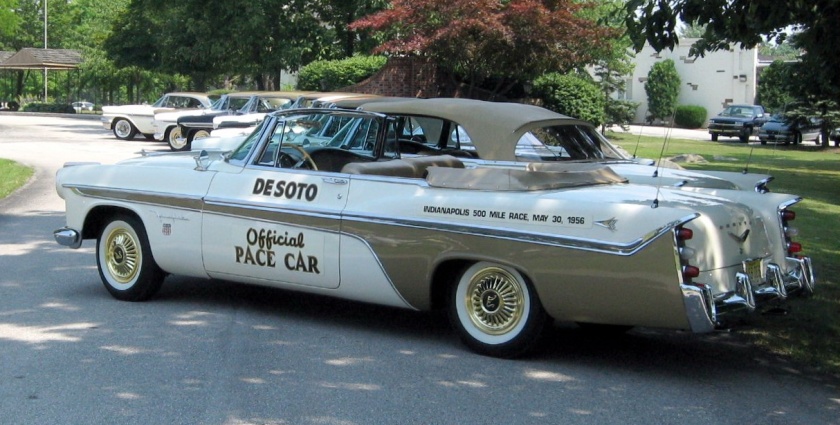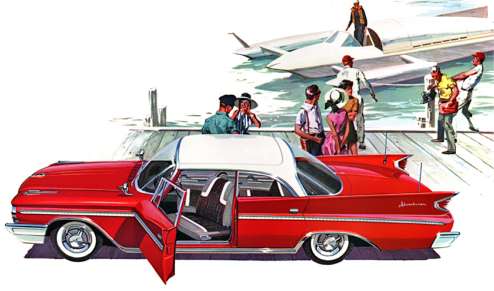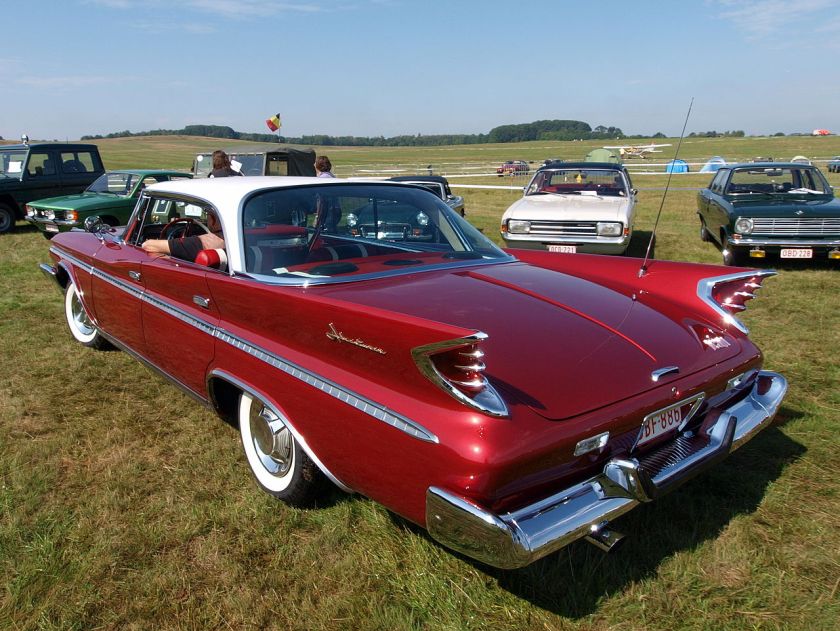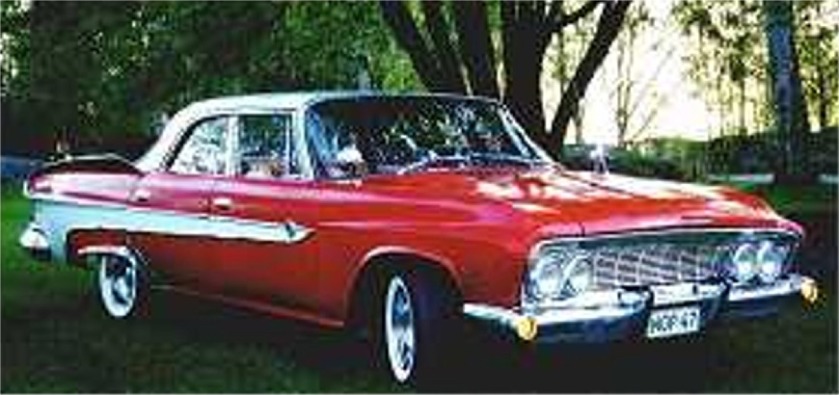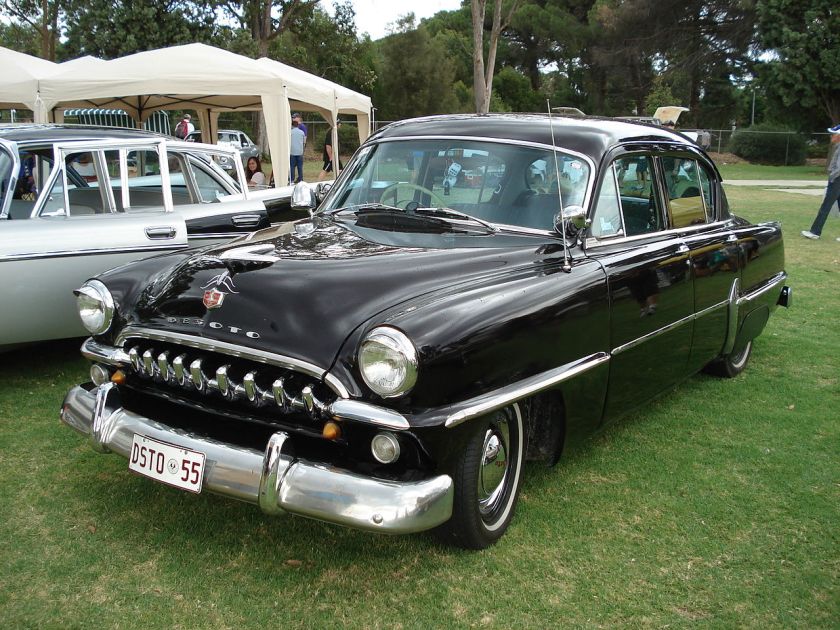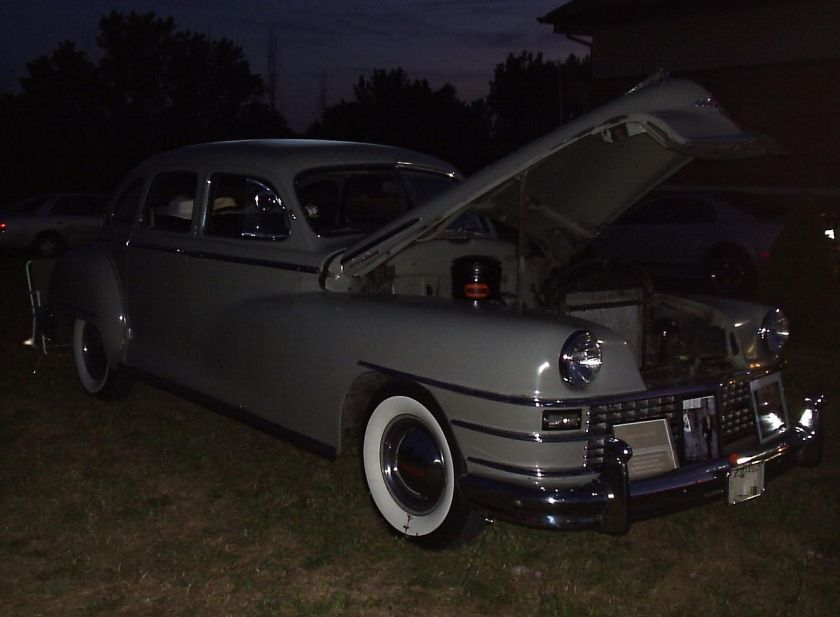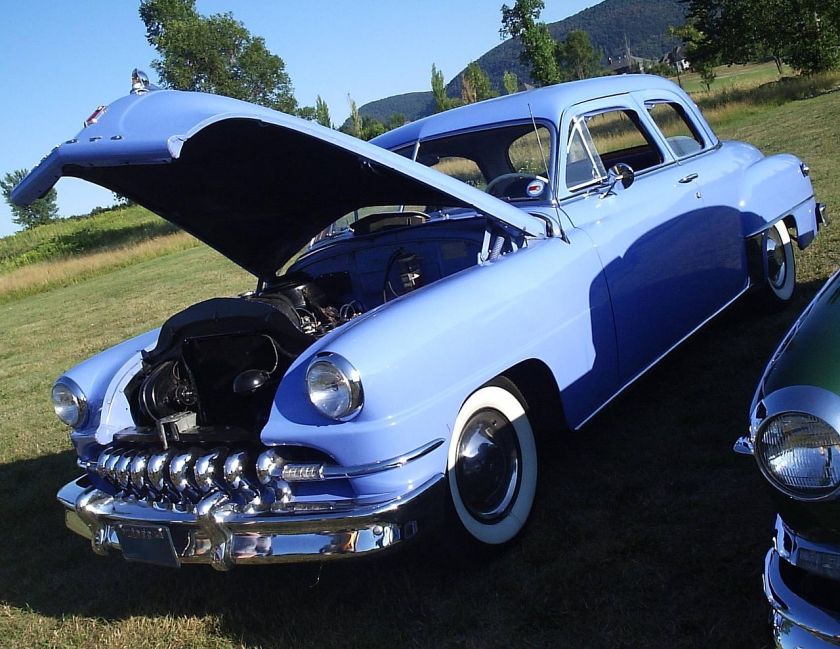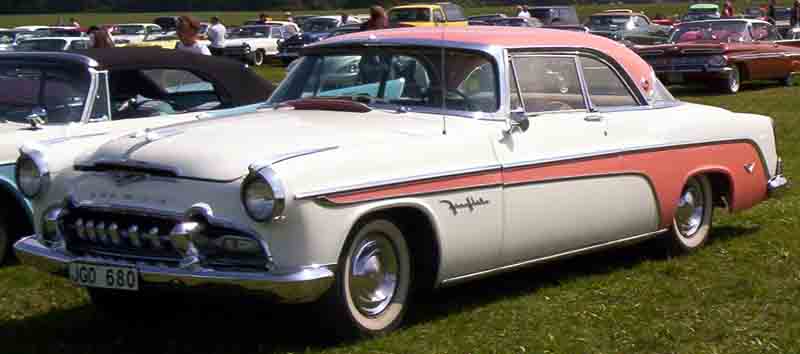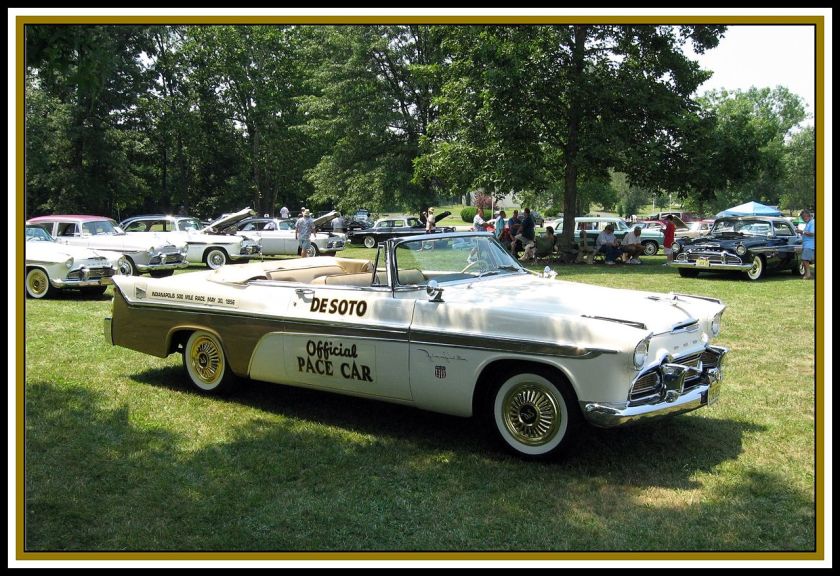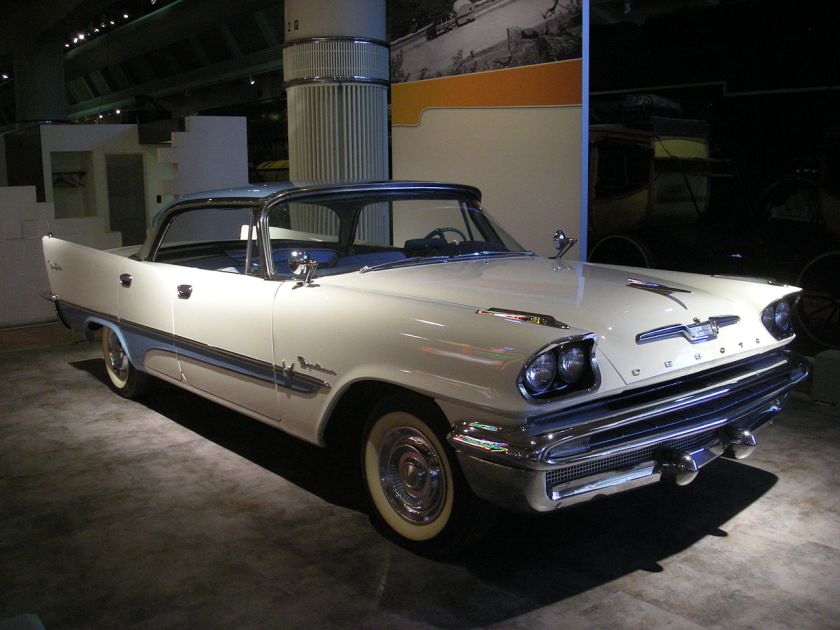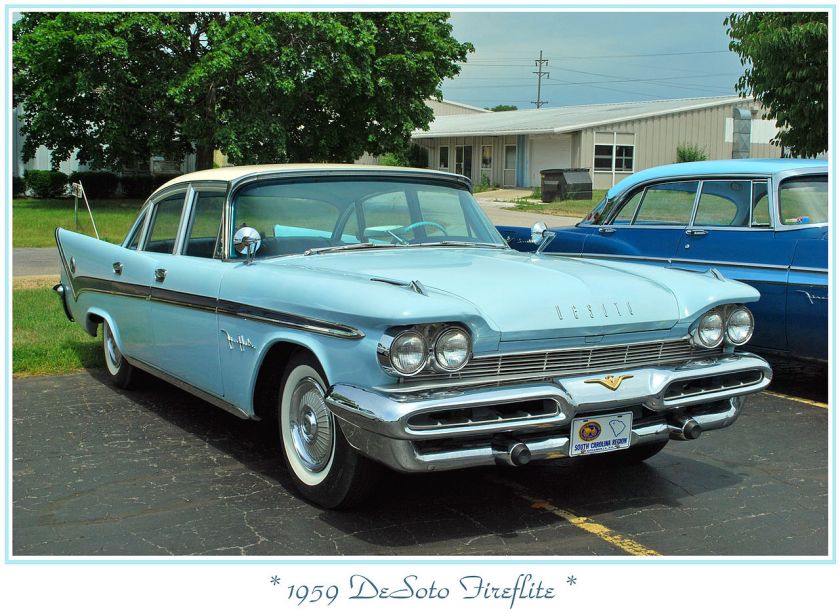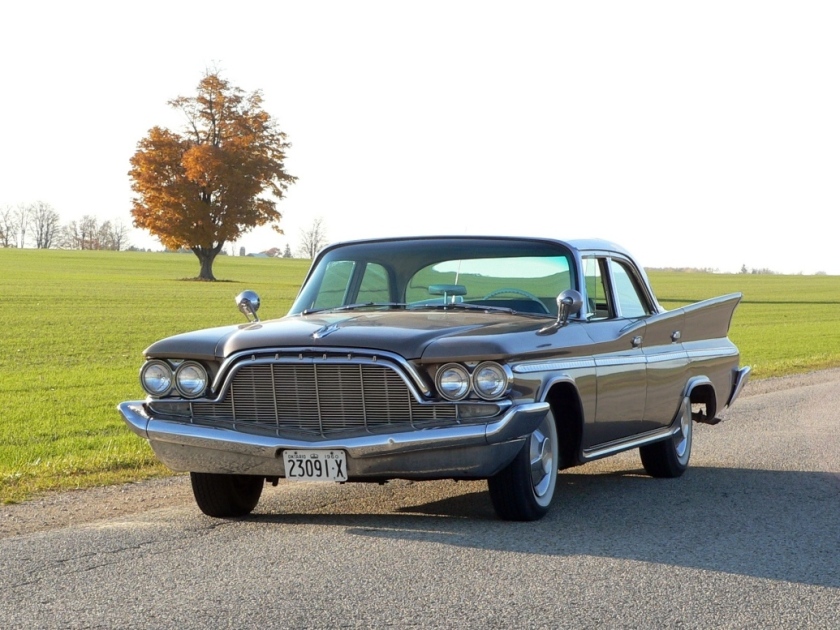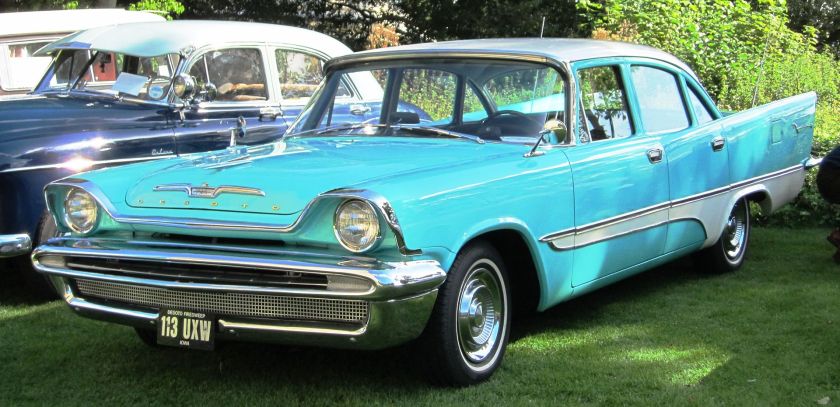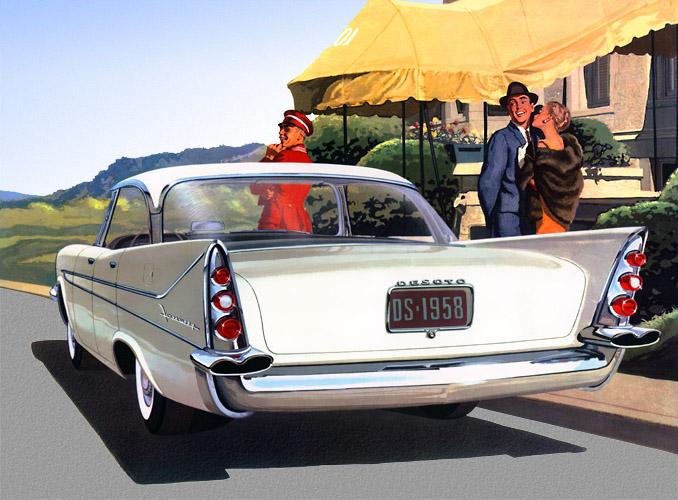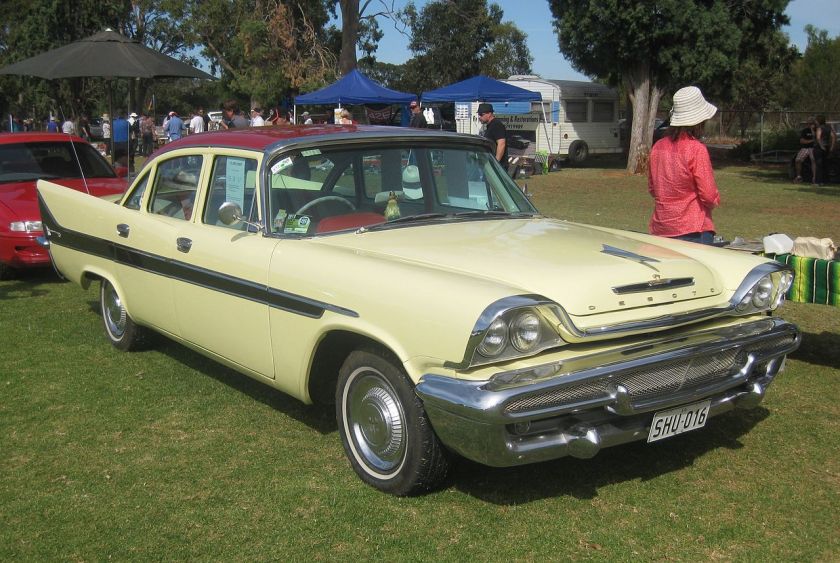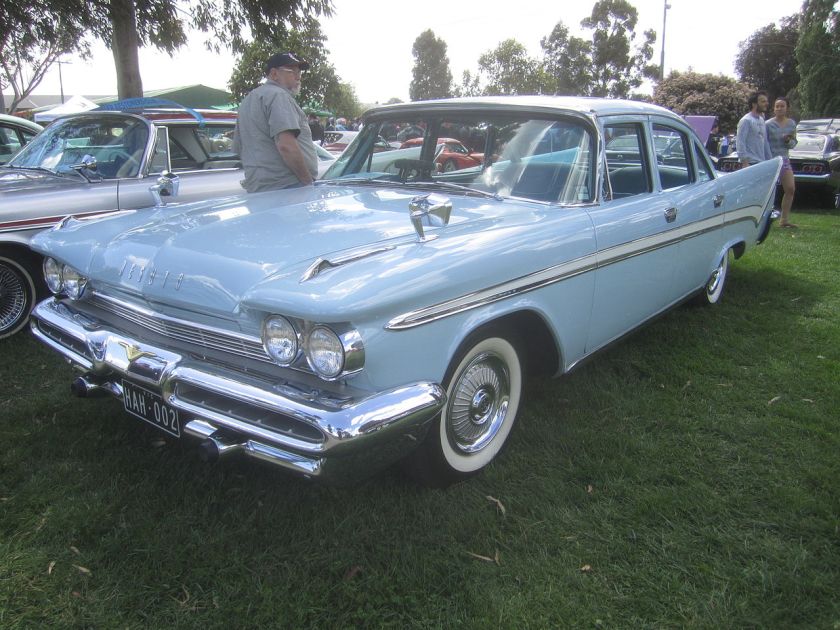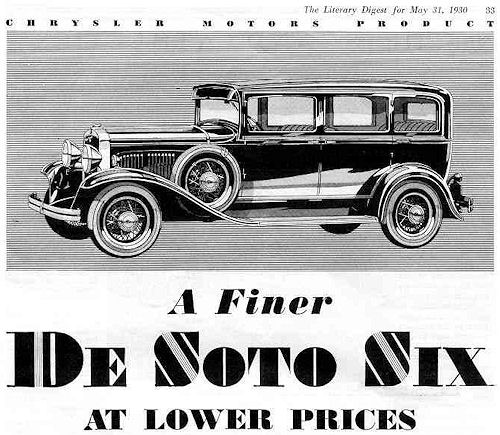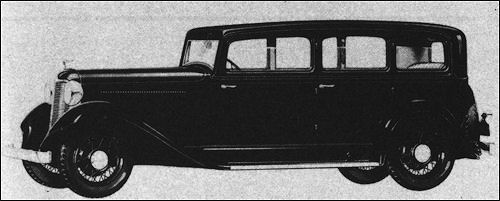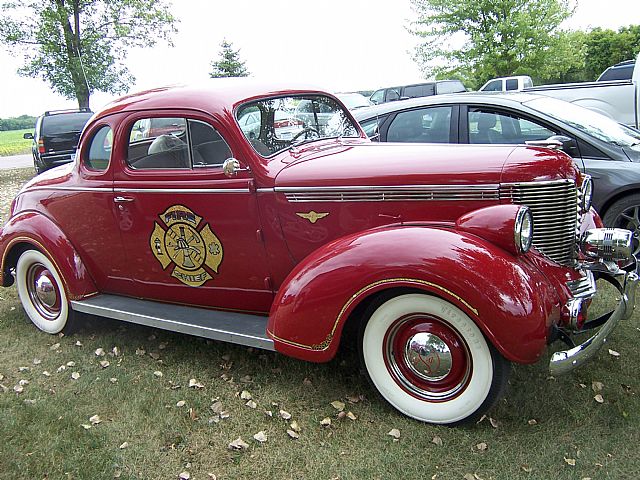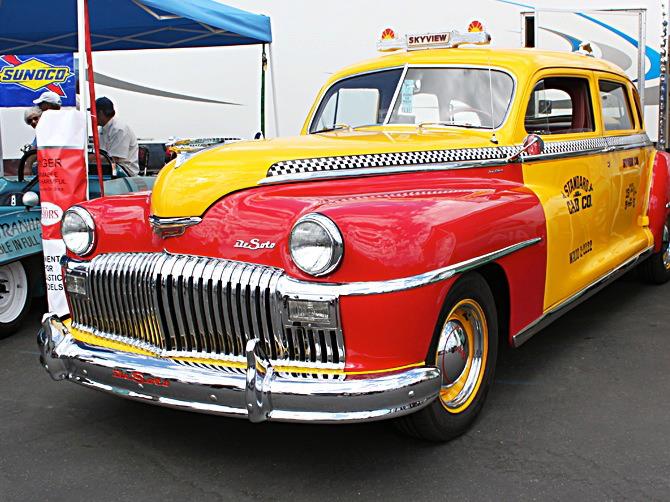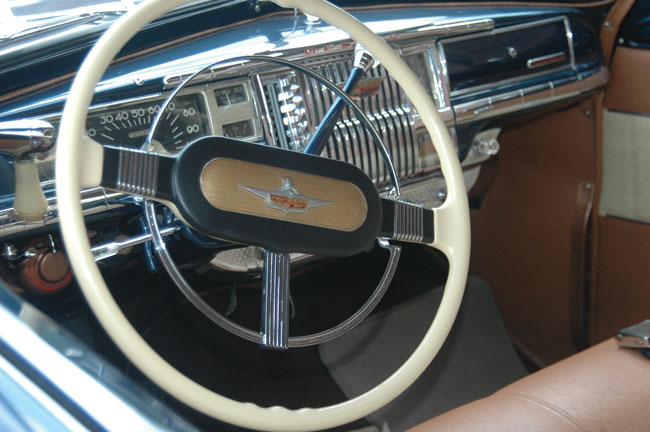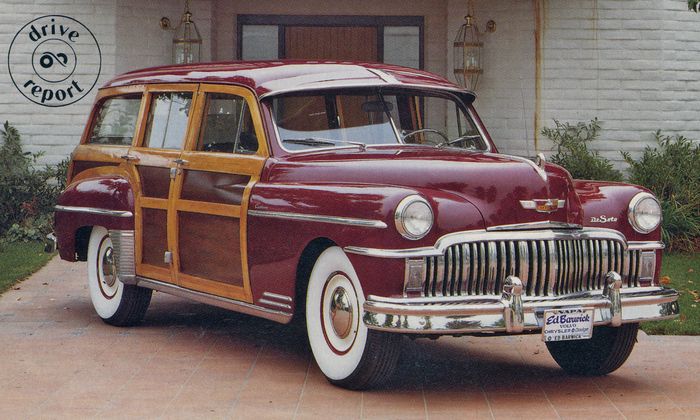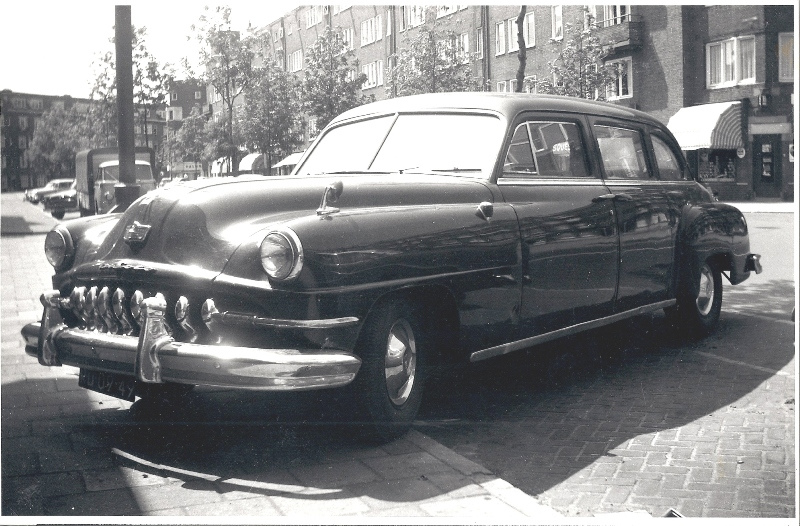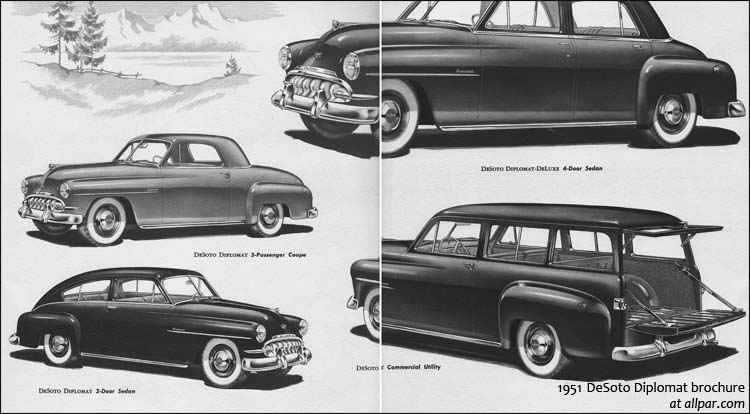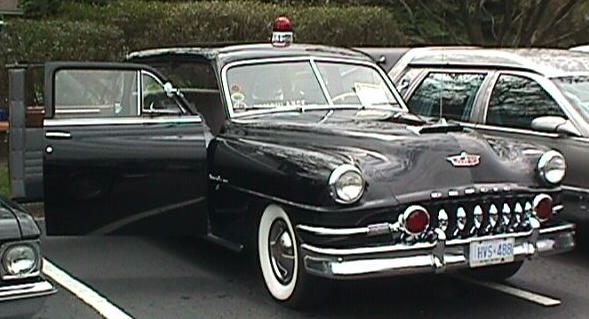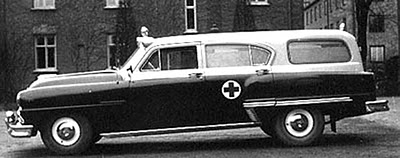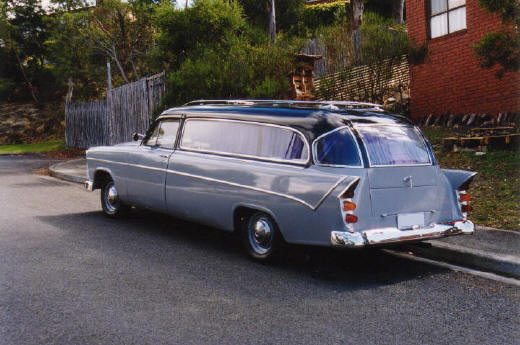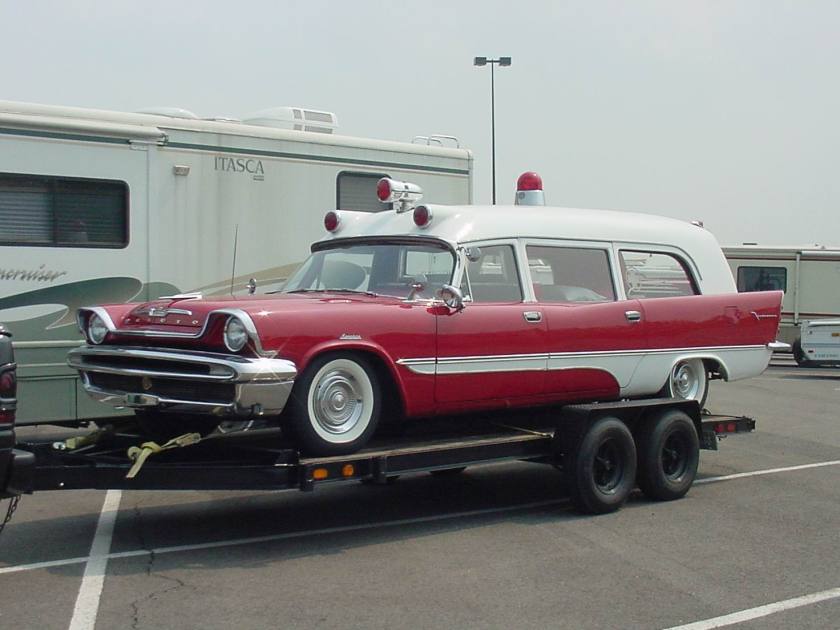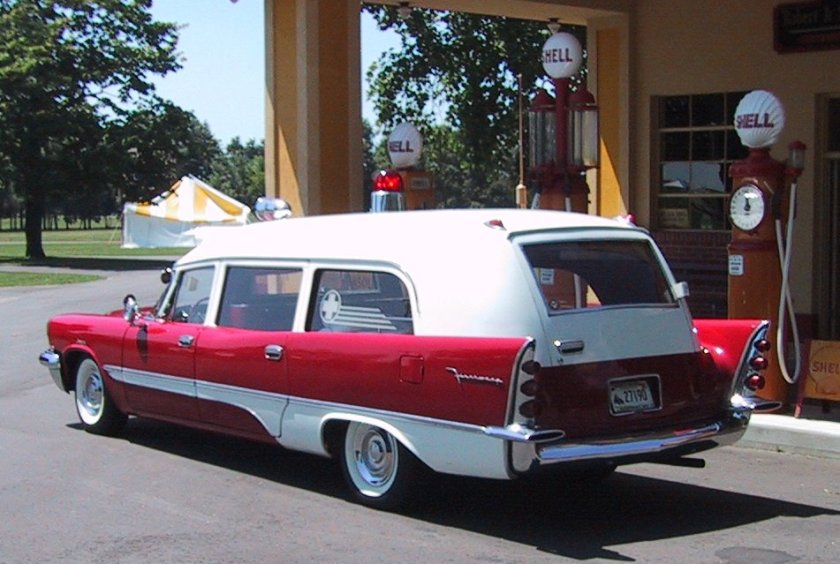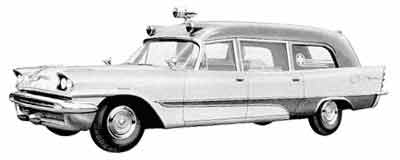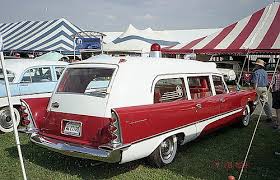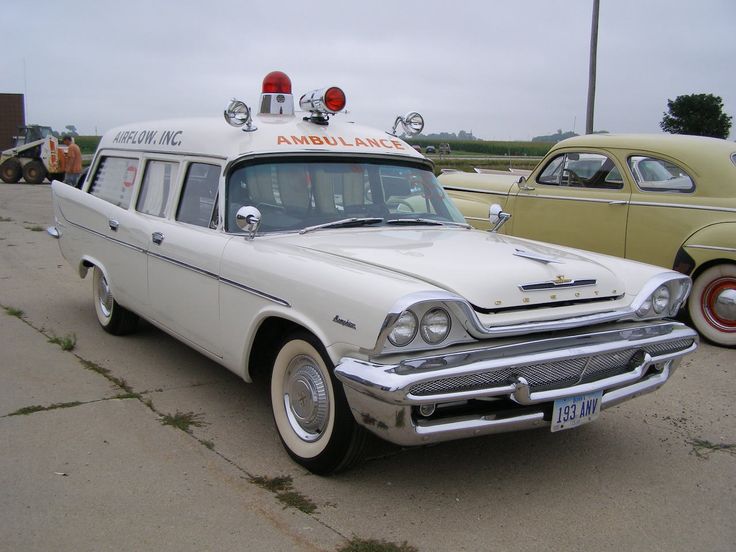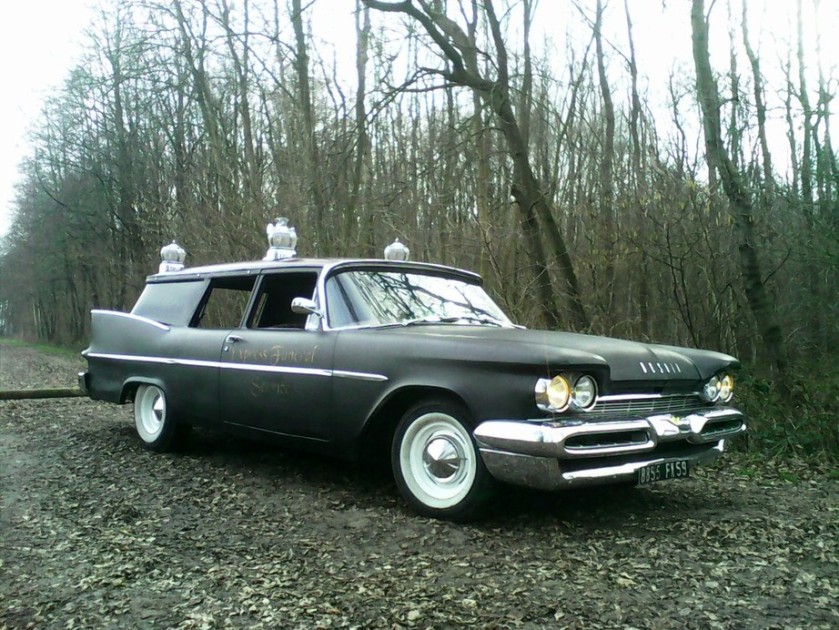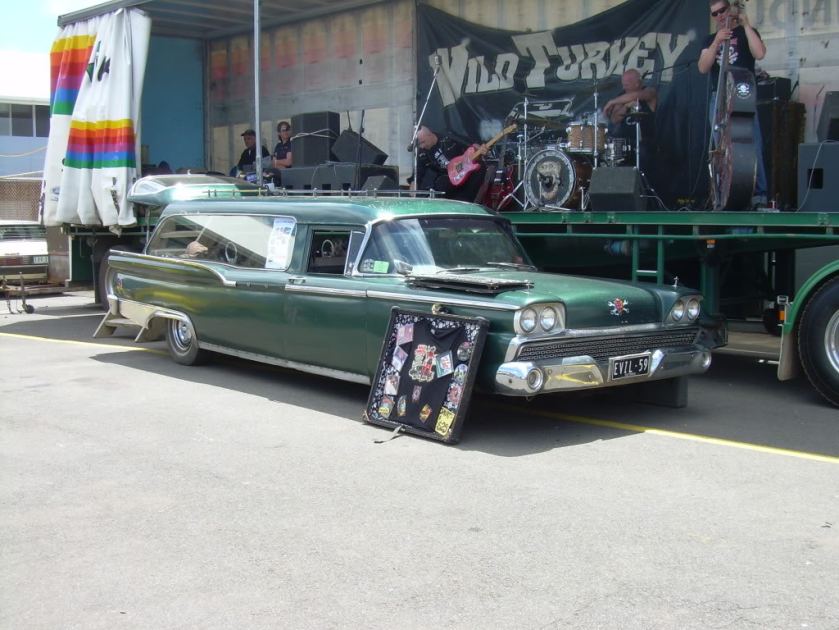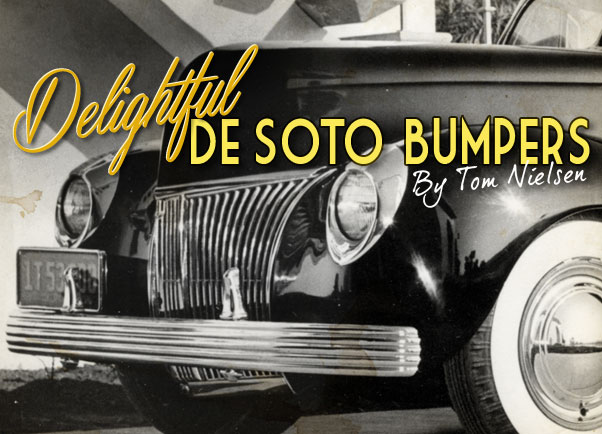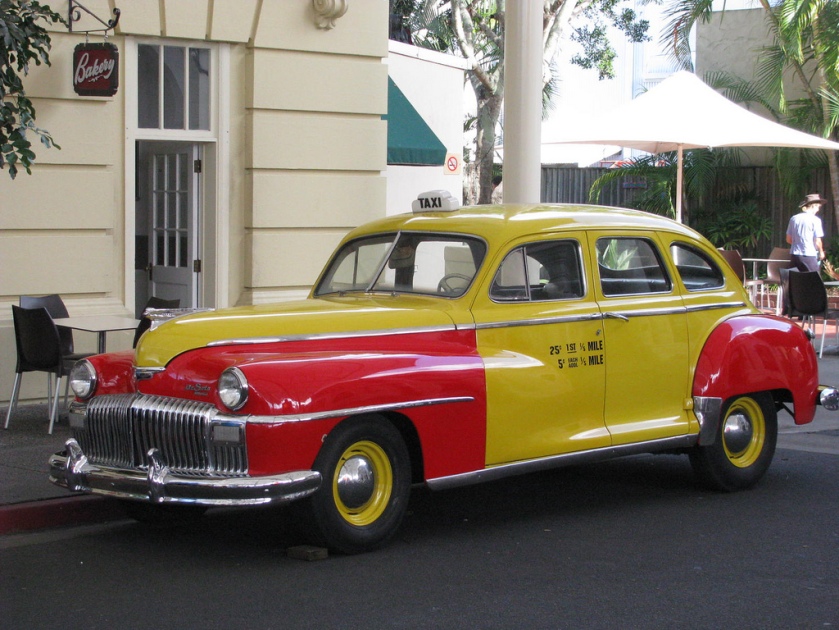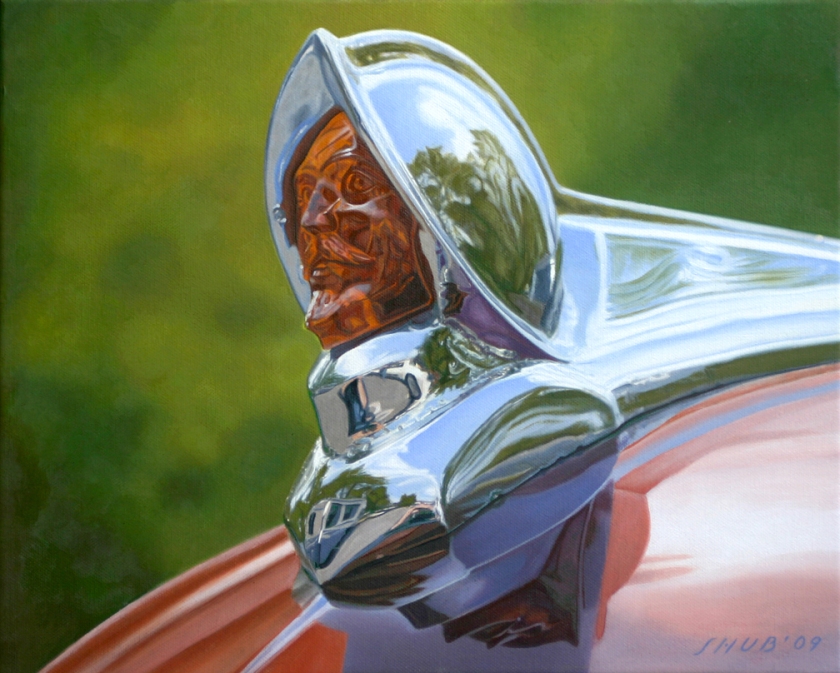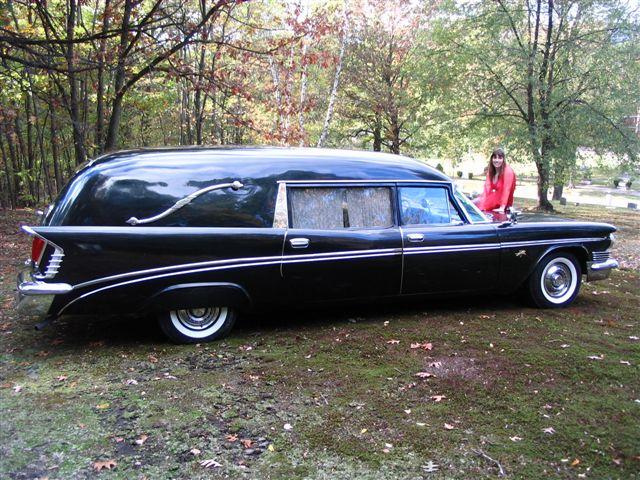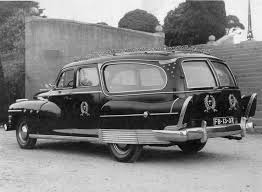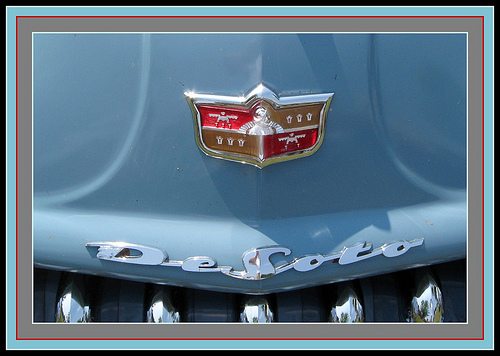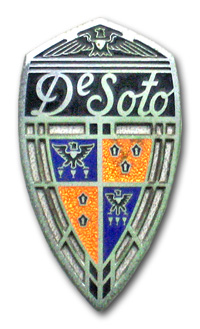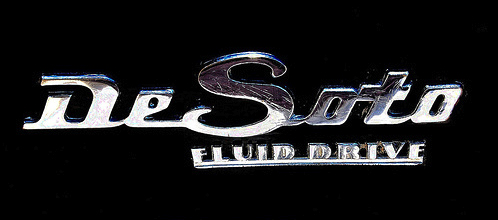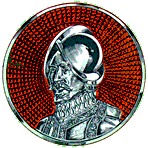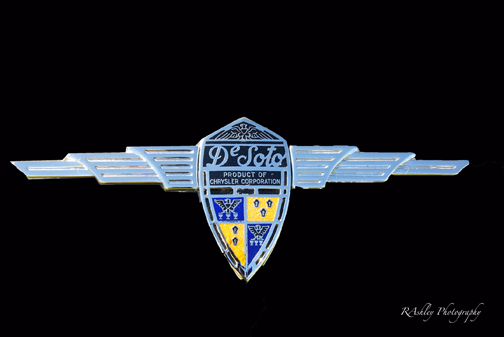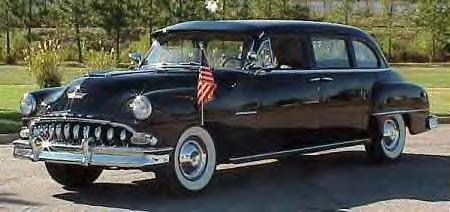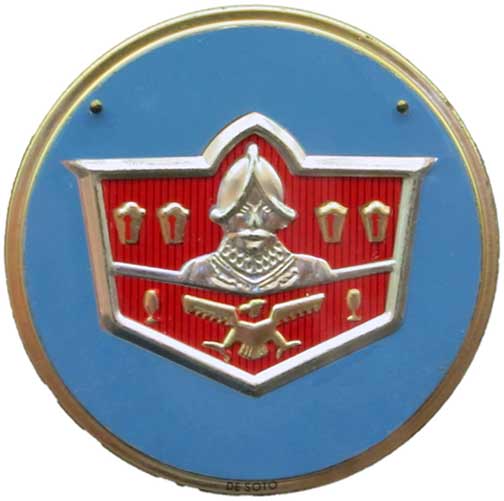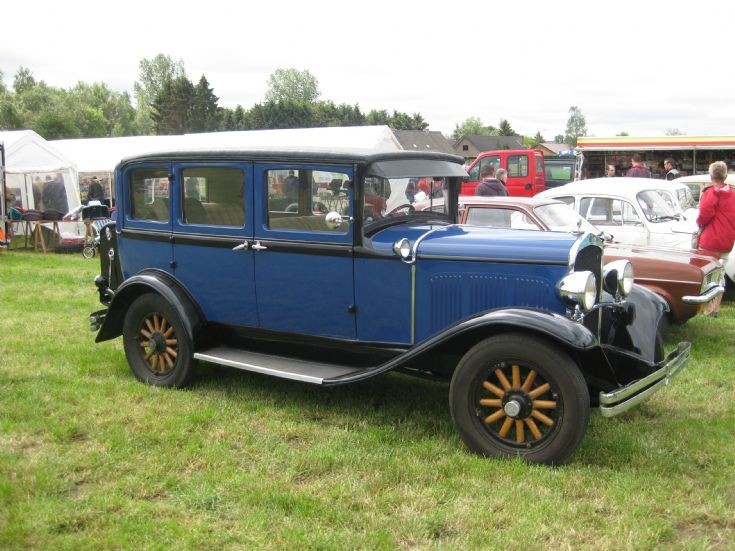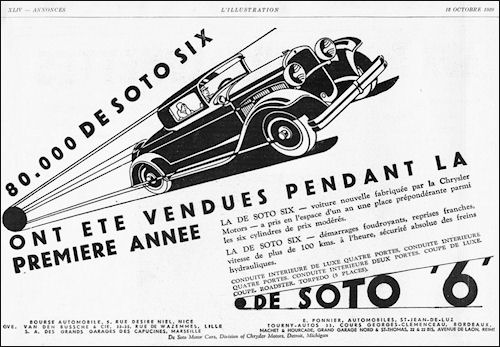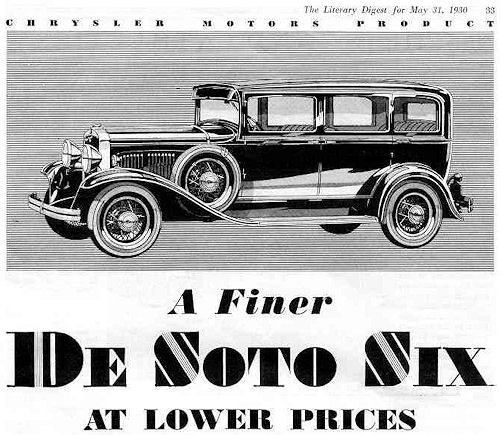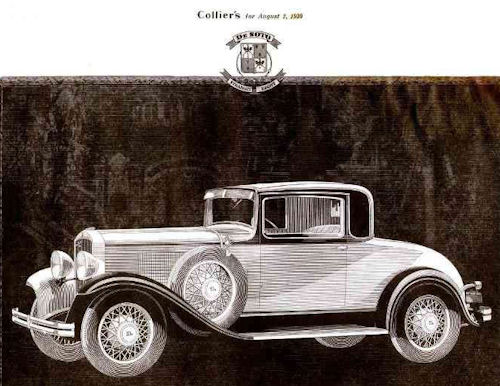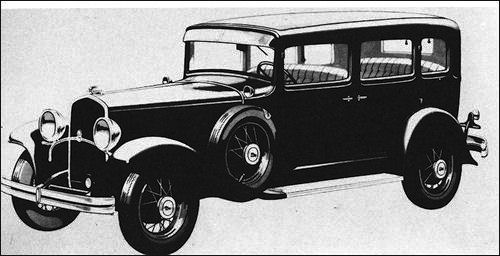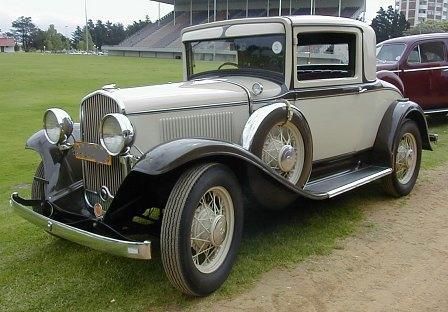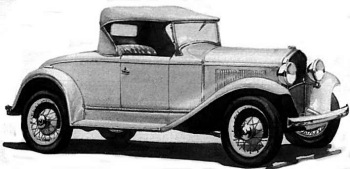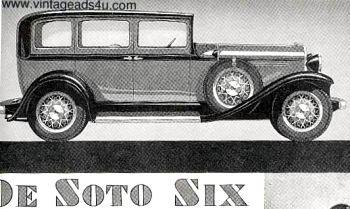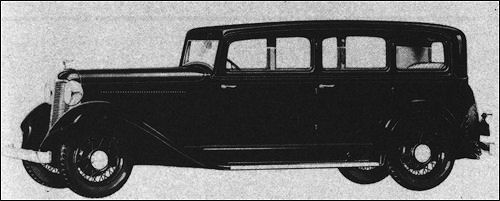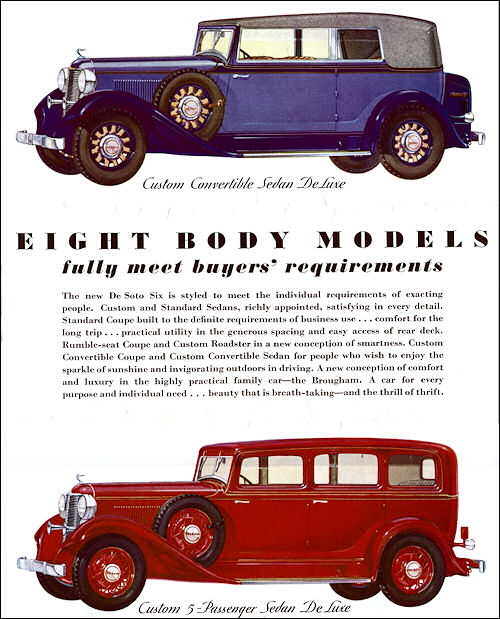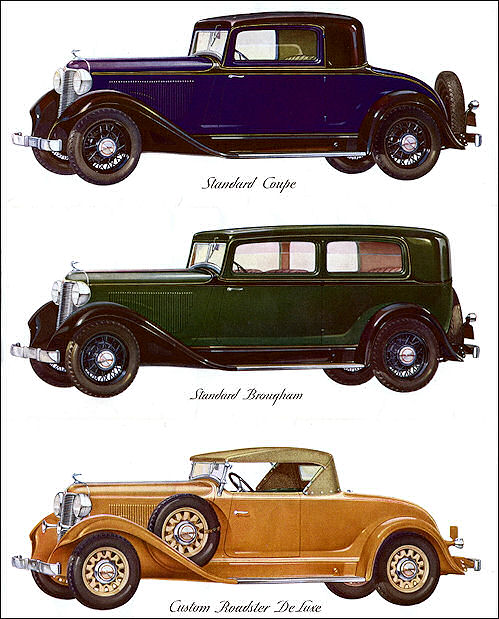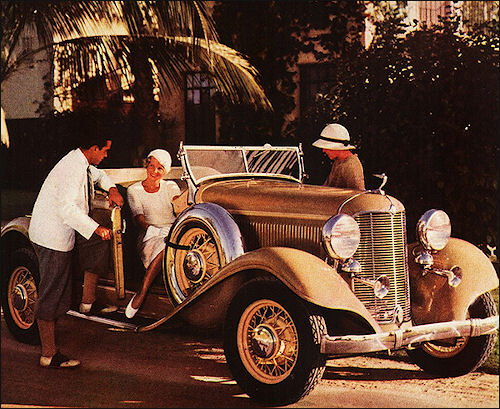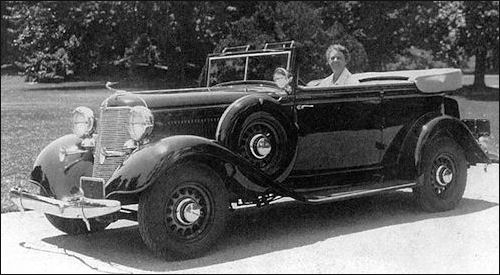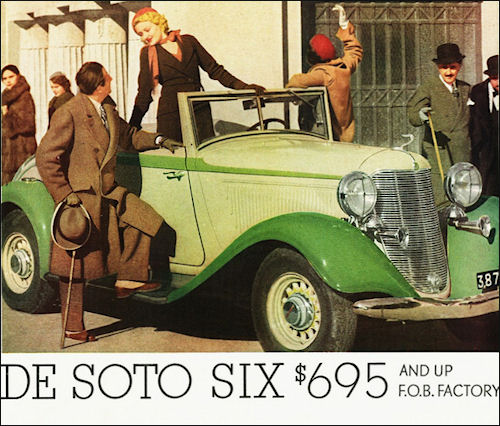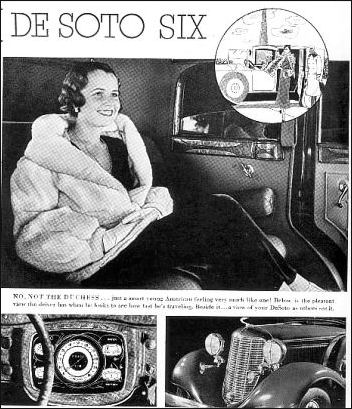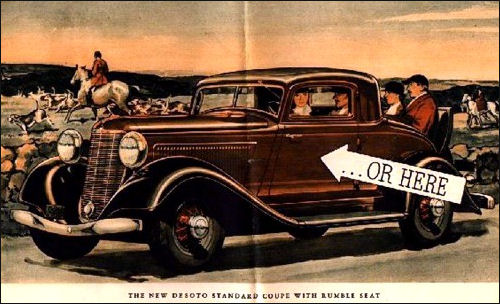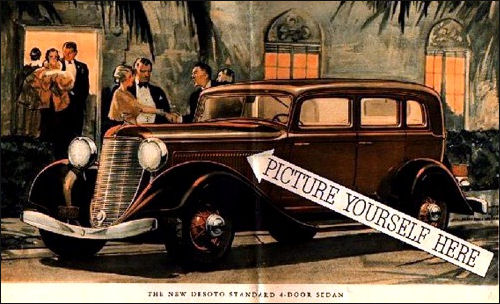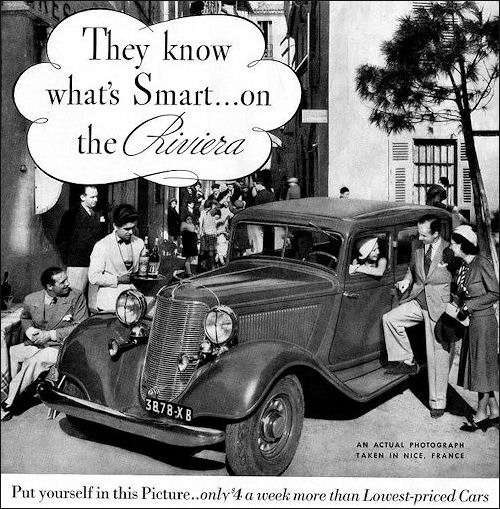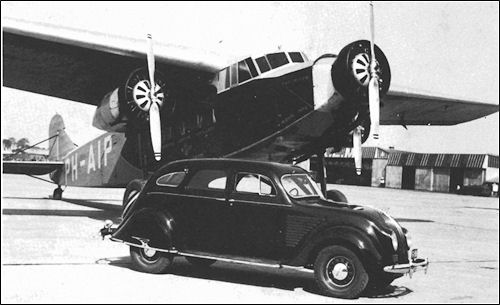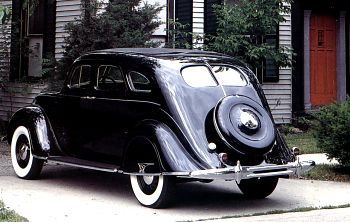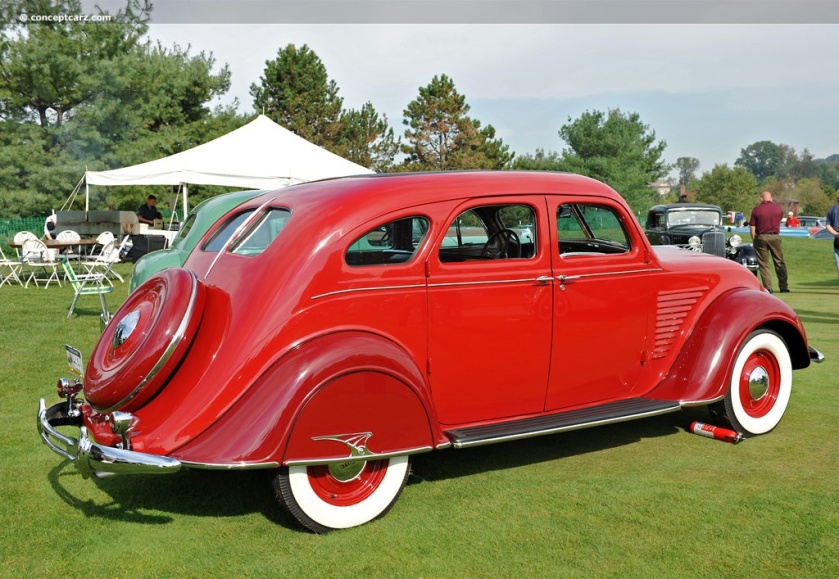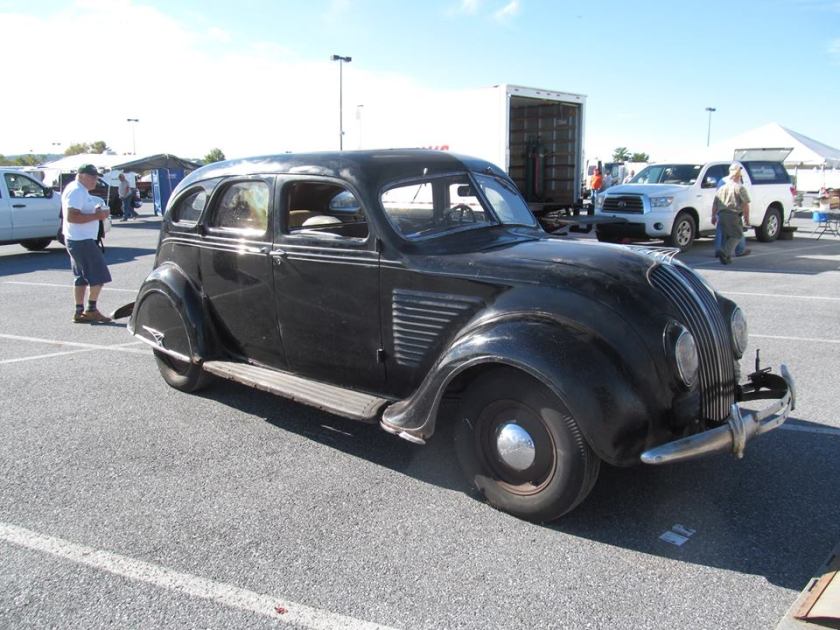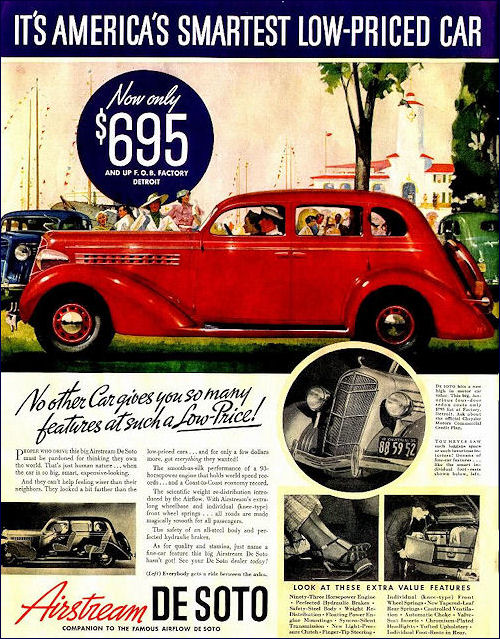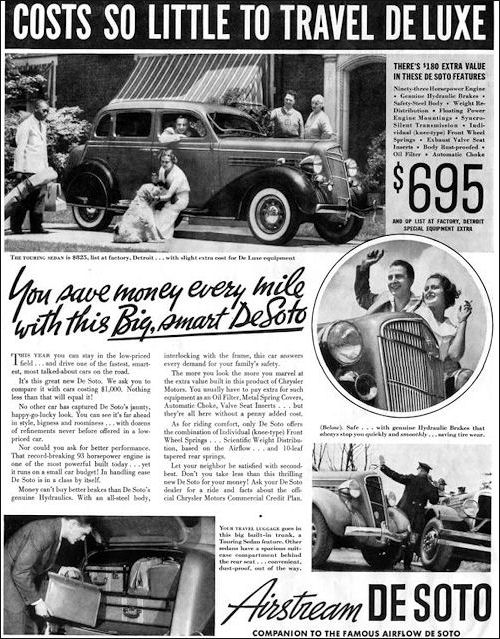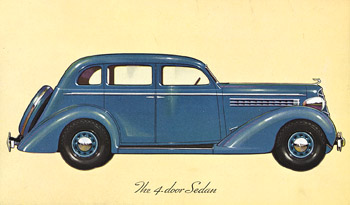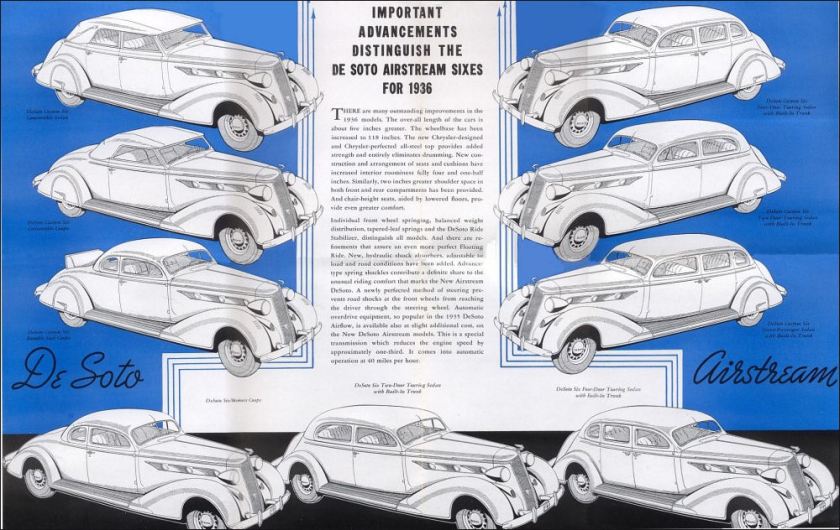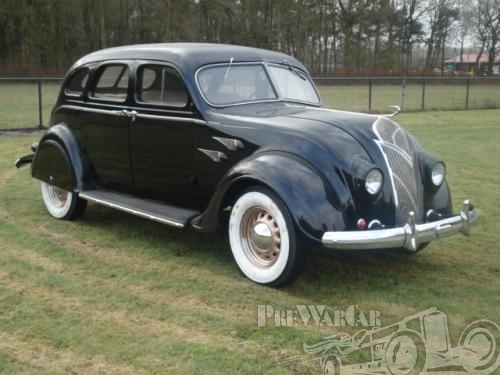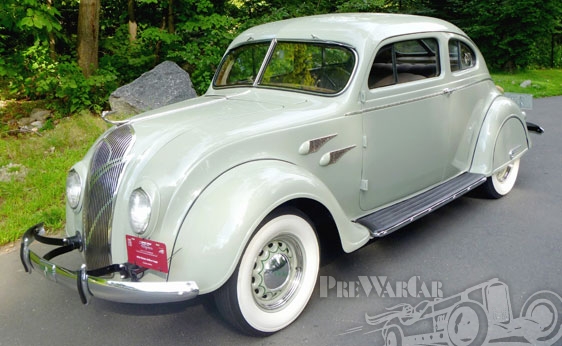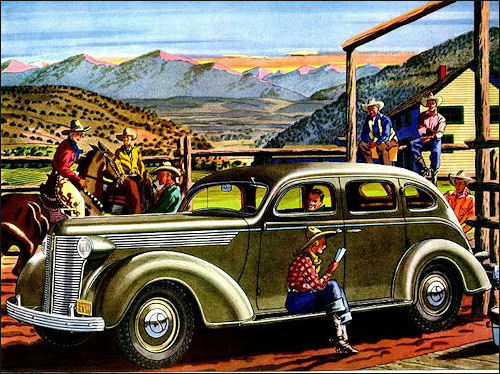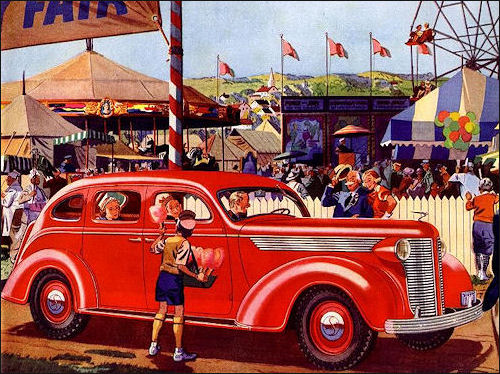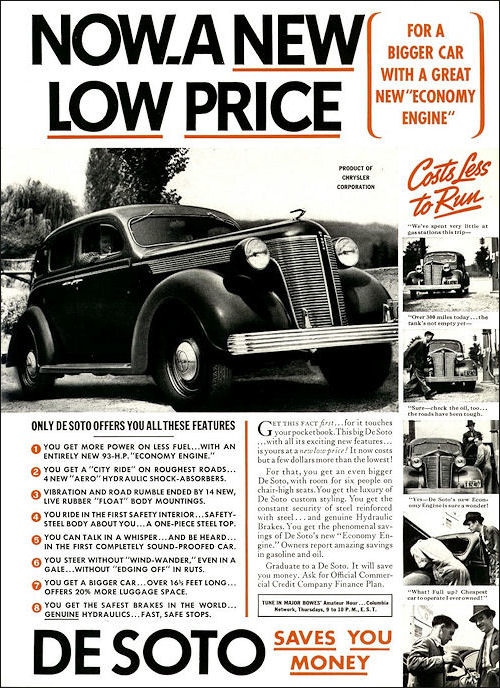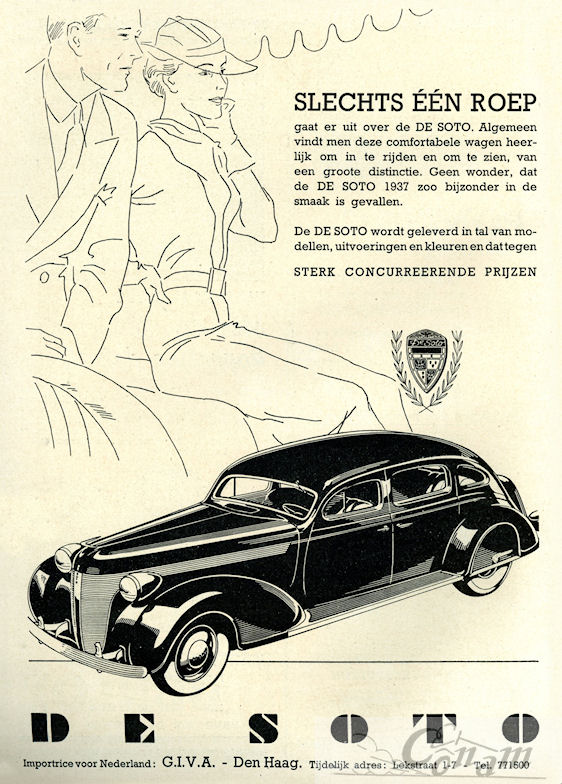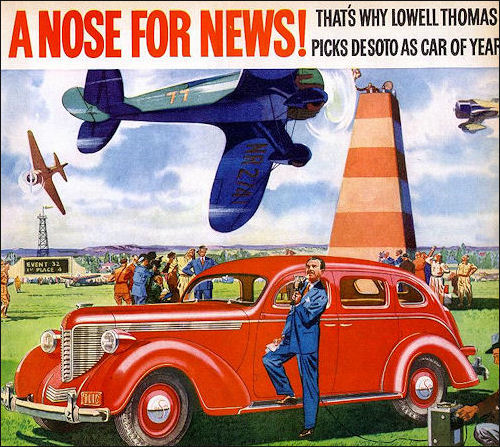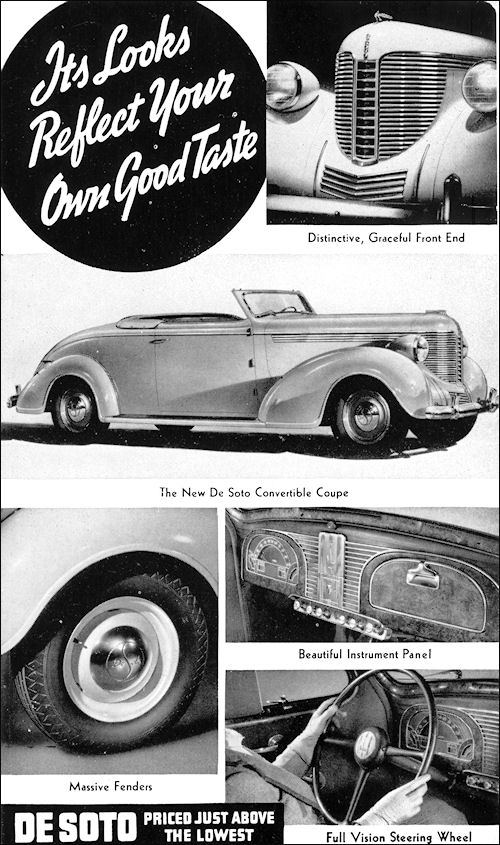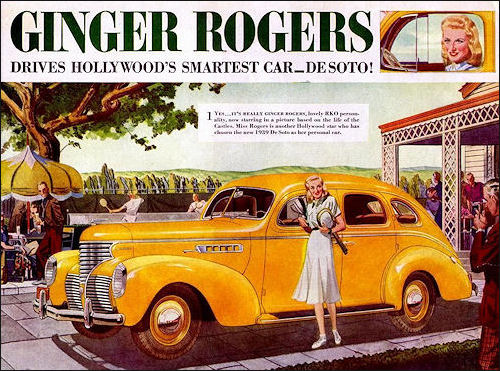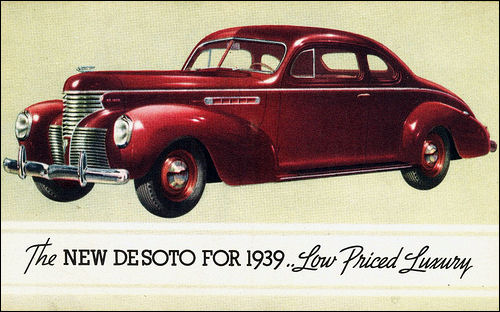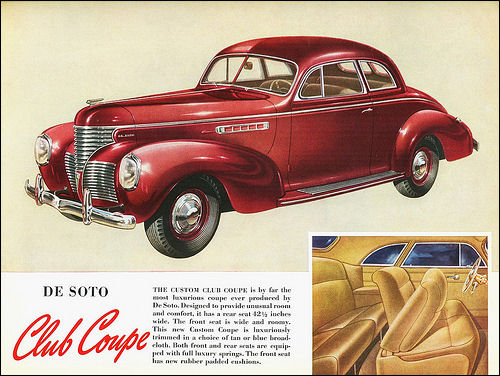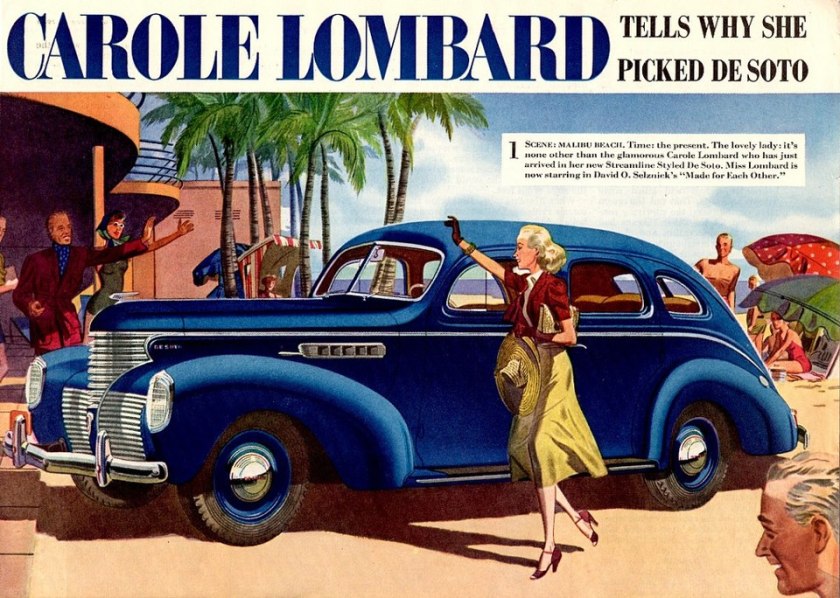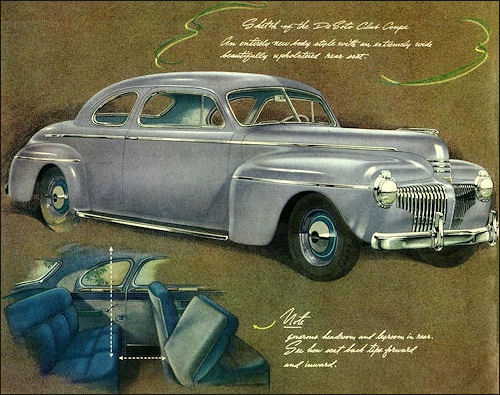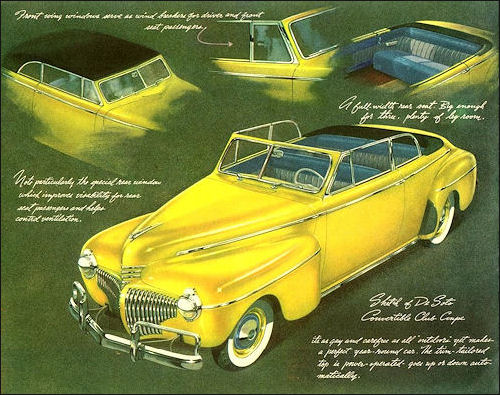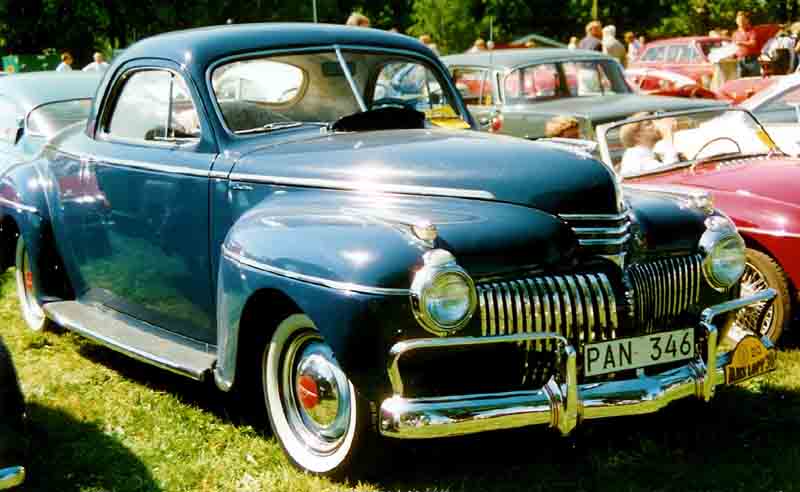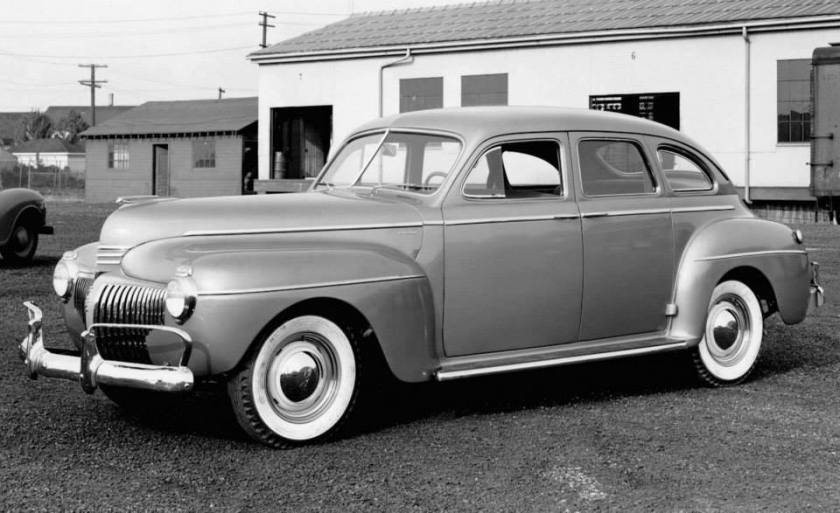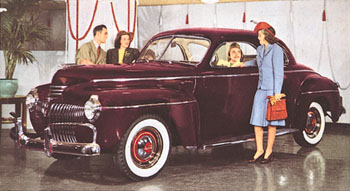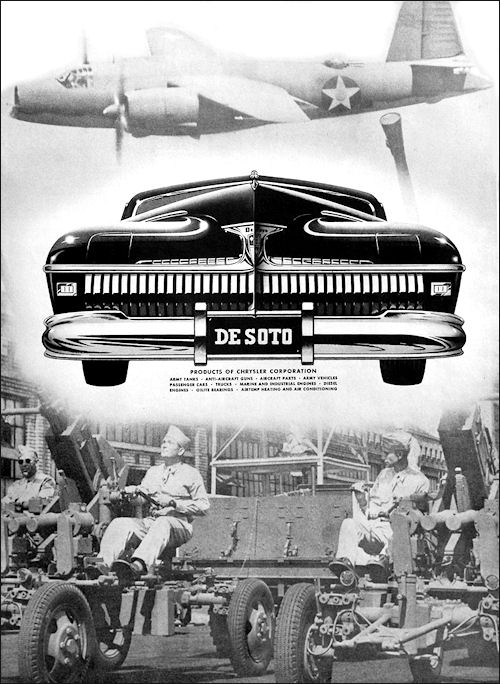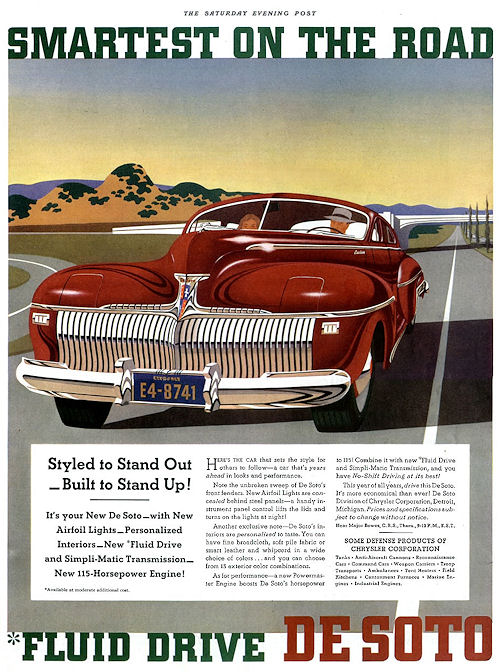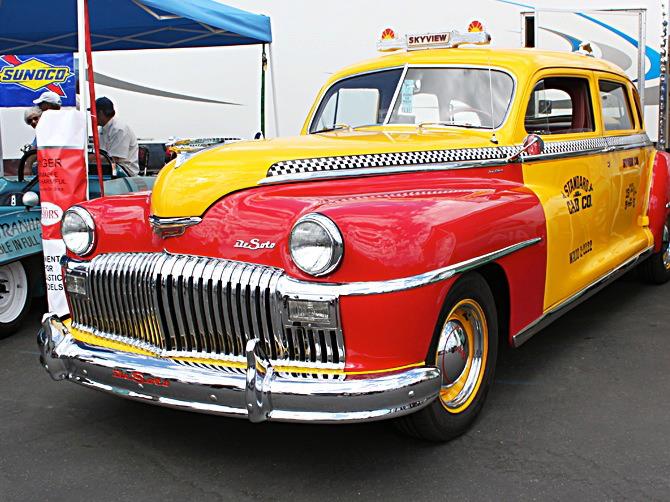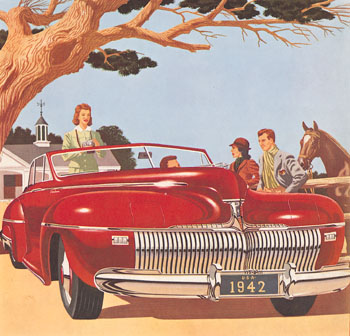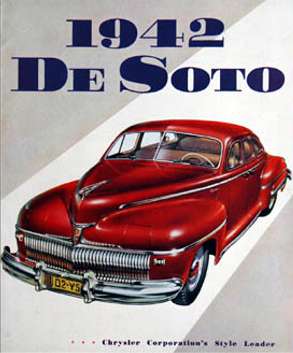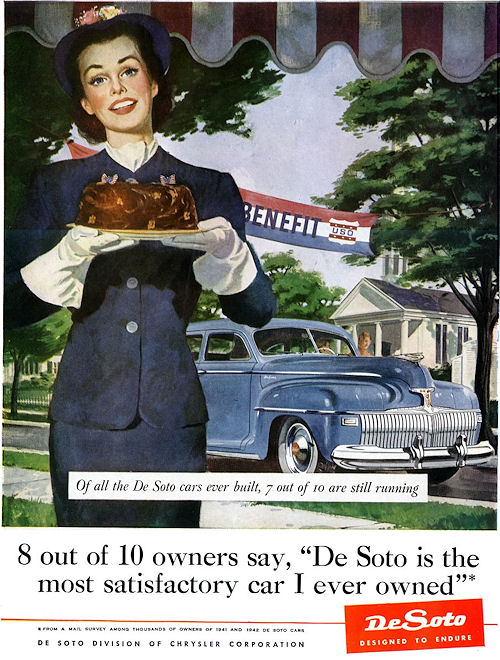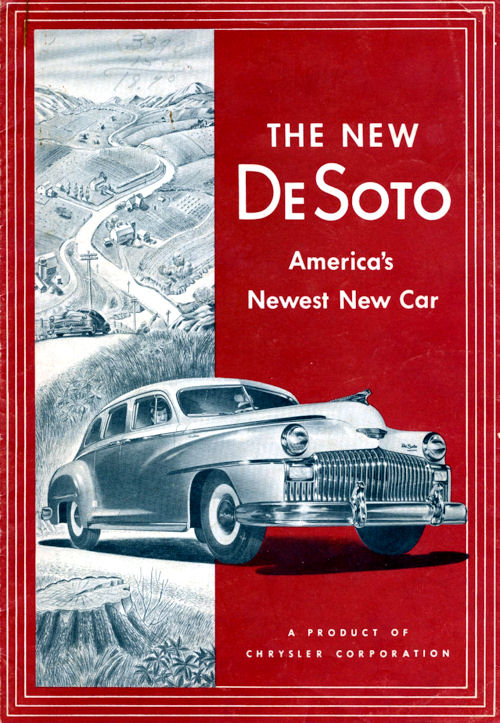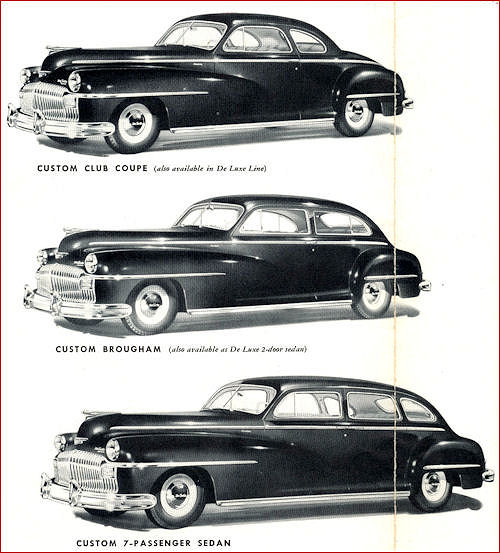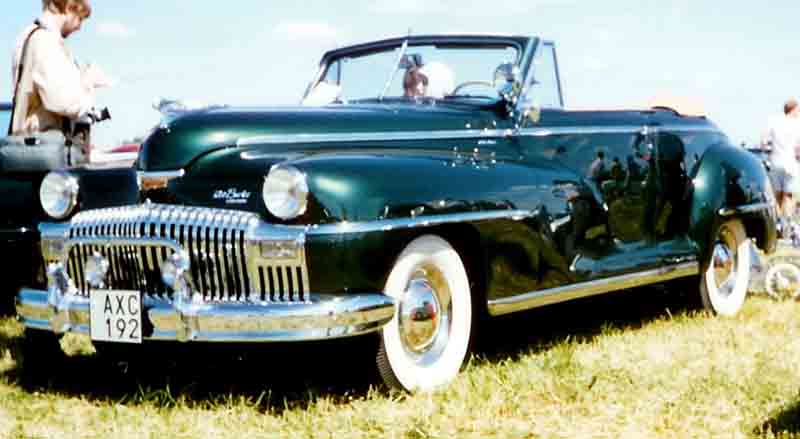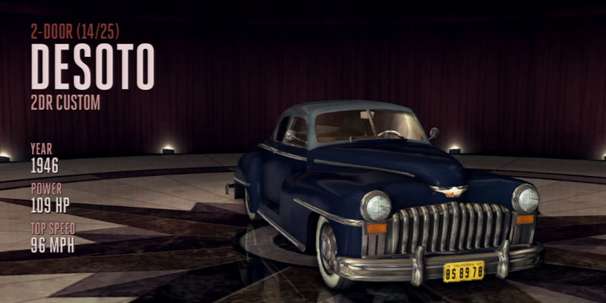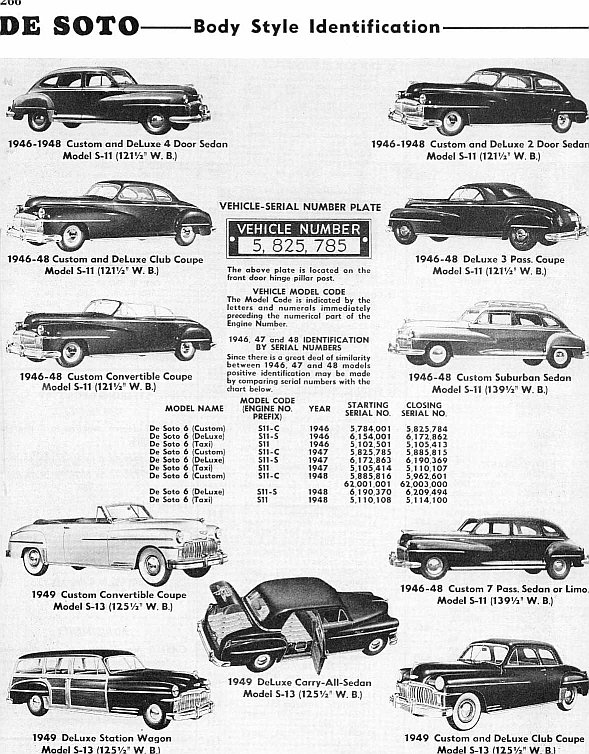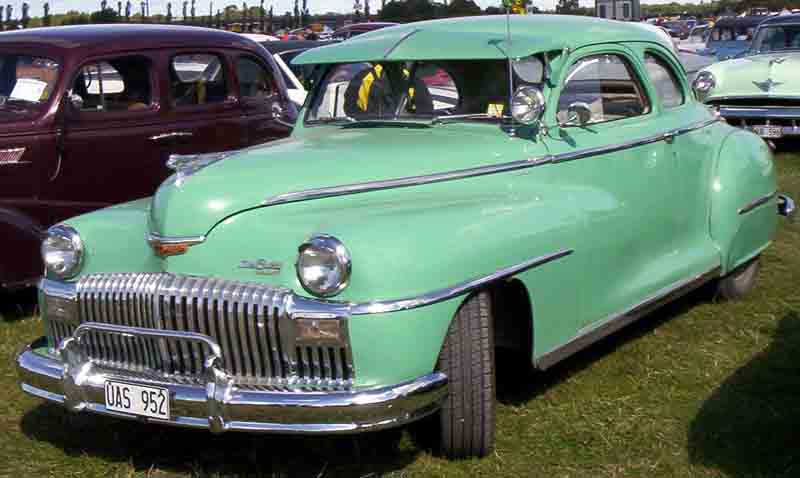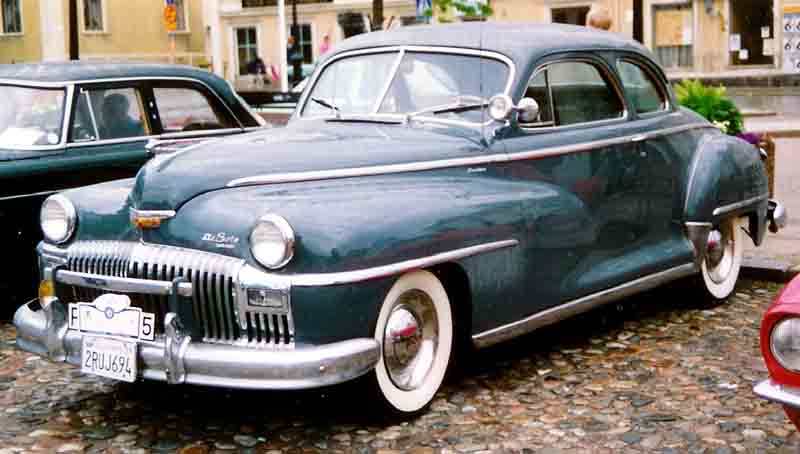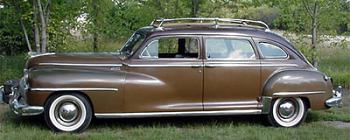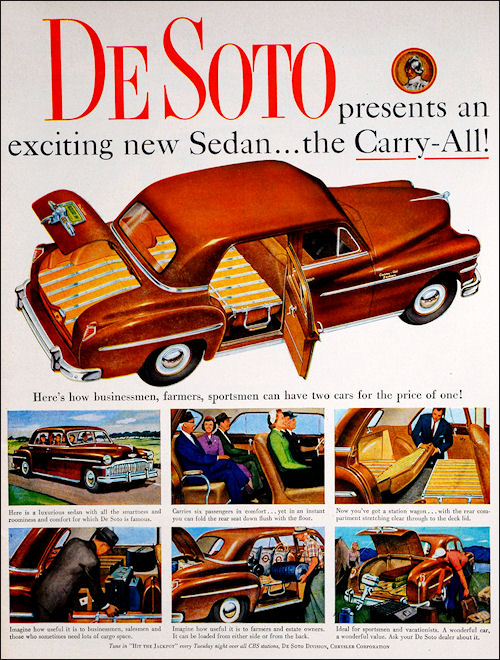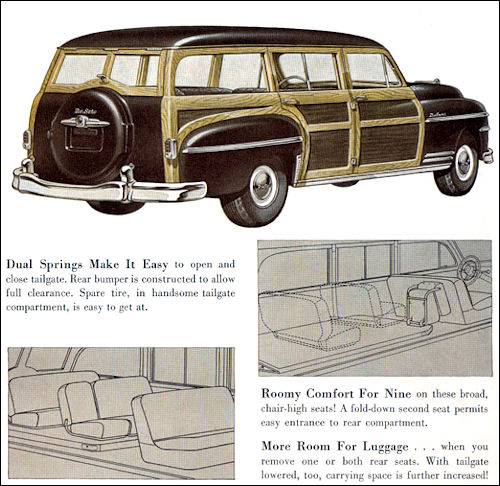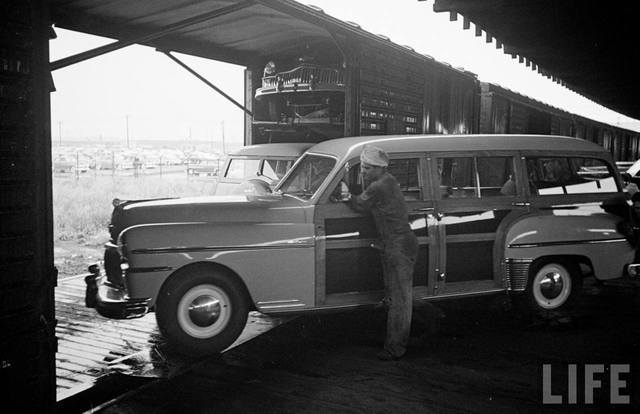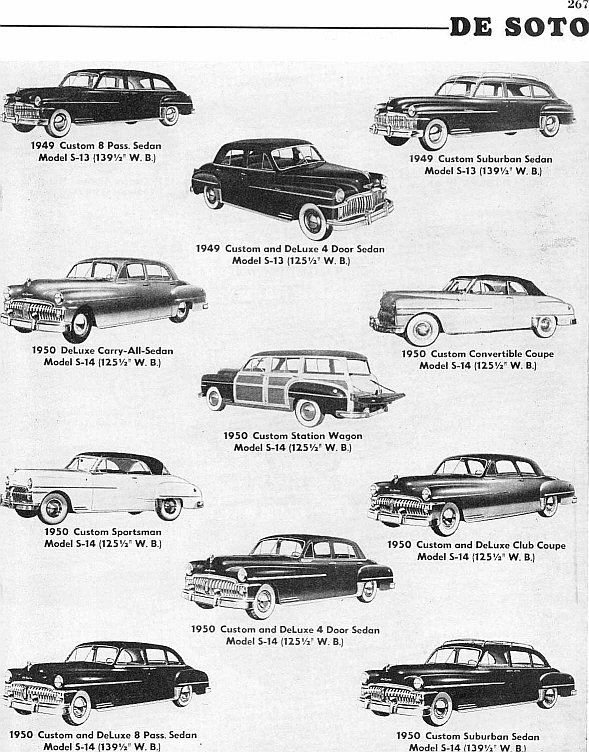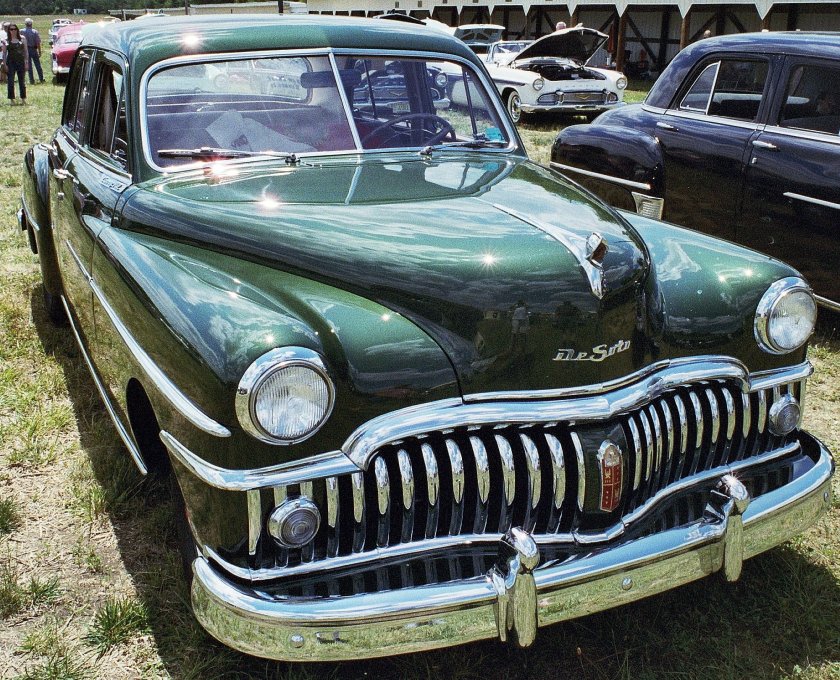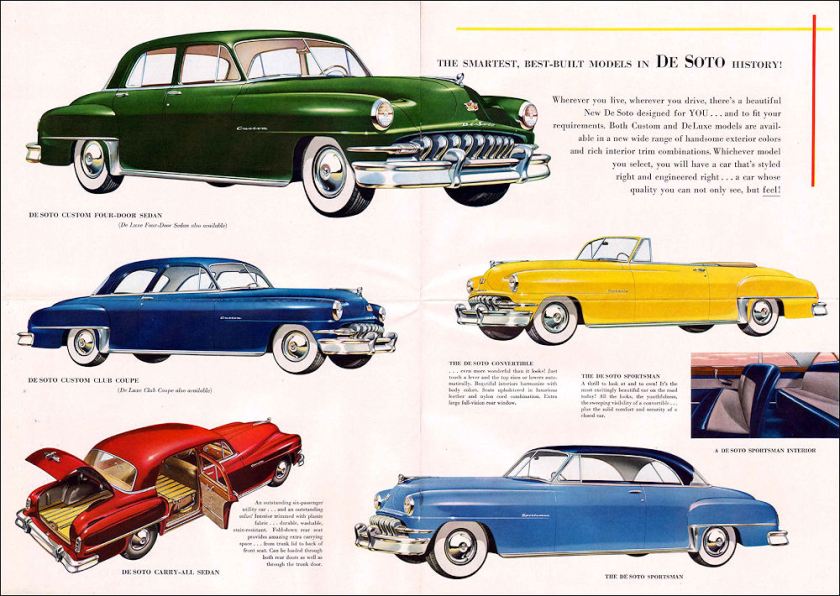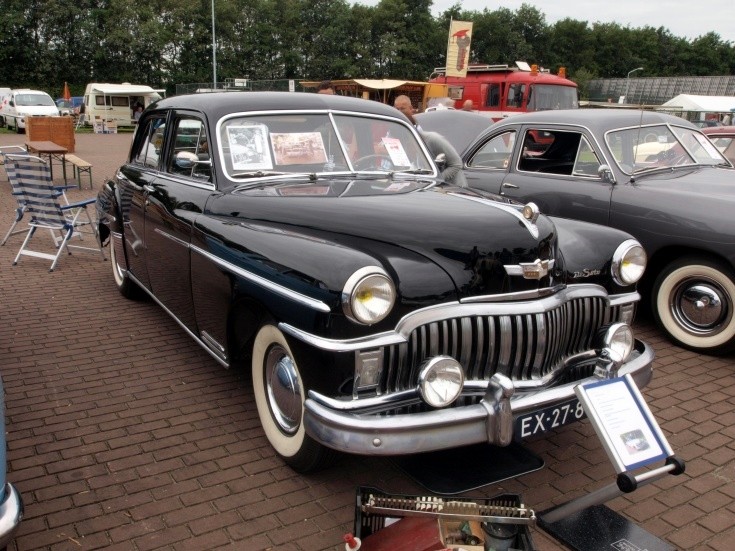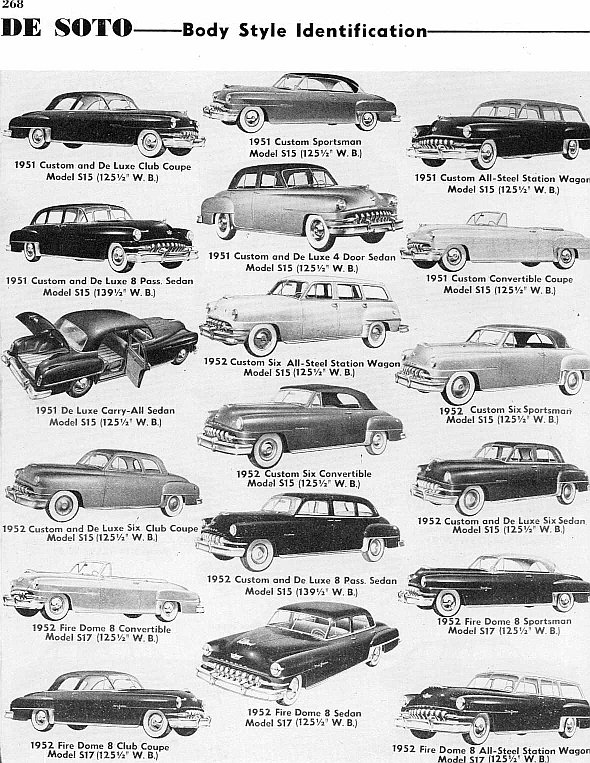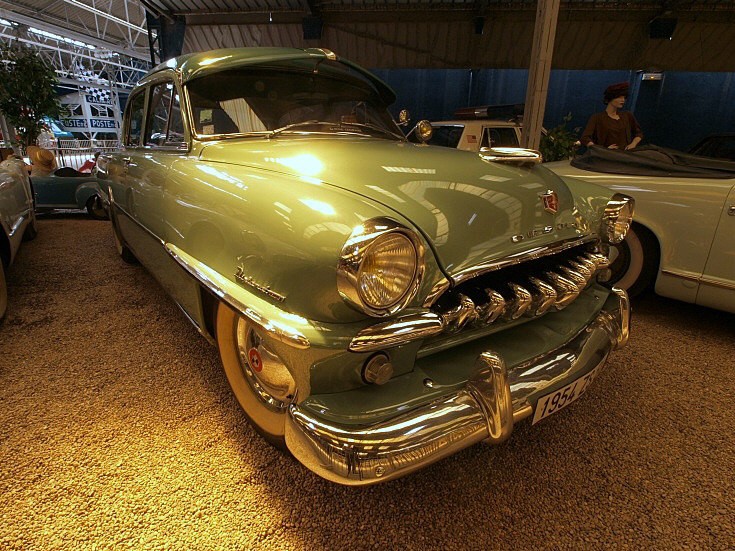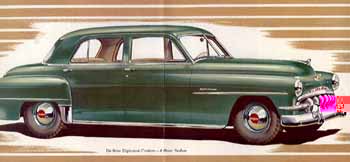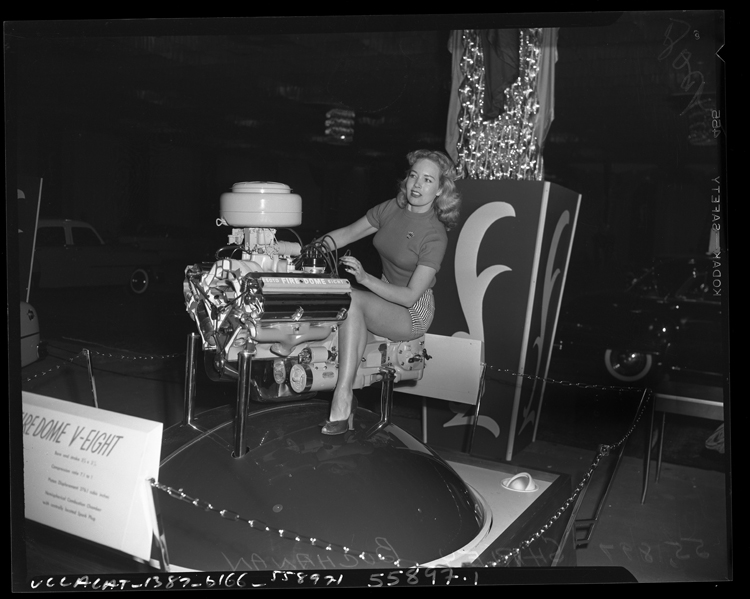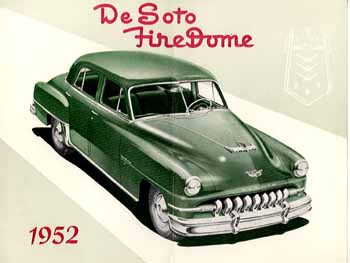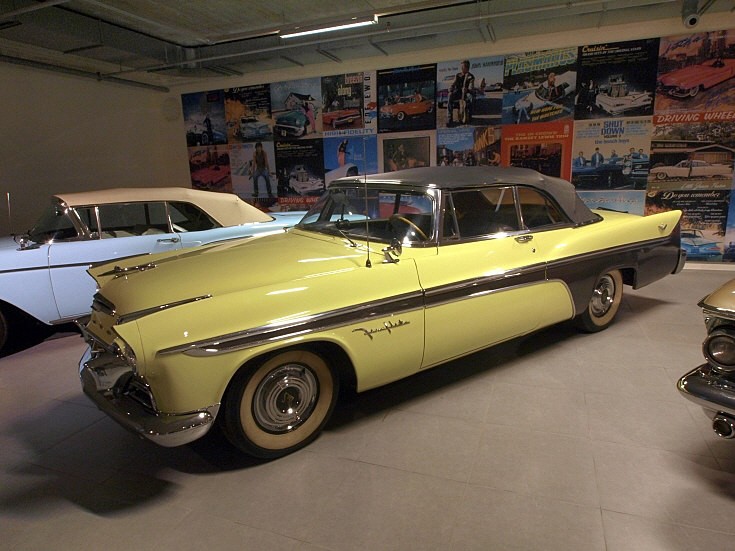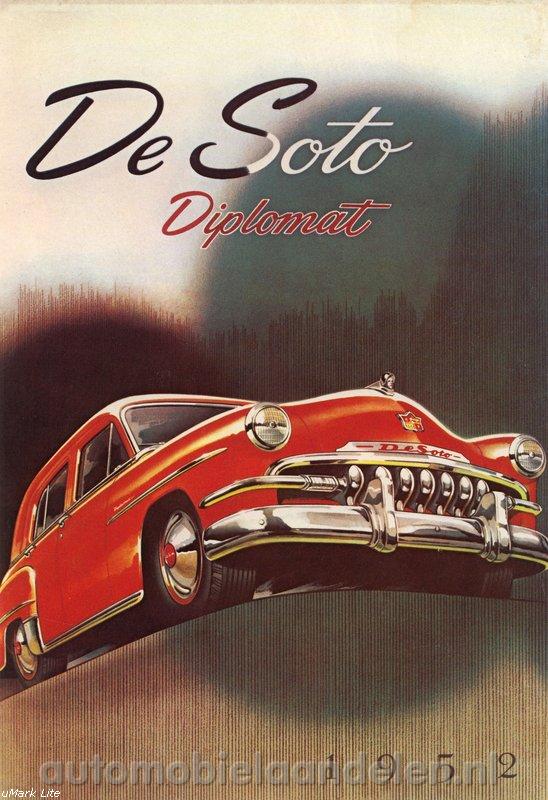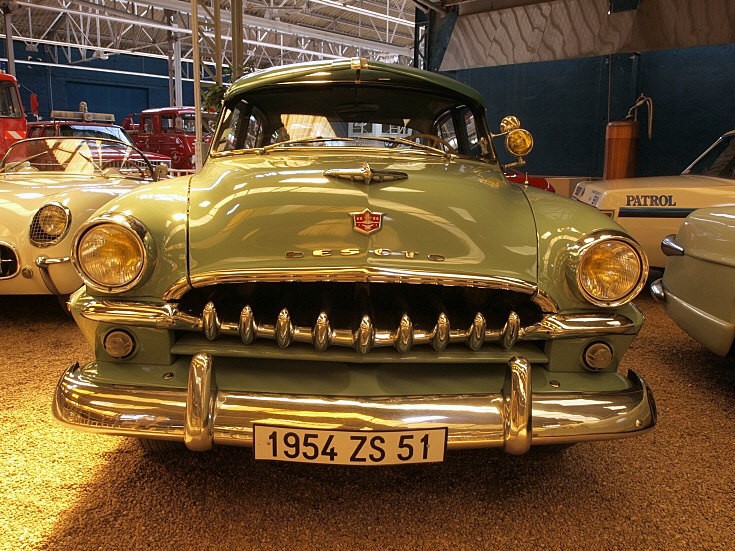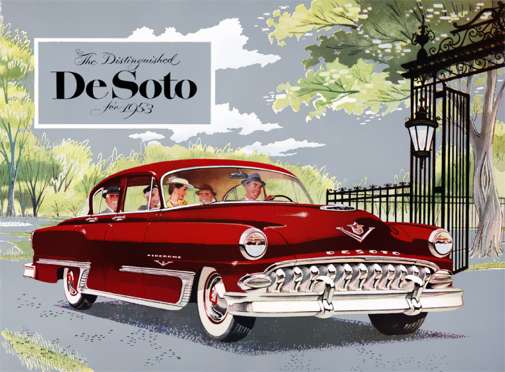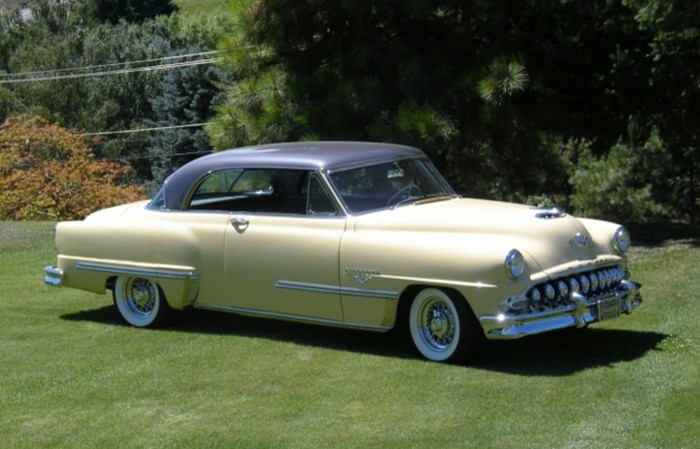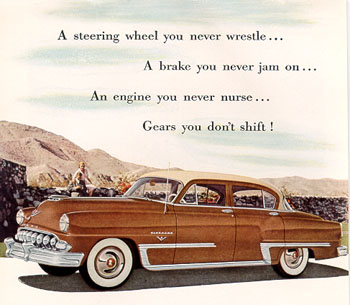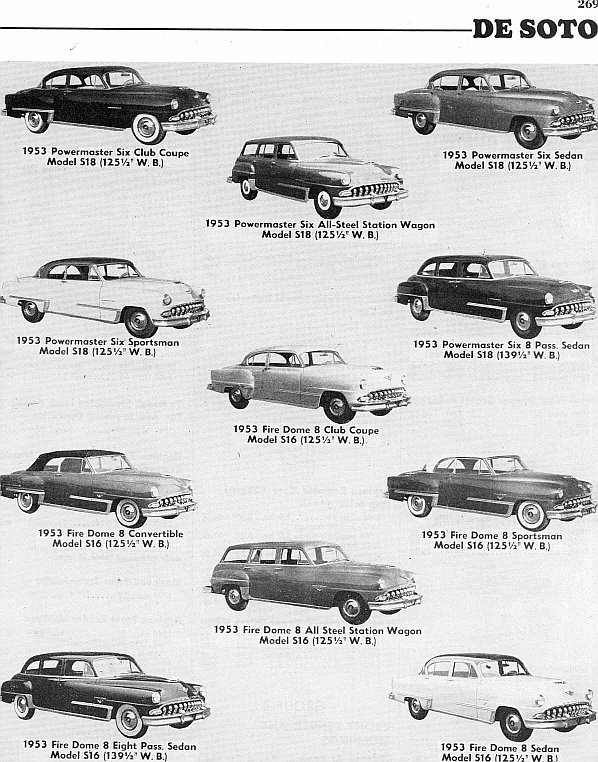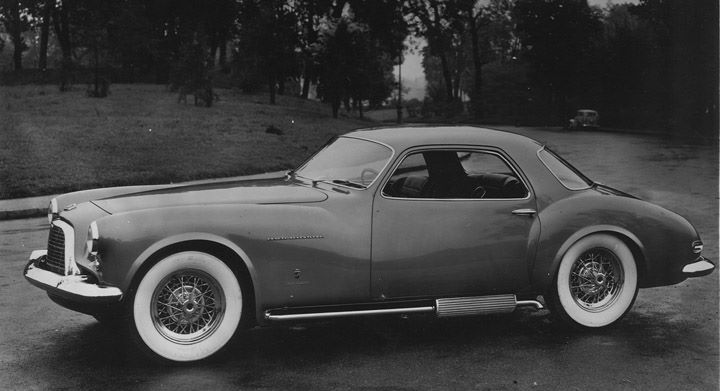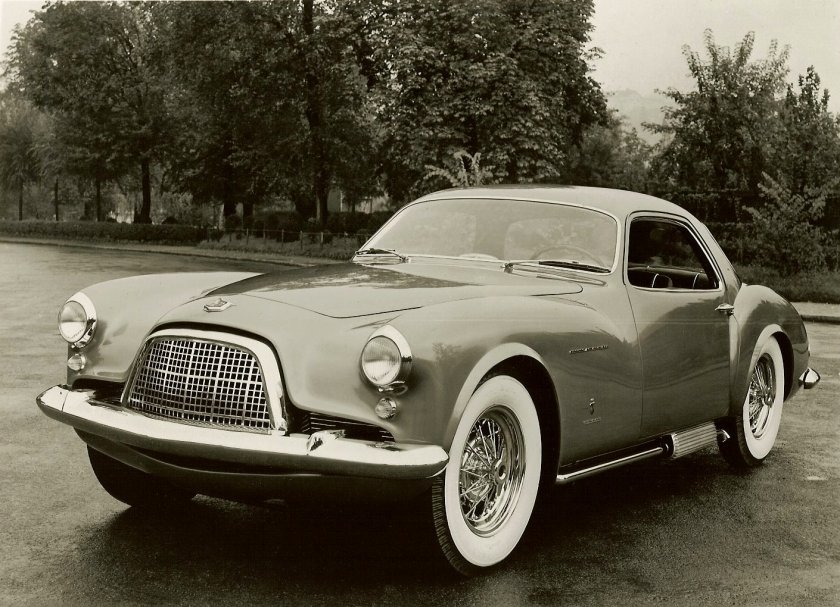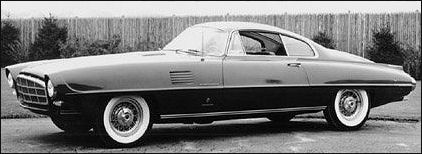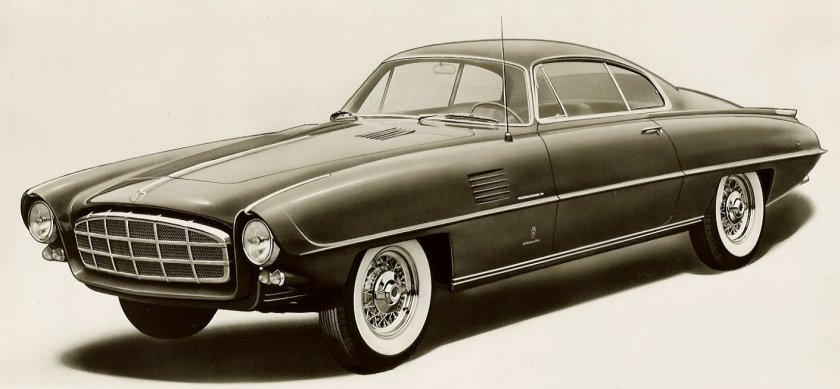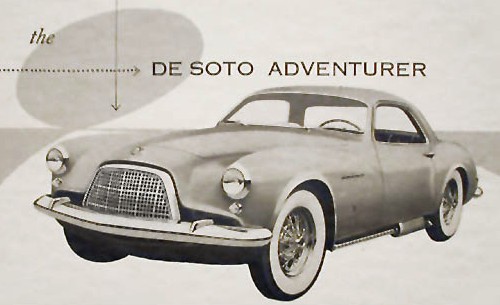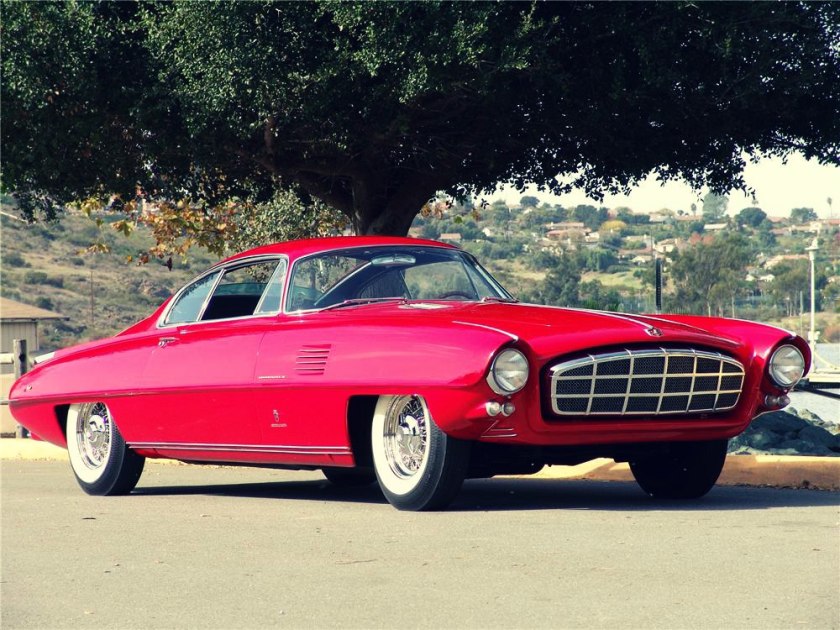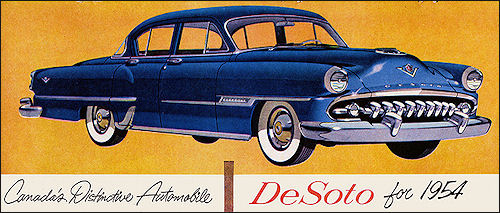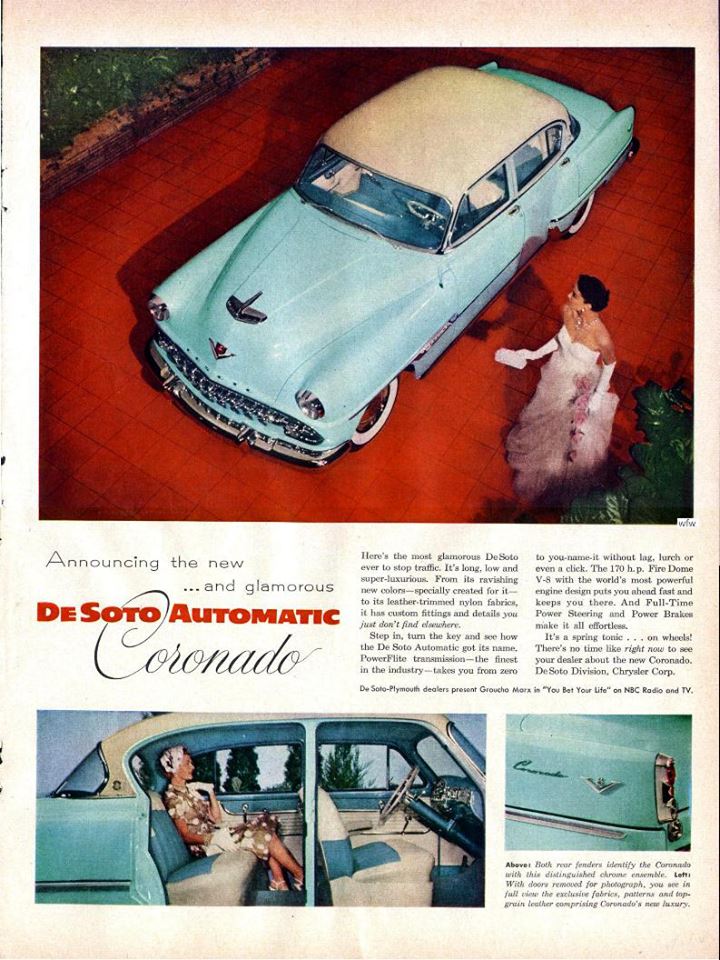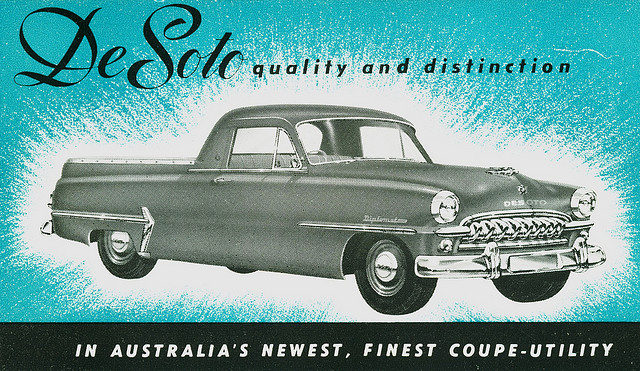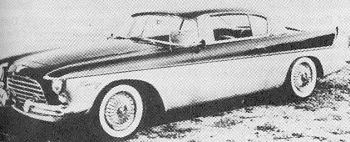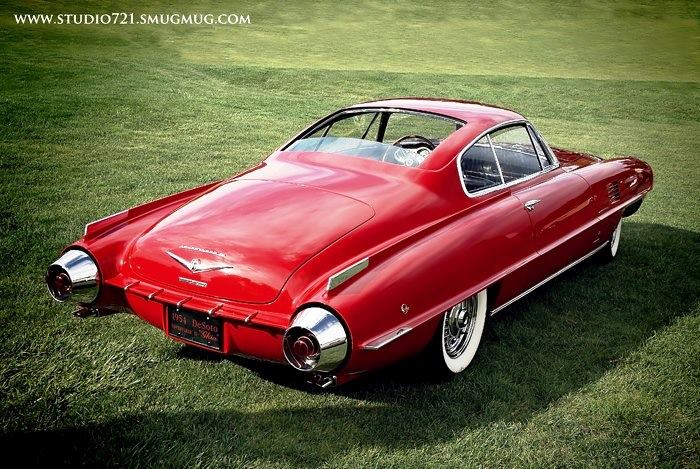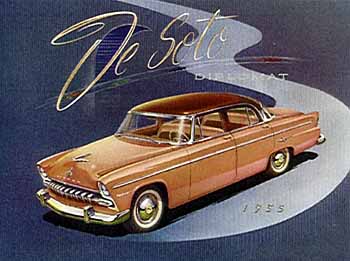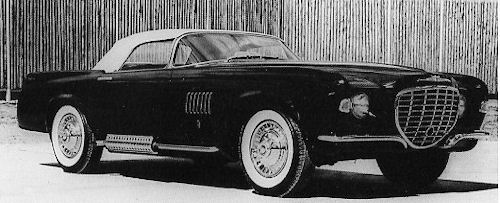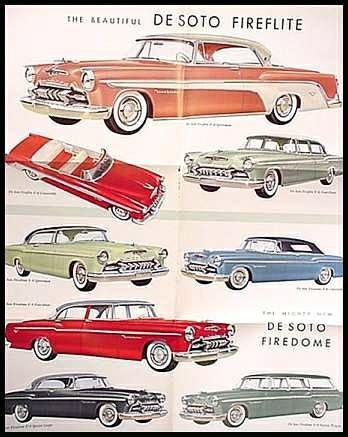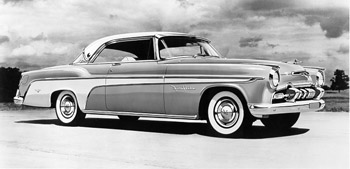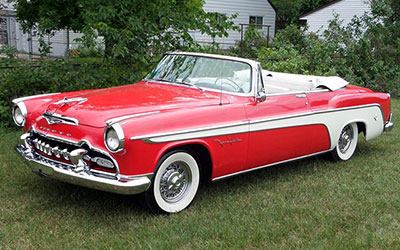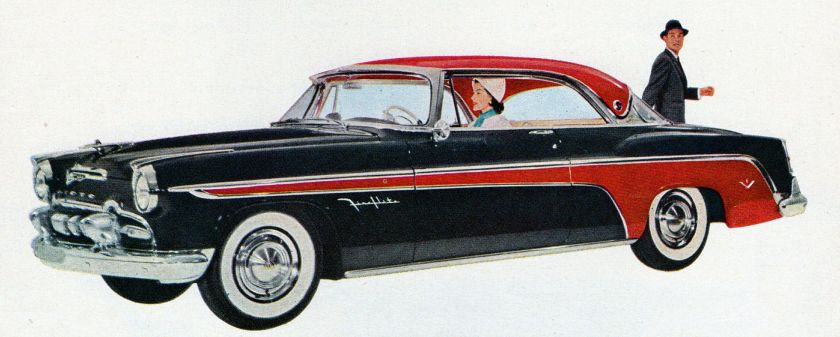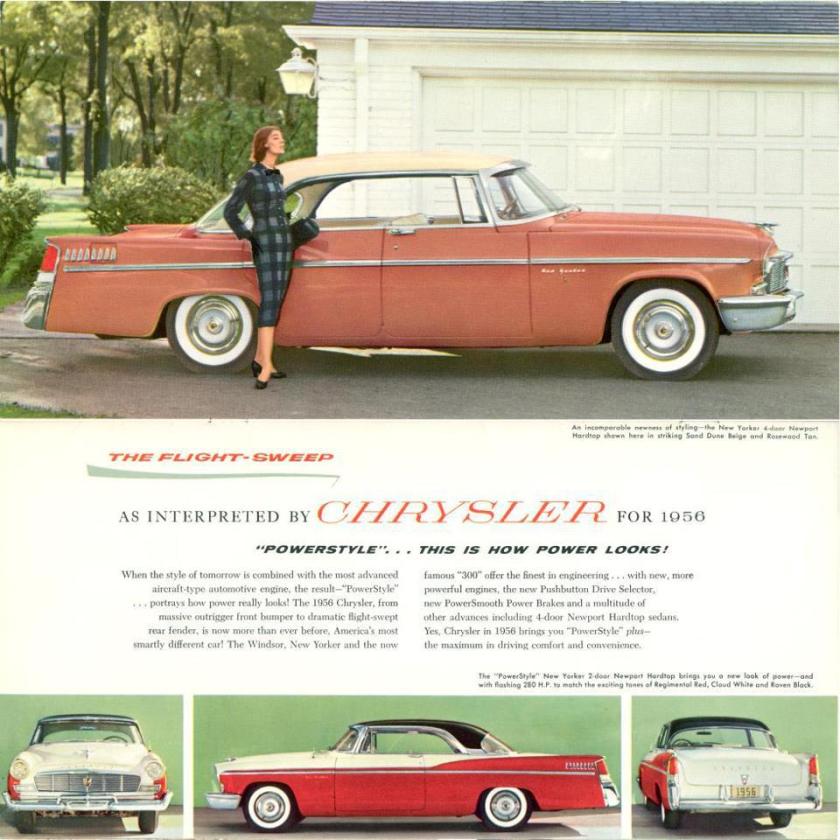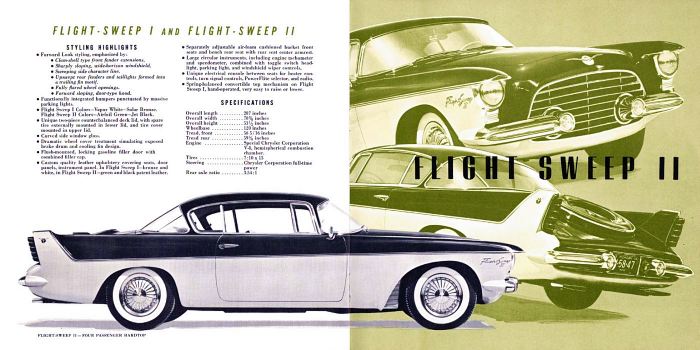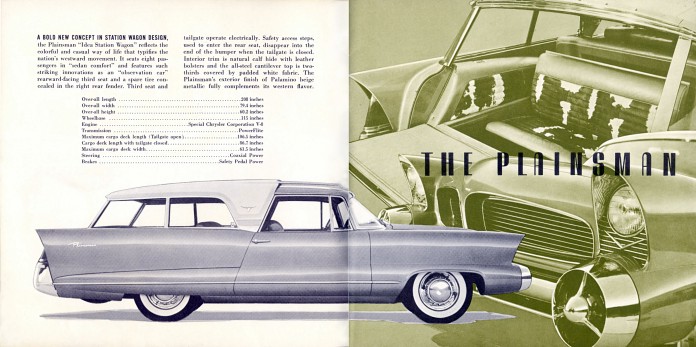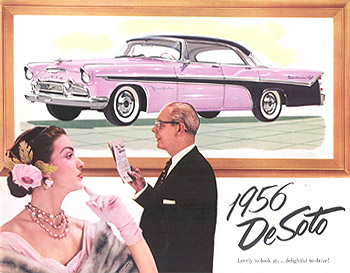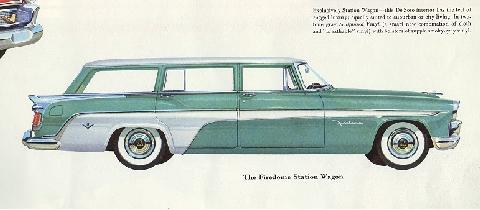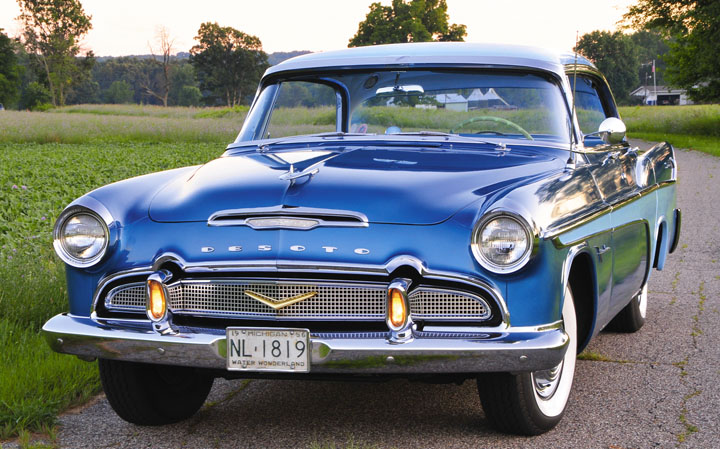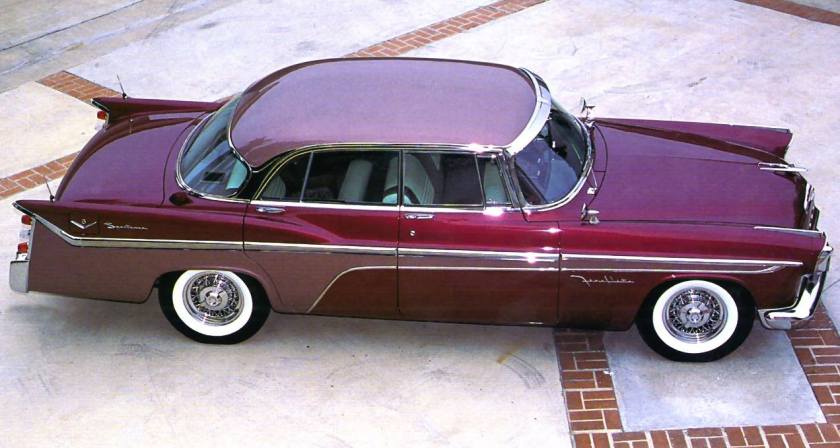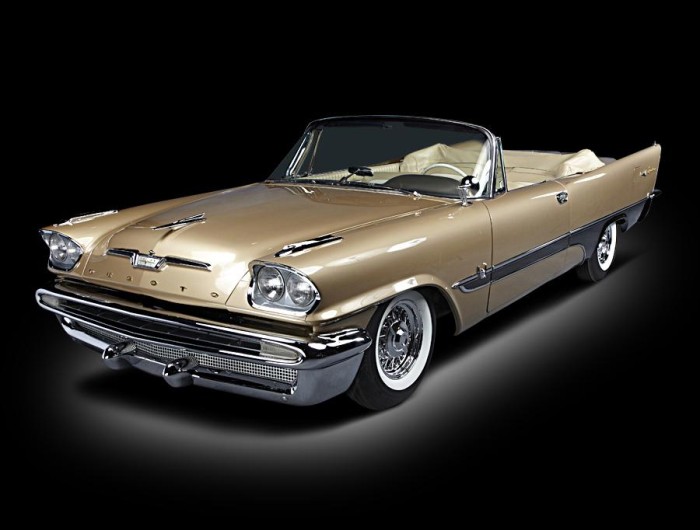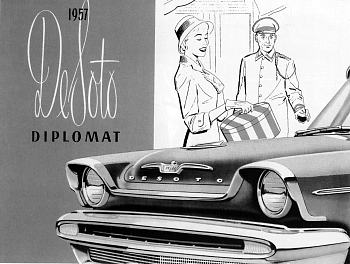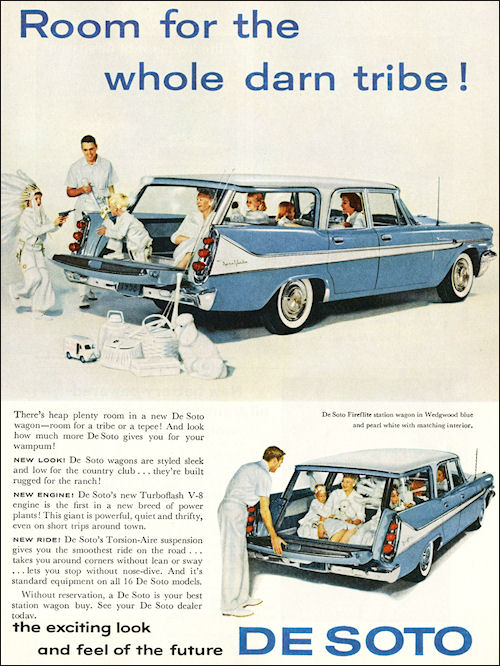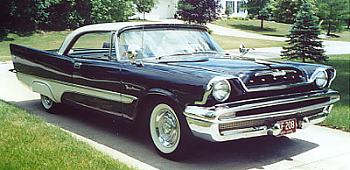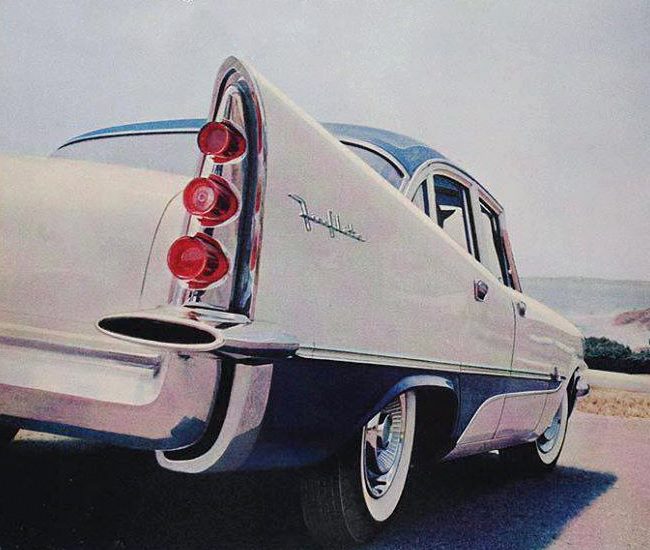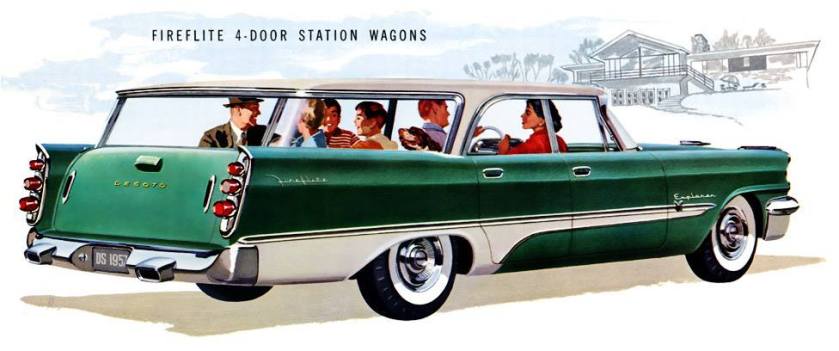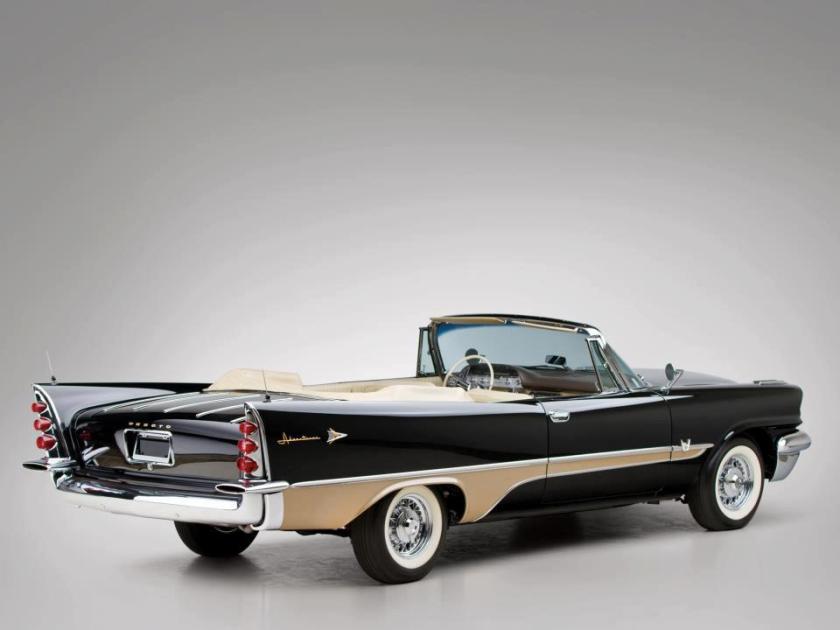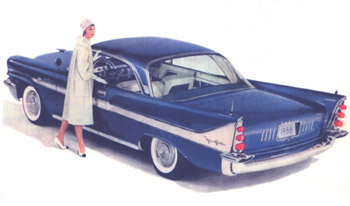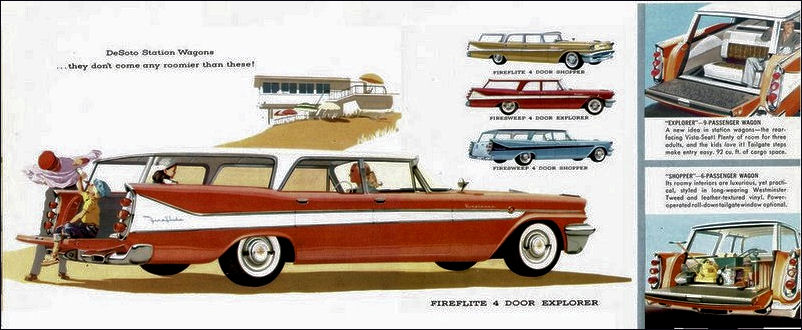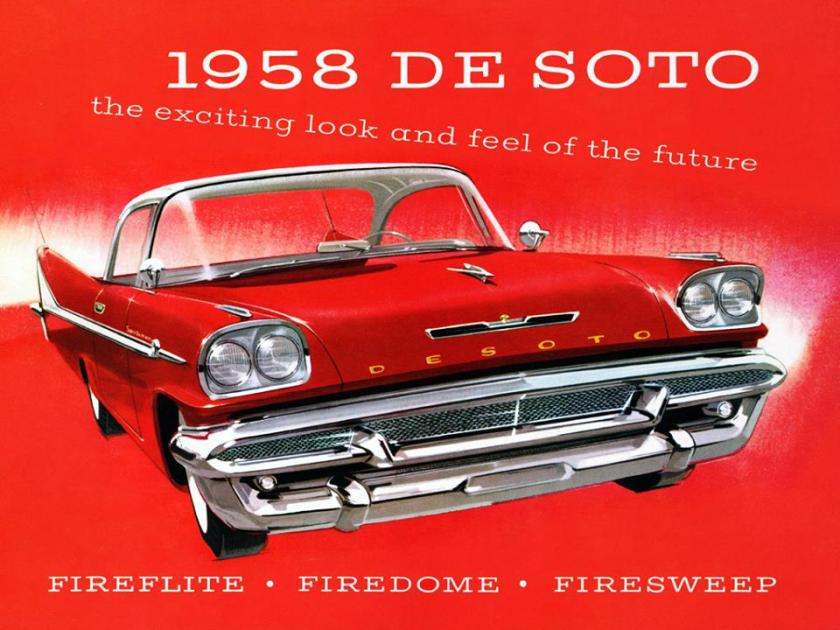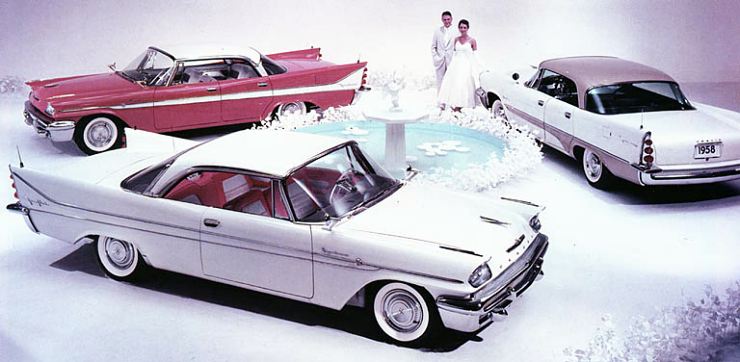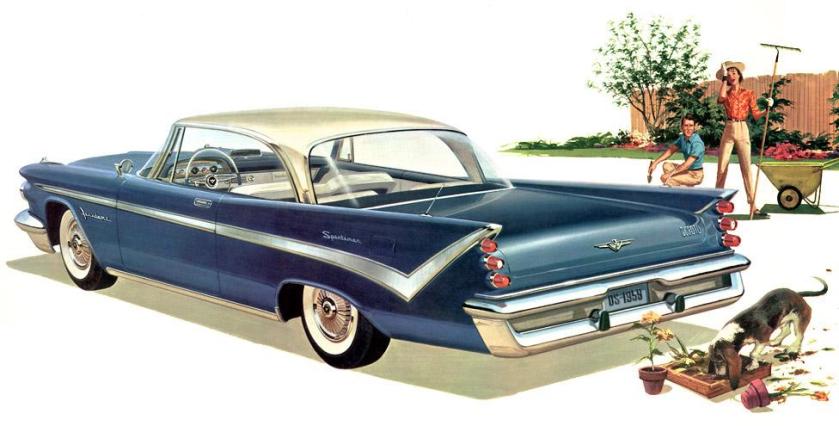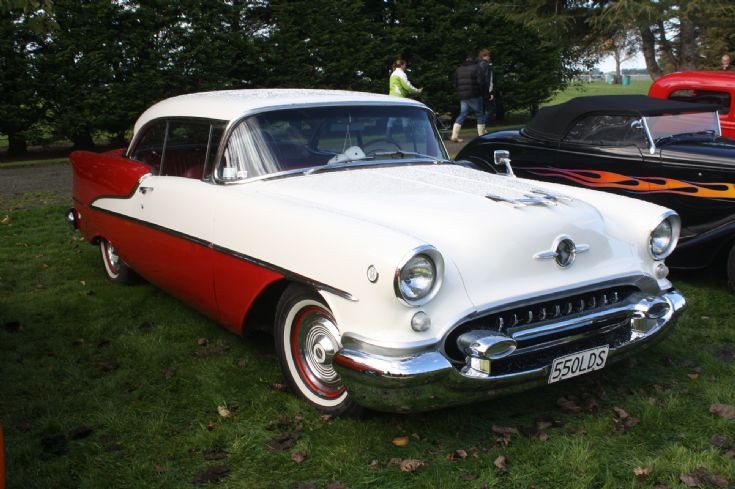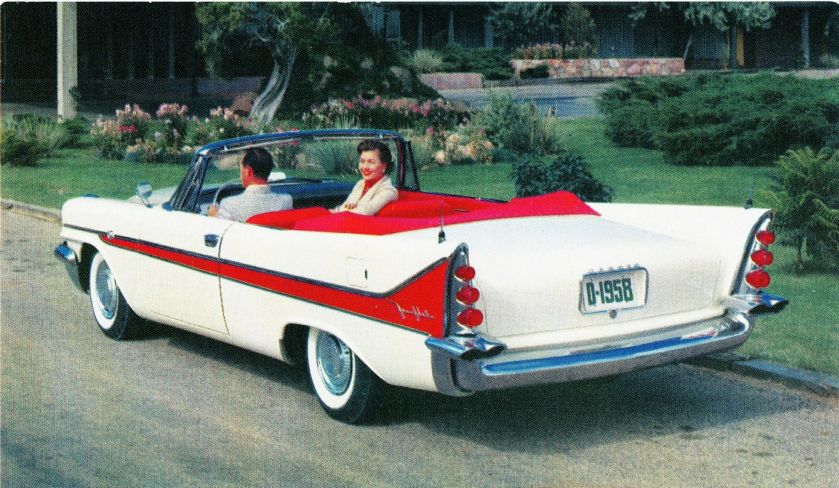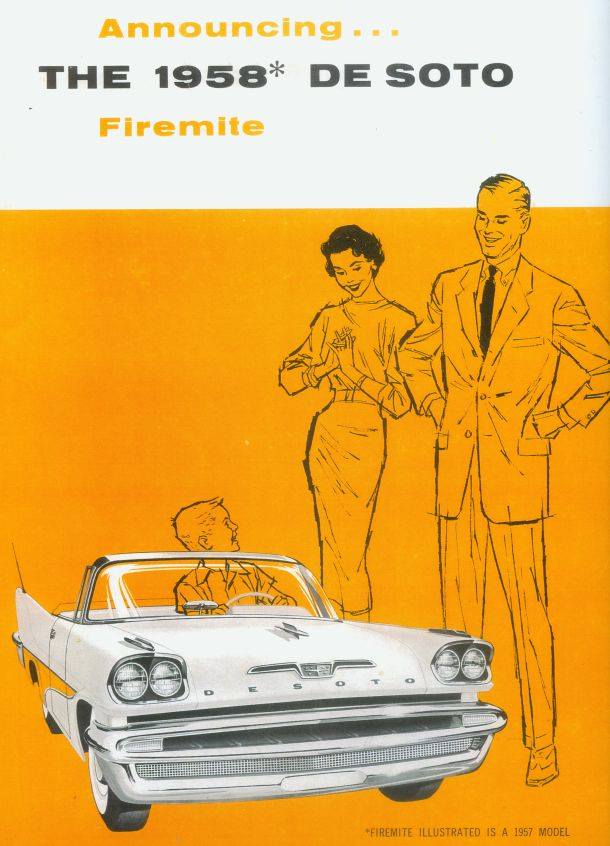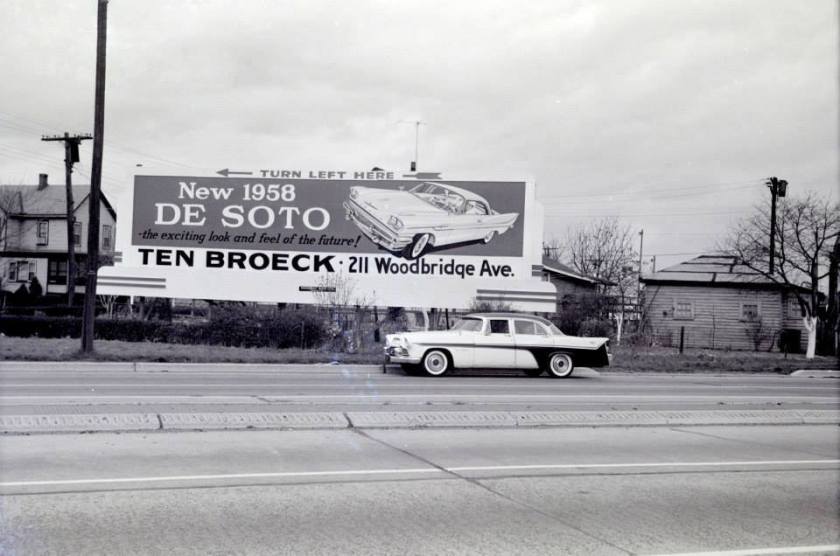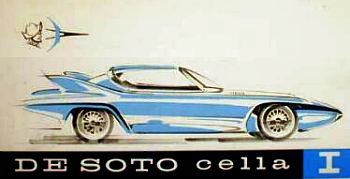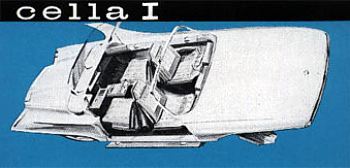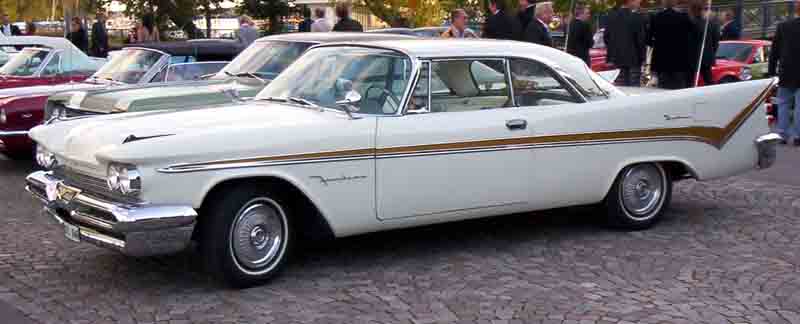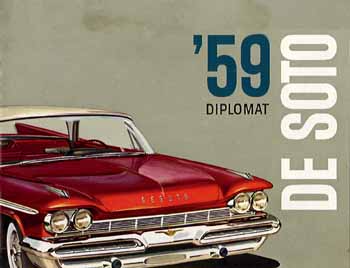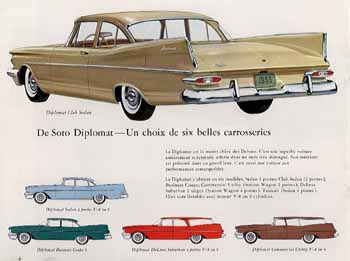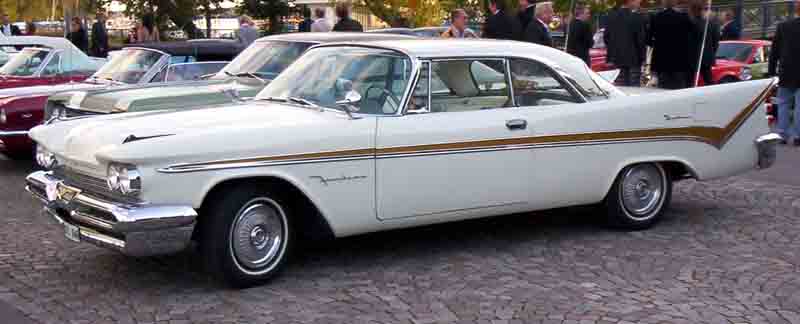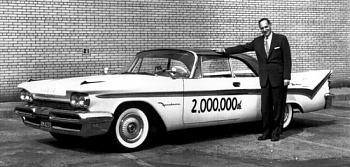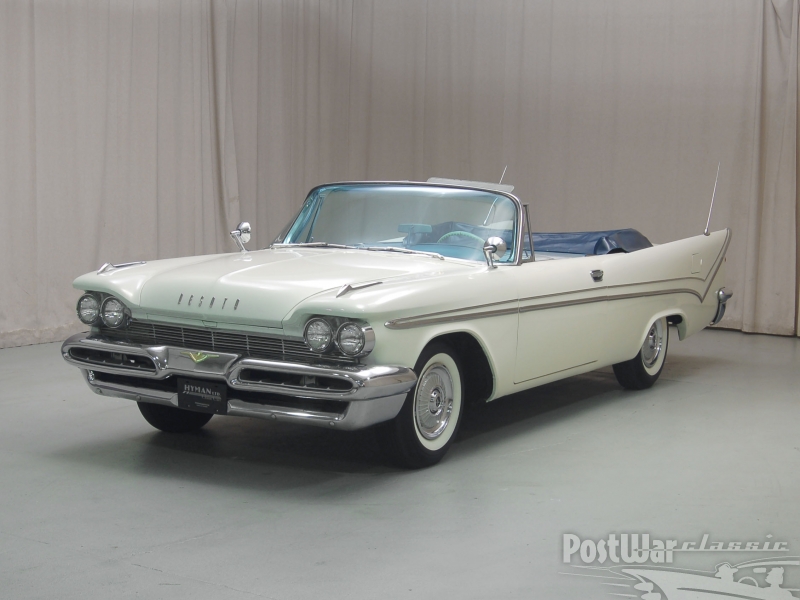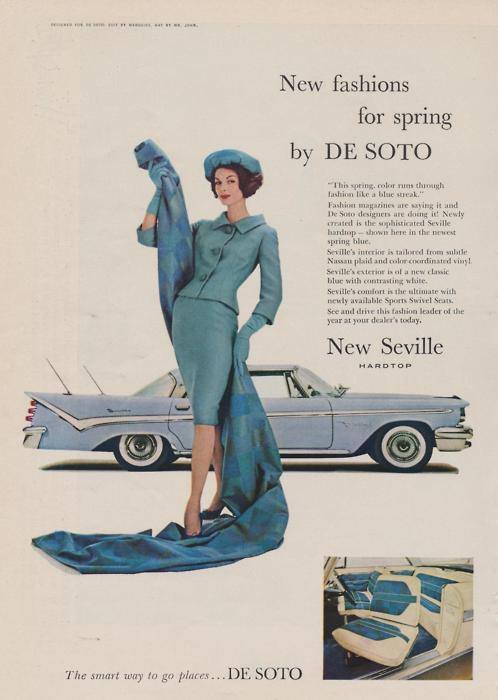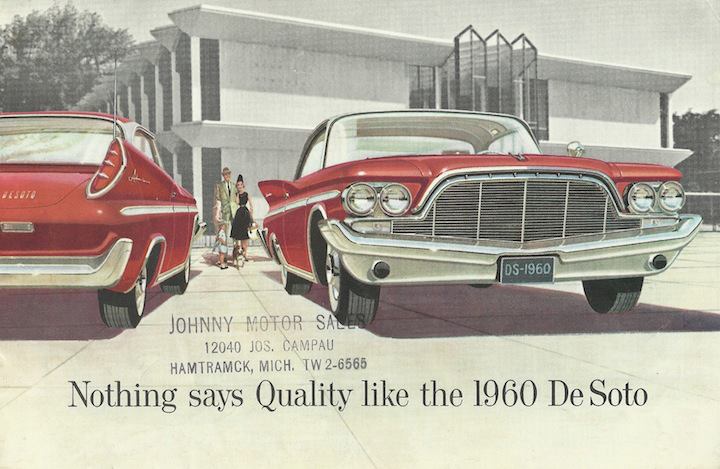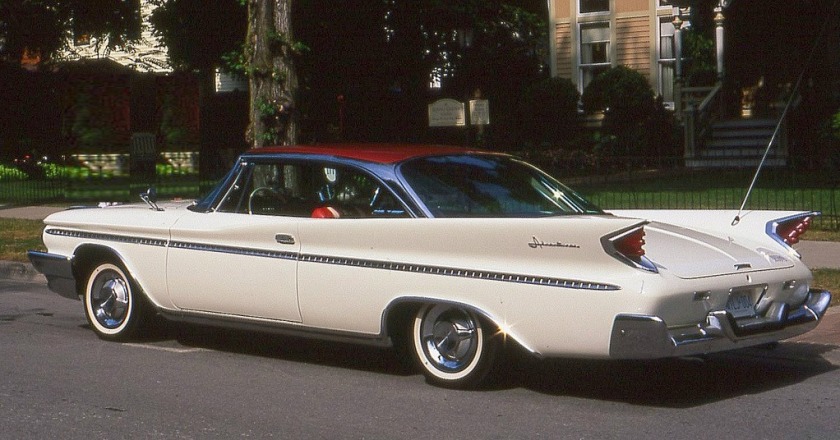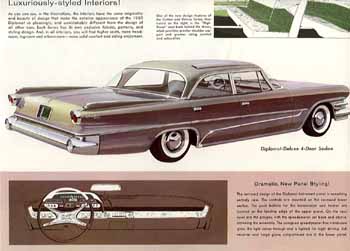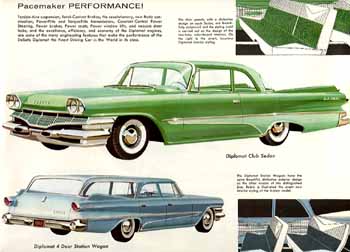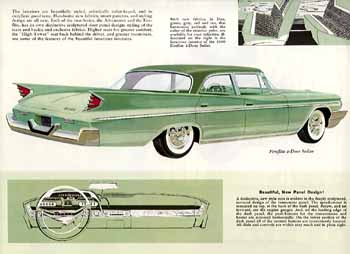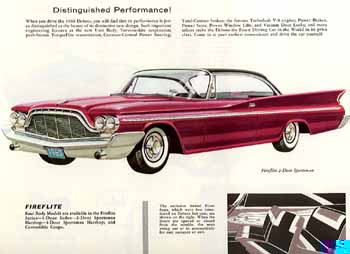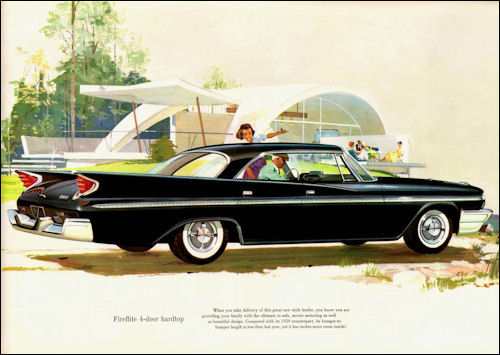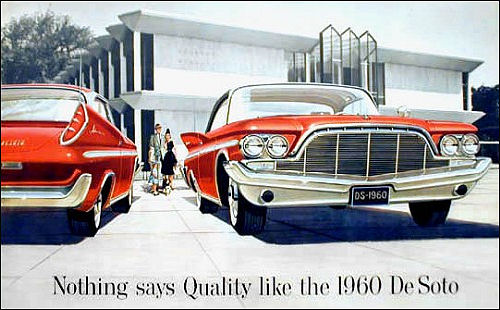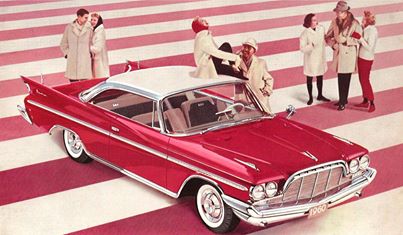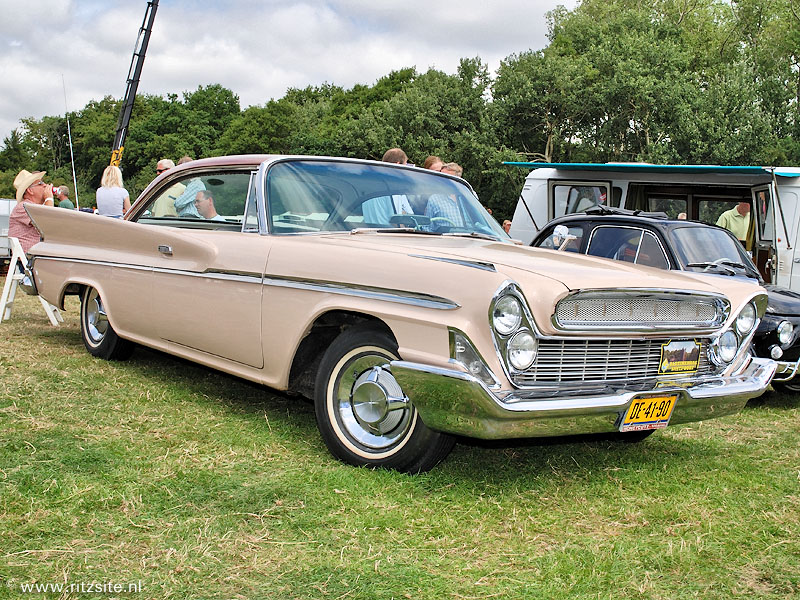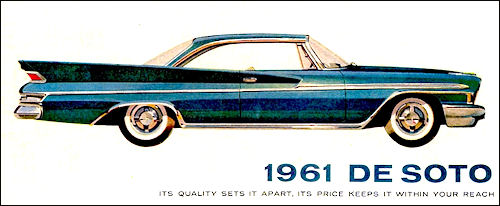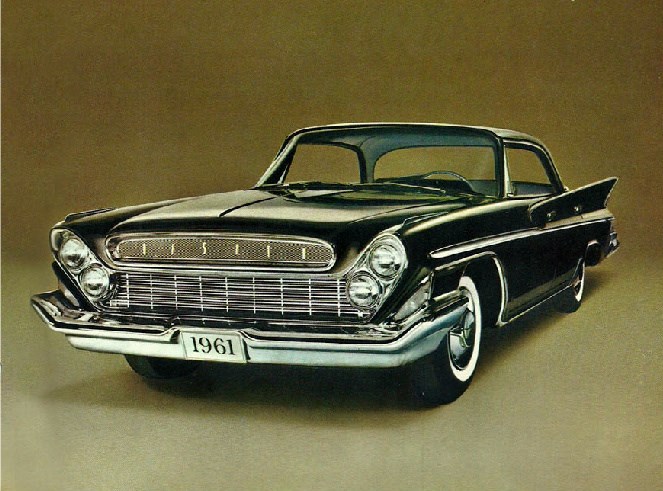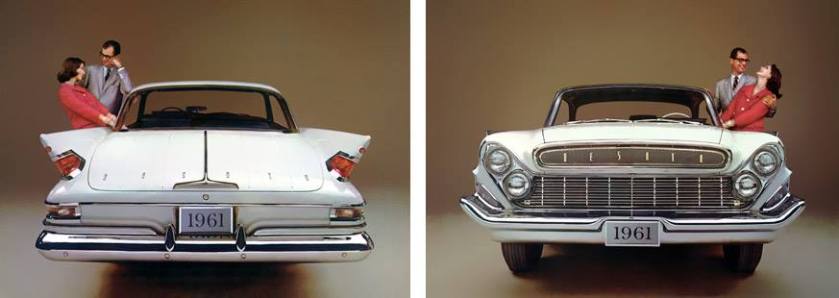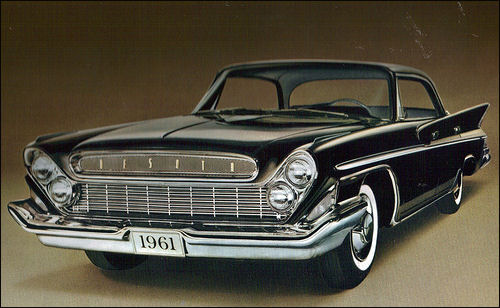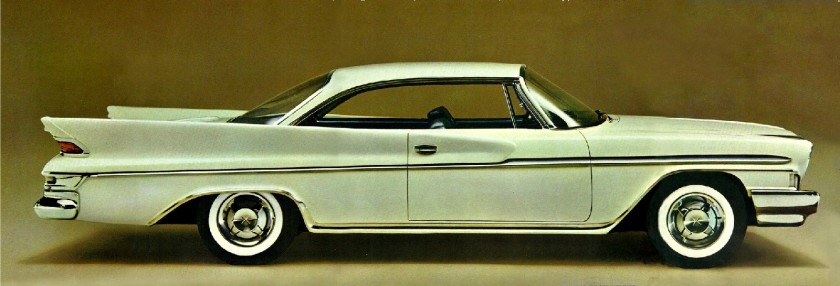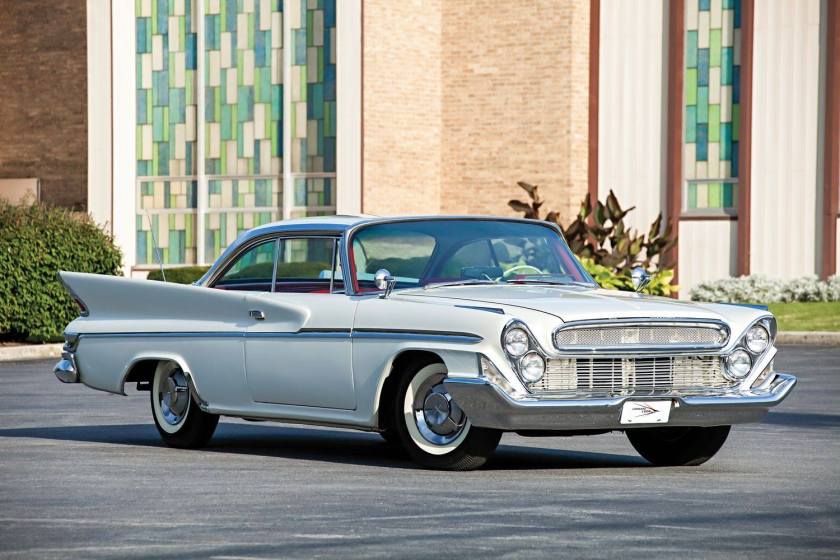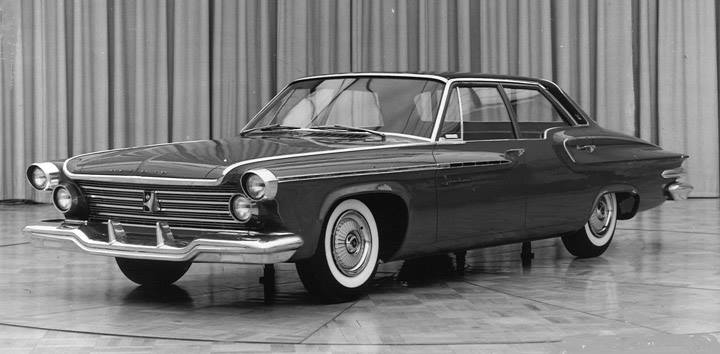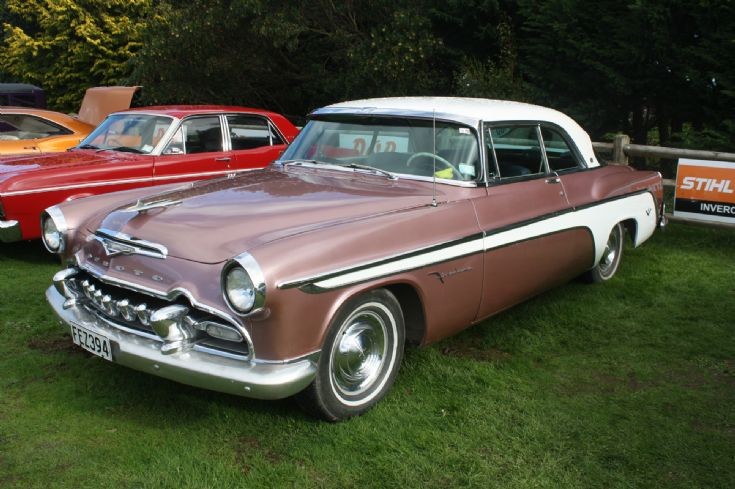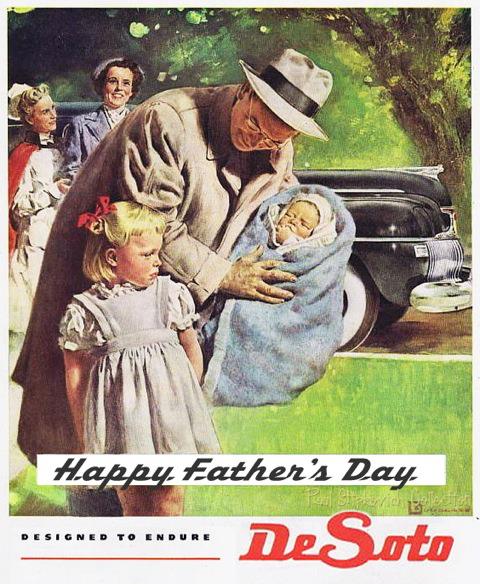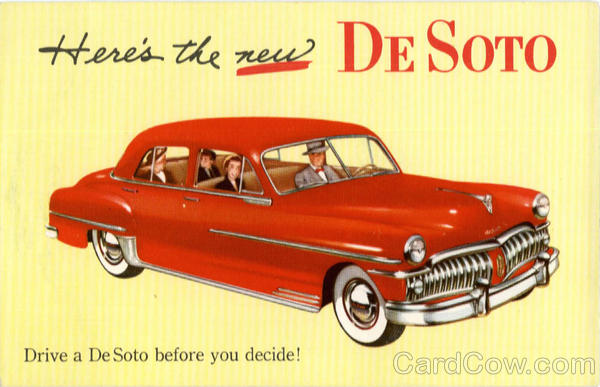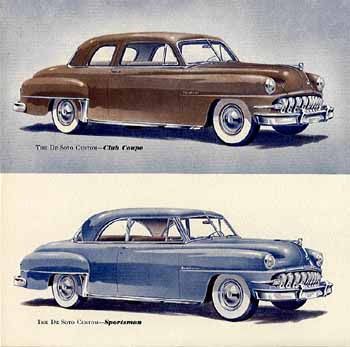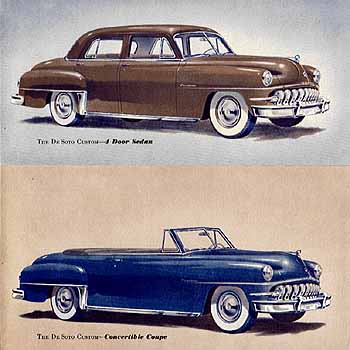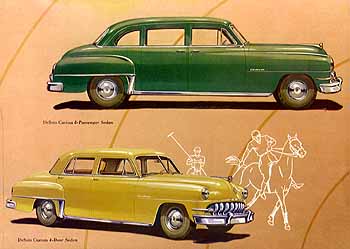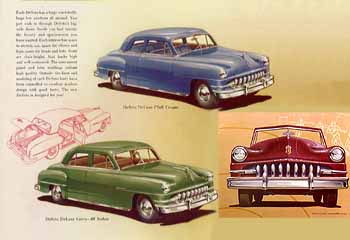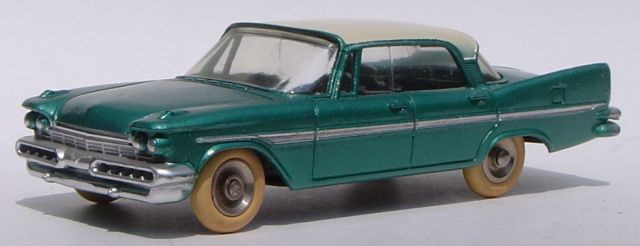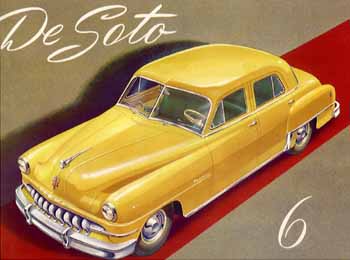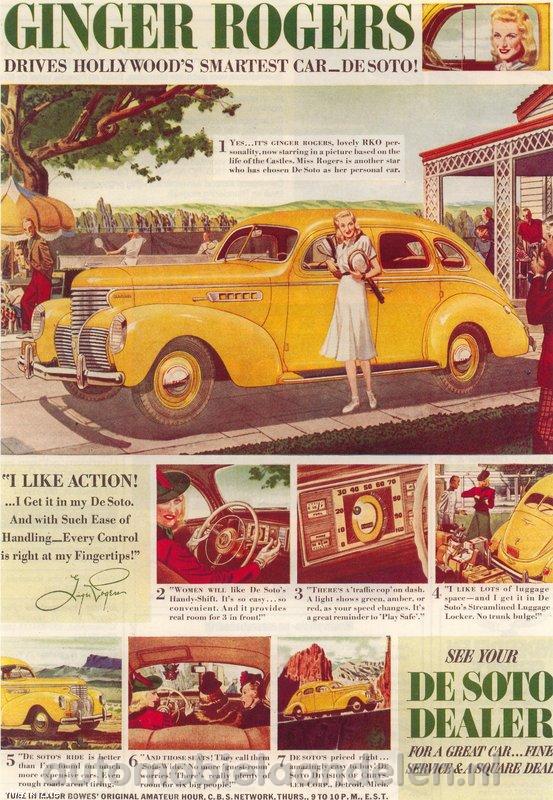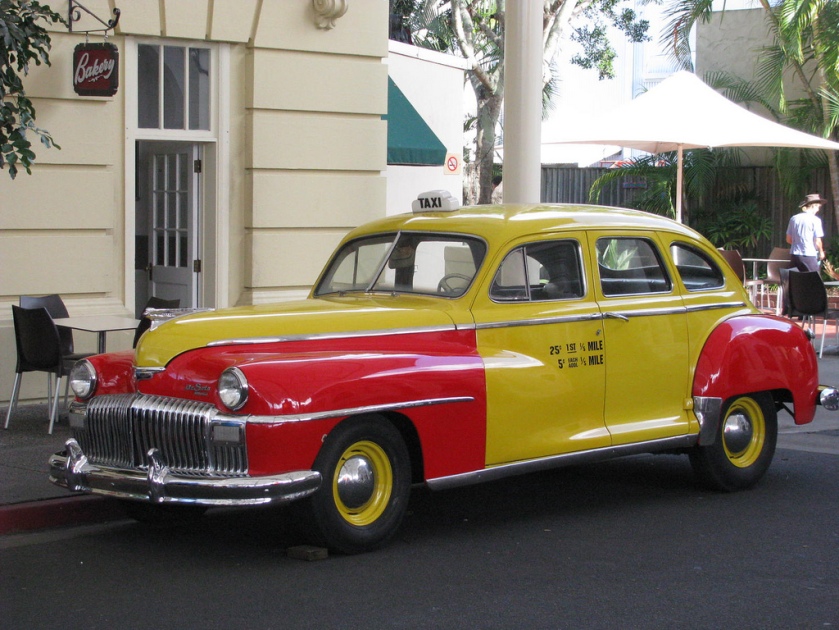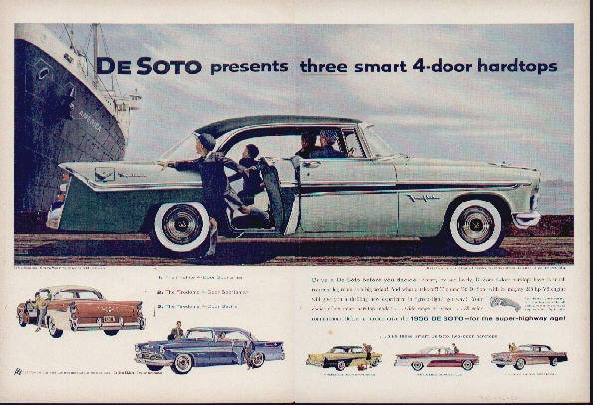1928-1961 DeSoto (automobile)
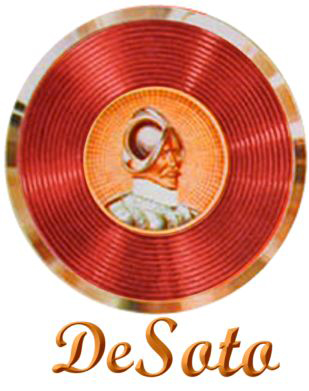 |
|
| Industry | Automobile |
|---|---|
| Fate | merged with Chrysler |
| Successor | Chrysler Newport |
| Founded | 1928 |
| Defunct | 1961 |
| Headquarters | Highland Park, Michigan |
| Products | Vehicles |
The DeSoto (sometimes De Soto) was an American automobile marque, manufactured and marketed by the now-defunct DeSoto Division of the Chrysler Corporation from 1928 to 1961. The DeSoto logo featured a stylized image of Spanish explorer Hernando de Soto. The De Soto marque was officially dropped November 30, 1960, with over two million vehicles built since 1928.
1929–1942
The DeSoto make was founded by Walter Chrysler on August 4, 1928, and introduced for the 1929 model year. It was named after the Spanish explorer Hernando de Soto. Chrysler wanted to enter the brand in competition with its arch-rivals General Motors, Studebaker, and Willys-Knight, in the mid-price class.
Shortly after DeSoto was introduced, however, Chrysler completed its purchase of the Dodge Brothers, giving the company two mid-priced makes. Initially, the two-make strategy was relatively successful, with DeSoto priced below Dodge models. Despite the economic times, DeSoto sales were relatively healthy, pacing Dodge at around 25,000 units in 1932. In fact, when DeSoto first came out in 1929, it broke the first-year sales record, with 81,065 cars sold, and was not beaten until 1960 by the Ford Falcon.
However, in 1933, Chrysler reversed the market positions of the two marques in hopes of boosting Dodge sales. By elevating DeSoto, it received Chrysler’s streamlined 1934 Airflow bodies. But, on the shorter DeSoto wheelbase, the design was a disaster and was unpopular with consumers. Unlike Chrysler, which still had more traditional models to fall back on, DeSoto was hobbled by the Airflow design until the 1935 Airstream arrived.
Aside from its Airflow models, DeSoto’s 1942 model is probably its second most memorable model from the pre-war years, when the cars were fitted with powered pop-up headlights, a first for a North American mass-production vehicle. (The Cord 810 introduced dashboard hand cranked hidden headlamps in the 1936 model year.) DeSoto marketed the feature as “Air-Foil” lights (“Out of Sight Except at Night”).
1929–1942 gallery
1946–1960
After wartime restrictions on automotive production were ended, DeSoto returned to civilian car production when it reissued its 1942 models as 1946 models, but without the hidden-headlight feature, and with fender lines extending into the doors, like other Chrysler products of the immediate postwar period.
Until 1952, DeSoto used the Deluxe and Custom model designations. In 1952 DeSoto added the Firedome with its 276-cid Hemi engine. However, in 1953, DeSoto dropped the Deluxe and Custom names and designated its six-cylinder cars the ‘Powermaster‘ and its V8 car remained the ‘Firedome‘.
At its height, DeSoto’s more popular models included the Firesweep, Firedome, and Fireflite. The DeSoto Adventurer, introduced for 1956 as a high-performance hard-top coupe (similar to Chrysler’s 300), became a full-range model in 1960.
In 1955,[3] along with all Chrysler models, De Sotos were redesigned with Virgil Exner‘s “Forward Look.” DeSotos sold well through the 1956 model year. That year, for the first and only time in the marque’s history, it served as Pace Car at the Indianapolis 500.[4] For the 1956 update Exner gave the DeSoto soaring tailfins fitted with triple taillights, and consumers responded by buying record numbers.
The 1957 had a well integrated design, with two variations: the smaller Firesweep, the Firedome/Fireflite body placed on the concurrent Dodge 122-inch wheelbase chassis with Dodge front fenders; and the Firedome and Fireflite (and its halo model Adventurer sub-series), based on the larger 126-inch wheelbase chassis shared with Chrysler. As was conventional in the era, subsequent years within the typical three-year model block were distinguished by trim, bumper, and other low-cost modifications, typically by adding bulk to bumpers and grilles, taillight changes, color choices, instrumentation and interior design changes and often additional external trim.
The 1958 economic downturn hurt sales of mid-priced makes across the board, and DeSoto sales were 60 percent lower than those of 1957 in what would be DeSoto’s worst year since 1938. Also Ford Motor Company had introduced a new mid-price competitor for the 1958 model year with the Edsel. The sales slide continued for 1959 and 1960 (down 40 percent from the already low 1959 figures), and rumors began to circulate DeSoto was going to be discontinued.
1946–1960 gallery
-
1956 Firedome 2-door hardtop
1961
By the time the 1961 DeSoto was introduced in the fall of 1960, rumors were widespread that Chrysler was moving towards terminating the brand, fueled by a reduction in model offerings for the 1960 model year. The introduction of the lower priced Newport to the upscale Chrysler brand no doubt hastened the decision to end production of DeSoto, which was very similar in size, styling, price, and standard features.
For 1961, DeSoto lost its series designations entirely, in a move reminiscent of Packard’s final lineup. And, like the final Packards, the final DeSoto was of questionable design merit. Again, based on the shorter Chrysler Windsor wheelbase, the DeSoto featured a two-tiered grille (each tier with a different texture) and revised taillights. Only a two-door hardtop and a four-door hardtop were offered. The cars were trimmed similarly to the 1960 Fireflite.
The final decision to discontinue DeSoto was announced on November 30, 1960, just forty-seven days after the 1961 models were introduced. At the time, Chrysler warehouses contained several million dollars in 1961 DeSoto parts, so the company ramped up production in order to use up the stock. Chrysler and Plymouth dealers, which had been forced to take possession of DeSotos under the terms of their franchise agreements, received no compensation from Chrysler for their unsold DeSotos at the time of the formal announcement. Making matters worse, Chrysler kept shipping the cars through December, many of which were sold at a loss by dealers eager to be rid of them. After the parts stock was exhausted, a few outstanding customer orders were filled with Chrysler Windsors.
Termination factors
Despite being a successful mid-priced line for Chrysler for most of its life, DeSoto’s failure was due to a combination of corporate mistakes and external factors beyond Chrysler’s control. The Chrysler brand essentially moved from a luxury automaker to a mid-priced automaker when Chrysler launched the separate Imperial brand in 1954 for the 1955 model year. Most DeSoto models were merged into the new Chrysler Newport in 1961.
Recession
The 1958 recession, which seriously affected demand for mid-priced automobile makes, hurt DeSoto sales particularly badly, and sales failed to recover in 1959 and 1960. With falling sales, the 1959 and 1960 models were very similar to the concurrent Chryslers, and rumors began to circulate that DeSoto would be discontinued.
Dealer networks
Chrysler’s dealer network also had an effect on the termination of DeSoto. Following World War II, Chrysler had a large number of dealers that carried two or more Chrysler makes, with DeSoto-Plymouth and Chrysler–Plymouth relationships being the most common. However, as Chrysler attempted to spin Plymouth off into stand-alone dealerships, existing dealers typically chose to become higher-volume Plymouth dealerships over the slower-selling DeSoto brand, leaving the marque with a weakened dealer network and fewer outlets selling its cars. Also, DeSoto Division’s failure to adjust to changing market trends by introducing a new compact car model in 1960 as its GM and Ford counterparts, as well as its own Dodge and Plymouth siblings did, also hastened its demise.
Brand management and marketing
It was Chrysler’s own brand management in 1950s, which pitted each of the five marques (Plymouth, Dodge, DeSoto, Chrysler, and Imperial) against one other, that did the greatest damage to DeSoto and, ultimately, to the company itself in long-range product planning. Rather than carefully managing the market relationship to specific price points for all consumers, as General Motors had done so successfully, Chrysler allowed its own divisions to develop products targeting markets covered by their own sister divisions. Dodge was, by far, the most successful when it introduced the lower-priced Dodge Dart in 1960, advertising for which compared the Dart to the “C” car, the “F” car, and the “P” car—Chevrolet, Ford, and Plymouth. While Dart sales soared in 1960, they did so at the expense of Plymouth, which lost sales to the Dart. Plymouth, traditionally one of the “low priced three” fell out of third place, only to regain it twice (1971 and 1974) before its own demise in 2001.
Dodge moved upmarket with the Custom Royal in the mid-1950s which cut into and eroded Desoto’s market. The introduction of the 1957 DeSoto Firesweep, a model that used the Dodge engine, chassis, front fenders, and hood, pushed DeSoto down into Dodge territory competing directly against the Custom Royal. The Firesweep sold well, but at the expense of the higher priced Firedome and Fireflite models. The DeSoto began looking like a Chrysler with a different grille and taillights, which, in an era of strong make identification, was a recipe for disaster.
When Chrysler marketing showed that consumers were likelier to buy an entry-level Chrysler than a DeSoto, Chrysler introduced the Chrysler Newport as a 1961 model, selling more than 45,000 units in its first year. At less than $3,000, the Newport covered the same price range as the 1961 DeSoto, which had sold 3,034 units total. Thus the DeSoto was dropped and replaced by Chrysler Newport.
Going in the opposite direction, Chrysler pushed into the luxury market by marketing the luxury ‘Imperial‘ as a separate make and division starting in 1955. To make room for the new make, Chrysler Division began expanding downward, while Dodge Division began expanding upward, with larger and more luxurious models. Both Chrysler and Dodge began eating into DeSoto’s already small market; and Chrysler’s upper management did nothing to stop them.
DeSoto trucks
Chrysler Corporation introduced the DeSoto brand of trucks in 1937 to provide a greater number of sales outlets overseas for the American-built Dodge and Fargo commercial vehicles. The DeSoto brand was badge engineered sporadically on Dodge trucks made in Argentina, Australia, Spain, Turkey, and the United Kingdom.
Chrysler ended its truck operations in international markets. However, both the DeSoto and Fargo brands continue to be used on trucks made by Askam in Turkey. In 1978, Chrysler sold its share in the Askam venture to its Turkish partners.
Models
- DeSoto Adventurer (1956–1960)
1956-1960 DeSoto Adventurer
The DeSoto Adventurer is an automobile produced by the Chrysler Corporation and sold under its DeSoto automotive marque from 1956 through the 1960 model year. The Adventurer name first started out a four seat high performance sports coupe concept car, but then was changed to be DeSoto’s special, limited-production, high-performance model, similar to the Chrysler 300. While in production, the Adventurer was DeSoto’s top-trim level car, and offered only as a hardtop coupe in 1956. The model range grew when the coupe was joined by a convertible in 1957, and a four-door hardtop and sedan in its final year of 1960.
1956
Introduced in 1956 as a sub-series of the top level DeSoto Fireflite series, the Adventurer was originally marketed as a limited production two-door hardtop, and available in a white/black/gold color scheme only. The first Adventurer came with a hi-output 341 cubic inch Hemi V8, dual exhausts and custom appointments and trim. Standard trim included dual outside side mirrors, gold wheel covers, radio, electric clock, padded instrument panel, windshield washers, full instrumentation, and heavy duty suspension. A total of 996 cars were sold in its first year.
Specifications
- Wheelbase = 126 in (3,200 mm)
- Length = 220.9 in (5,611 mm)
- Width = 78.9 in (2,004 mm)
- Height = 60.3 in (1,532 mm)
- Leg-room-front = 45.7 in (1,161 mm)
- Transmission = PowerFlite automatic
1957
For 1957, the Adventurer received Chrysler’s forward look design along with other divisional cars. A convertible also joined the two-door hardtop, and again color choices were limited to the black-white and gold color theme. The car debuted in December, 1956, and to rave reviews, foremost among them was Mechanix Illustrated Automobile Editor Tom McCahill who proclaimed the DeSoto as being the best styled of all of Chrysler’s makes for 1957.
Like the 1956 car, the 1957 Adventurer was powered by Chrysler’s high output V8, which was now up four cubic inches to 345 bhp (257 kW). Equipped with dual four barrel carburetors, the engine developed one horsepower per cubic inch displacement. For 1957, 1,950 units were produced.
1958
The 1958 Adventurer was an update to the all-new styling that car received in 1957. Along with the annual trim changes, the car also received a new grille with a mesh insert, plus dual headlights. The cars debuted at the Chicago auto show in January 1958. The Hemi engine was no longer available, instead a 361 cubic inch wedge head was used. DeSoto offered fuel injection (produced by Bendix Corporation), the units proved troublesome and were an expensive option so very few Adventurers were sold with them. Those not equipped with the unit received the dual-quad carburetors. The shortened model year, combined with the effects of the 1958 recession dropped Adventurer production down to 432 units, 350 hardtops and 82 convertibles, a 62 percent drop in sales compared to 1957. However DeSoto itself was in the midst of a sales free-fall, and all series production was off brand-wide.
1959
Restyled for 1959, the DeSoto’s look began to take on more traits of the up-market Chrysler. The Adventurer again was limited in its color schemes, and came with the most standard features of any DeSoto automobile (though the radio became an option). The car was powered by the wedge head 383 V8, tuned to 350 bhp (260 kW) at 5,000 R.P.M. 687 units were produced for 1959, up from 1958, but not significantly enough to help stem the forty percent drop to DeSoto’s divisional sales. New was the standard swivel out seats.
1960
For its final year, the Adventurer lost its convertible but gained a four-door hardtop and sedan. Instead of being a limited edition model, the Adventurer was the top trim model range for the two series DeSoto line-up for 1960. Ram induction was reintroduced on models with the quad-four carburetor. This was also the only year that car came in variety of colors instead of its traditional white-black and gold combination. Total sales for the Adventurer line posted its best effort with 11,597 models produced.
But rumors surrounded DeSoto that Chrysler was ready to kill the brand and customers reacted by buying other brand cars. Also hurting DeSoto was its design, almost exactly like that of Chrysler, except for the grille and the blade styled tail lights, also drove consumers into Chrysler showroom where they bought the almost identical Chrysler Windsor without the fear that it would be an orphan like the DeSoto was bound to be, and soon. New was dual speed rear window defoggers, a drivers seat with five more inches added to the seat back, the Hiway Hifi that played RCA 45rpm records, and Unibody construction.
In its final year of 1961, DeSoto would offer a single car line, offered in two body styles. Chrysler announced the end of DeSoto in November 1960, with production lasting just long enough to deplete supplies of DeSoto trim on hand.
- DeSoto Airflow (1934–1936)
1933-1936 DeSoto Airflow
| DeSoto Airflow | |
|---|---|
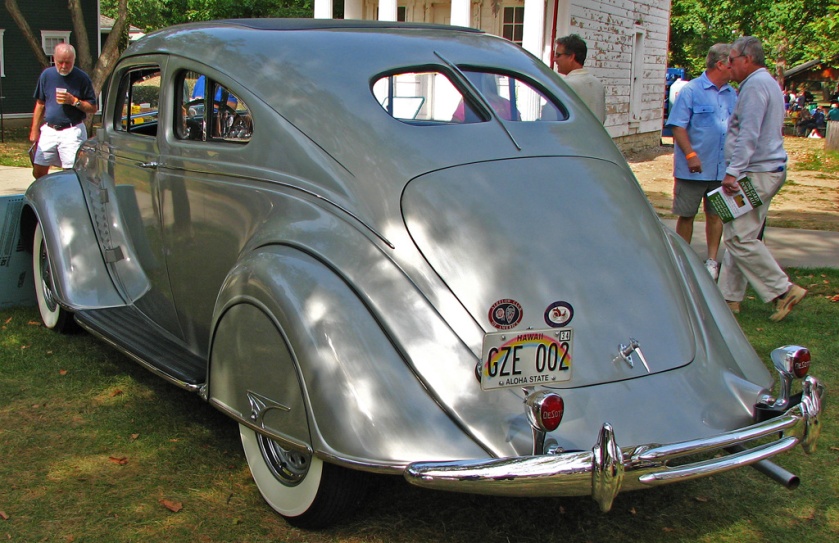 |
|
| Overview | |
| Manufacturer | Chrysler |
| Production | 1933-1936 |
| Model years | 1934-1936 |
| Body and chassis | |
| Class | Full-size |
| Body style | 2-door coupe 4-door sedan |
| Layout | FR layout |
| Dimensions | |
| Wheelbase | 115.5 in (2,934 mm) |
The DeSoto Airflow was an automobile built by the Chrysler Corporation for sale through its DeSoto division during model years 1934, 1935 and 1936. DeSoto received the then-revolutionary Airflow model due to its price structure relationship to larger and more expensive Chrysler brand cars. The 1934 Airflow models are noted for their unique styling. They generate interest for their engineering innovations. It has a 115.5 in (2,934 mm) wheelbase.
Airflow streamlining
The aerodynamic, radically designed car debuted to much fanfare alongside its larger stablemate, the Chrysler Airflow. From the front bumper back, the Airflow’s design represented the first major attempt to smooth away the wind catching objects and channels found on cars of the era. Headlights were moved from their traditional pods forward of the radiator, and housed in flush mountings on either side of the broad waterfall-styled grille, which lacked the traditional upright radiator throat and decorative cap ornament. In place of the flat windshield that most cars had (and which caught the brunt of on coming winds as cars moved through the atmosphere), the Airflow split the windshield into two panes of glass, each angled to better redirect the air around them. Front and rear fenders received smoother, more form fitting curves. In the rear, Airflows encased the rear wheels through the use of fender skirts.
In addition to the benefits of its smoother exterior design, which translated into a quieter passenger compartment than on previous DeSoto models, the car featured wider front seats and deeper back seats with more leg room. Passengers sat on seats which were a good distance from either axle. They reminded one of a Victorian era davenport (sofa).
Because of the car’s unibody construction, passengers rode within the frame of the car, not on top of the car as they did with other American makes. It also boasted a stiffer body and better weight distribution through the engine placement over the front wheels, in contrast to the common practice of placing the center of the engine’s gravity just behind the front wheels. The automotive press gave the cars positive reviews for their handling and acceleration.
Marketing failure
DeSoto (and Chrysler) touted all of its Airflow bodies as “futuristic” in an age of streamlining, the public found the cars to be too different in a time of economic uncertainty. While Chrysler’s cars looked better, with the Airflow bodies stretched over their longer wheelbases, the shorter 115 DeSoto wheelbase made the cars seem bulky. Walter P. Chrysler, who had been a strong proponent of the Airflow project, was stunned by the lack of interest in the car, which he believed pointed the way for the future of American cars.
Interest in the Airflow was strong when it was introduced. Unfilled orders for it totaled 15,580 on April 30, 1934. This was 48.3% of comparable Chrysler and DeSoto shipments in 1933.
In May 1936 the DeSoto Airflow began to be promoted in some 435 newspapers in the United States. The highly streamlined car was advertised together with more traditional airstream cars in general magazines and by itself in class magazines. The DeSoto advertising account was managed by J. Sterling Getchell.
Rumors persisted that the Aiflow’s body was unsafe. Tests showed its all-steel unibody construction safer than those of other cars made at the time (most automotive manufacturers still used wooden sub-framing over which steel skins were applied for their car bodies). In one widely distributed advertising film shown in movie theatres, an empty Airflow was pushed off a Pennsylvania cliff, falling over 110 feet (34 m); once righted, the car was driven off, battered, but recognizable. Still, the myth persisted that Airflows were unsafe.
While Chrysler still built a more familiar-looking car in 1934, DeSoto only offered the Airflow. Despite selling more Airflows than Chrysler, Chrysler sold more cars overall with the majority being the redesign of the 1933 “regular” Chrysler.
For 1935 and 1936, Chrysler added the more traditional DeSoto Airstream, which it shared with Chrysler, and DeSoto regained a portion of its lost market share. While the Airflow was still offered, the bulk of DeSoto’s sales were Airstreams and the Airflow was relegated to the back of the DeSoto catalog.
Those buyers who did choose the Airflow found that their models carried a more prominent peaked grille design. Other than cosmetic changes (hood louvers, etc.) the cars remained unchanged.
While Chrysler continued to use the Airflow body through 1937, Chrysler discontinued the DeSoto Airflow in 1936 to focus on more traditional designs and the higher sales volume that they brought the division.
- DeSoto Airstream (1935–1936)
1934-1936 DeSoto Airstream
| DeSoto Airstream | |
|---|---|
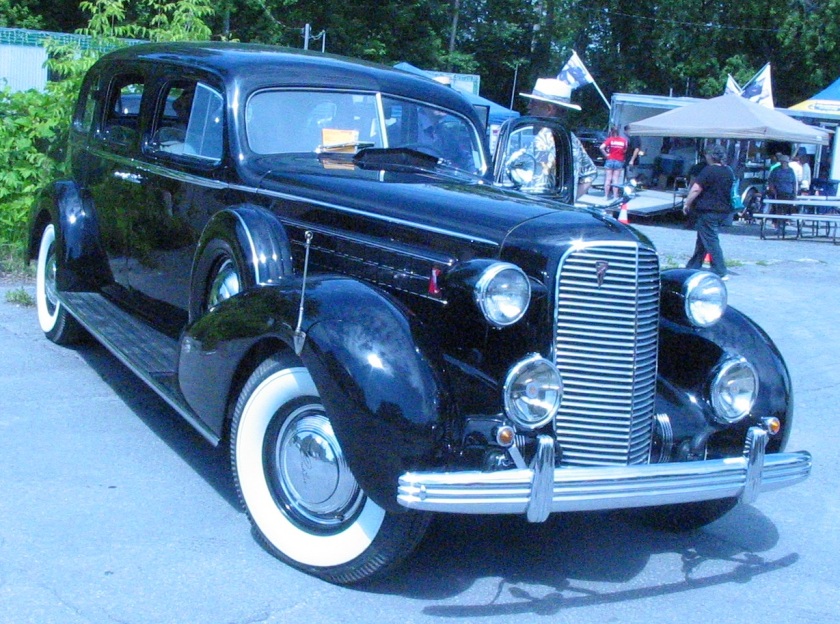 |
|
| Overview | |
| Manufacturer | Chrysler |
| Production | 1934-1936 |
| Model years | 1935-1936 |
| Body and chassis | |
| Class | Full-size |
| Body style | 2-door coupe 4-door sedan 2-door convertible |
| Layout | FR layout |
| Powertrain | |
| Engine | 241.5 cu in (4.0 L) I6 |
| Dimensions | |
| Wheelbase | 1935-1936: 118 in (2,997 mm) |
The Desoto Airstream is an automobile built by the Chrysler Corporation and sold through its DeSoto division during model years 1935 and 1936. During both years, the car was sold along with the streamlined DeSoto Airflow. The DeSoto Airstream 4-door sedan sold for $220 less than a 4-door DeSoto Airflow. Chrysler fielded its own Chrysler Airstream model concurrently; visual cues separated the two automobiles.
More successful than Airflow
The Airstream was created to capture market share lost during the 1934 season when DeSoto only offered the Airflow. In 1935, there were 20,784 Airstream cars sold, as compared to 6,797 Airflow models. Airstream sales nearly doubled the units of Airflows, 13,940, sold in 1934. While streamlined and aerodynamic, the Airflow was not embraced by the public, and the more mainstream Airstream was introduced as a stopgap measure until a fully redesigned DeSoto could be introduced in 1937.
In reviewing the Airstream, conventionality was its best attribute. Solidly built, and more conservatively styled, the 241.5CID 6-cylinder Airstream did away with the Airflow’s integrated headlights, broad grille work andmonocoque construction. While the super structure of the Airstream was all-steel (as opposed to wooden framing – a practice still followed by some US automakers in the mid-1930s), the car rested on its frame, while Airflow’s unibody build qualities placed the passenger compartment within the frame structure. It has a 118″ wheelbase.
Design, options, and pricing
Body styles for 1935 included 2-door business coupe, convertible coupe, roadster coupe, 5-passenger coupe and trunkback sedan. Four-door offerings included a base sedan and a trunkback sedan. The cars featured Chrysler’s vaunted “Floating Power” rubber engine mounts which isolated engine vibration from the chassis. Optional features included carpeting for the front seat area, radio, twin windshield wipers and a heater.
Airstreams were priced about $200 less than the DeSoto Airflow. That, plus the more traditional styling, made the car a success.
1936 features and sales
In 1936 the Airstream was split into two trim levels, Deluxe and Custom. Deluxe models had one piece windshields while Customs (exp. the convertible) had two piece units which were quickly becoming the industry standard. The senior series also gained aCustom Traveller model, built on a stretched 130″ wheelbase. Custom travellers were popular with limousine conversion companies and marked the beginning of DeSoto’s long standing, and profitable relationship with the Taxicab industry.
For 1936 total sales improved to 38,938 units, of which the Airstream accounted for 33,938 units compared to the reduced Airflow offerings with returned 5,000 units for the Airflow’s final year.
- DeSoto Custom (1946–1952)
1939-1952 DeSoto Custom
| DeSoto Custom | |
|---|---|
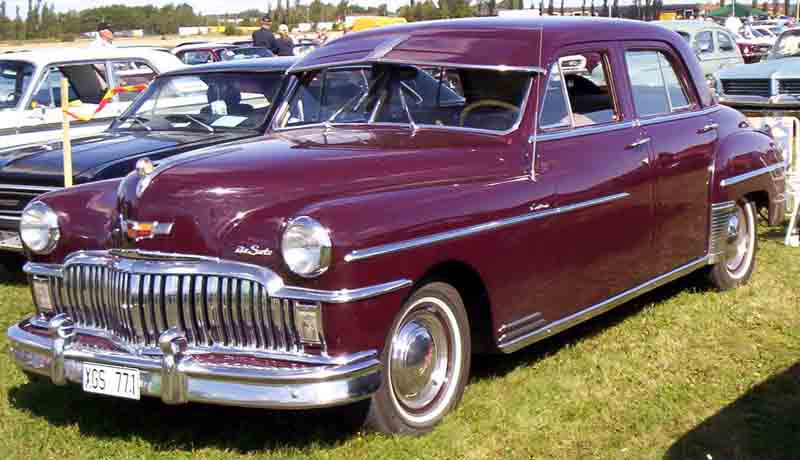 |
|
| Overview | |
| Manufacturer | Chrysler |
| Model years | 1939-1952 |
| Body and chassis | |
| Class | Full-size |
| Body style | 2-door coupe 4-door sedan 4-door station wagon |
| Layout | FR layout |
| Powertrain | |
| Engine | 236.7 cu in (3.9 L) L-head 109 hp(1946), 112hp(1949), I6(1946-1950), 250.5 cu in (4.1 L)L-head 116 hp I6(1951-1952) |
| Dimensions | |
| Wheelbase | 121.5 in (3,086 mm) (1946-1949); 125.5 in (3,188 mm) (1950-1952) |
The DeSoto Custom is an automobile produced by the Chrysler Corporation and sold under its DeSoto automotive brand from 1939 until the 1952 model year. While in production, the Custom was DeSoto’s top-trim level car, and was offered in a wide array of body styles, including a 7-passenger sedan and the extended-wheelbase Suburban sedans.
The Custom shared its engine design with the Deluxe, and were powered by Chrysler’s L-head 236.7 six-cylinder engine, delivering 109 bhp (81 kW) at 3,600 rpm.
Custom models, along with Deluxe models, produced during the 1946, 1947, 1948 and first half of the 1949 model years used DeSoto’s prewar bodies. A fully redesigned Custom was launched in the second half of 1949, along with a redesigned Deluxe, and these cars are referred to as “1949 Second Series” models.
In 1950, the Custom range gained DeSoto’s first consumer-designed station wagon. The Custom also received DeSoto’s first hardtop coupe, which featured pillarless door design and which was trimmed to convertible standards. Standard equipment included two-speed electric windshield wipers, a trunk light and full carpeting.
Customs were unseated as DeSoto’s premium model range with the introduction of the V8-powered 1952 Firedome model range of cars. DeSoto terminated both the Deluxe and Custom model names in 1953, with the DeSoto Powermaster line assuming their place in DeSoto’s 6-cylinder model range.
- DeSoto Diplomat (Export)
DeSoto Diplomat
1961 DeSoto Diplomat based on the 1961 Dodge Dart.
The DeSoto Diplomat is an automobile produced by Chrysler Corporation for sale in export markets outside of the United States. DeSoto Diplomats were “Plodges“”: Dodges or Plymouths or a mix of Dodge and Plymouth components, rebadged as DeSotos. They were manufactured both in Detroit, Michigan, USA, and in Windsor, Ontario, Canada.
The export DeSoto based on the Plymouth was first introduced in 1937 and was built in Detroit. Chrysler Corporation of Canada did not start building export DeSotos until late in the 1939 model year.
In 1946, the export DeSoto became the DeSoto Diplomat. They were exported to Europe, South Africa, South America, Hawaii, and Australia. In 1955, Chrysler of Canada did not export any cars and all 1955 Diplomats came from Detroit. In the late 1950s, some European taxicab drivers preferred to have a Perkins P4C diesel engine in the Diplomat; these diesel engines were installed on a Belgian assembly line.
From 1938 to 1956, the export DeSoto used Plymouth bodies with a grille that looked similar to the regular DeSoto but fit the Plymouth grille opening. From 1957 to 1959, the DeSoto Diplomat used the DeSoto Firesweep front clip with Plymouth body.
The 1960 and 1961 DeSoto Diplomats were based on the full-size Dodge Dart. Although 1960 was the last year for DeSoto in Canada and 1961 for the United States and export markets, Chrysler South Africa built a number of 1962 DeSoto Diplomats based on the Dodge Dart 440 sedan.
Australian production
The SP25 series DeSoto Diplomat was built by Chrysler Australia from 1954 to 1957.
Chrysler Australia introduced a locally produced SP24 series DeSoto Diplomat, based on the 1953 US Plymouth P24 in 1953. This was followed by the SP25 series Diplomat which was based on the 1954 US Plymouth P25, and was built from 1954 to 1957. An Australian developed Coupe Utility version of the Sedan was introduced in 1956.
- DeSoto Deluxe (1946–1952)
1939-1952 DeSoto Deluxe
| DeSoto Deluxe | |
|---|---|
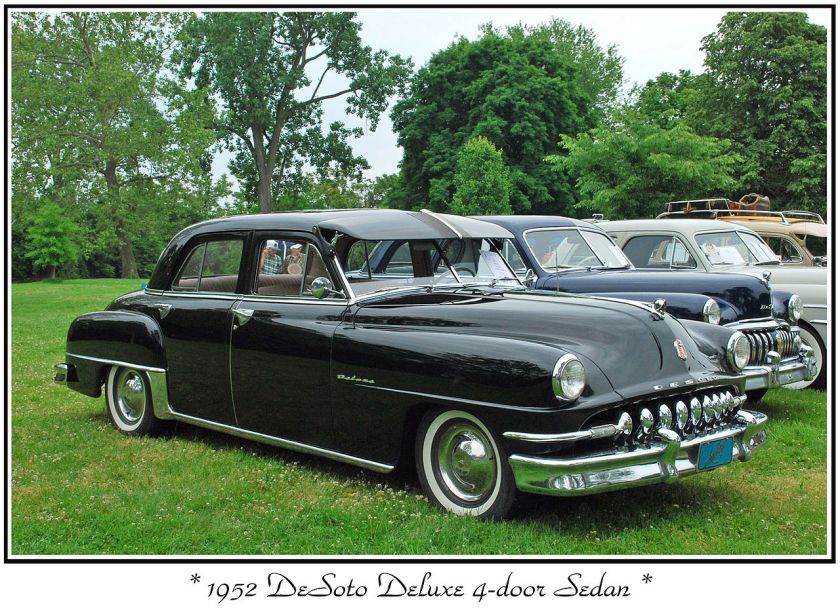 |
|
| Overview | |
| Manufacturer | Chrysler |
| Model years | 1939–1952 |
| Body and chassis | |
| Class | Full-size |
| Body style | 2-door coupe 4-door sedan |
| Layout | FR layout |
| Powertrain | |
| Engine | 237 cu in (3.9 L) I6 |
| Transmission | 3-speed manual Gyrol Fluid Drive |
| Dimensions | |
| Wheelbase | 125.5 in (3,188 mm) |
| Length | 205.8 in (5,227 mm) (1949) 208.3 in (5,291 mm) (1951) |
| Width | 73.2 in (1,859 mm) |
The DeSoto Deluxe (also sometimes spelled DeLuxe) is an automobile produced by the Chrysler Corporation and sold under its DeSoto brand from 1939 through to the 1952 model year. While in production, the Deluxe was DeSoto’s entry-level car, and was offered primarily as two-door and four-door sedans. The Deluxe range also included the extended-wheelbase Suburban sedan. The body was claimed to be rust proof.
The Deluxe differed from the more upmarket Custom line by virtue of the traits found in base models, namely less trim, fewer standard features, and plainer interiors in fewer color combinations. A six-tube and an eight-tube radio were optional.
The Deluxe shared its engine with the Custom, and was powered by Chrysler’s L-head 237 cu in (3.88 l) six-cylinder engine, delivering 109 bhp (81 kW) at 3600 rpm.The DeSoto had full instrumentation.
Deluxes produced during the 1946, 1947, 1948 and first half of the 1949 model years used DeSoto’s prewar bodies, slightly updated following the end of World War II. In 1948, low-pressure tires became standard equipment. A fully redesigned DeSoto was launched in the second half of 1949, and these cars are referred to as “1949 Second Series” models.
In 1950, the Custom gained DeSoto’s first consumer-designed station wagon body style, however the body style was not offered as a Deluxe. The Custom also received DeSoto’s first hardtop coupe, which featured pillarless door design and trimmed to convertible standards, and again, the Deluxe was excluded from the premium body style. In 1951, the brakes grew to 12 inches in diameter.
The Deluxe remained DeSoto’s base model until it was replaced by the DeSoto Powermaster in 1953.
- DeSoto Firedome (1952–1959)
1952-1959 DeSoto Firedome
| DeSoto Firedome | |
|---|---|
| Overview | |
| Manufacturer | Chrysler |
| Production | 1952–1959 |
| Body and chassis | |
| Class | Full-size |
| Layout | FR layout |
The DeSoto Firedome was a full-size automobile produced by the Chrysler Corporation for its DeSoto brand vehicles from 1952 to 1959. Introduced as DeSoto’s premium line of vehicles in 1953 and 1954, the Firedome also occupied the least expensive position in the model lineup during 1955 and 1956 model years before it was reclassified as a mid-range vehicle offered by DeSoto between 1957 and 1959.
Topline series, 1952-54
| First generation | |
|---|---|
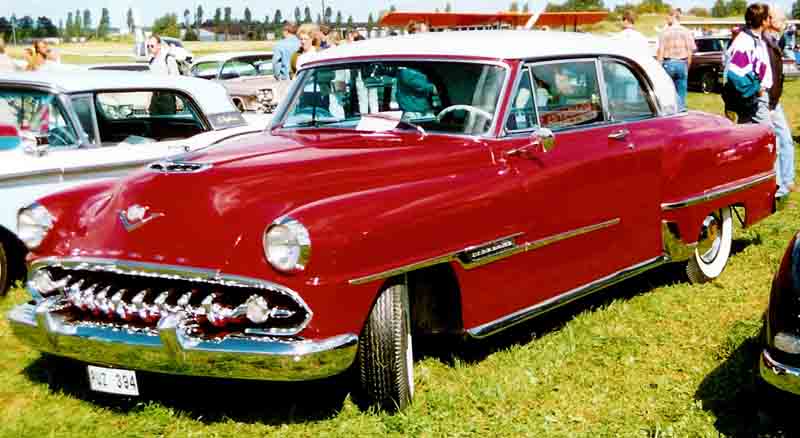 |
|
| Overview | |
| Production | 1952–1954 |
| Body and chassis | |
| Body style | 2-door coupe 4-door sedan 4-door station wagon 2-door convertible |
| Powertrain | |
| Engine | 276 cu in (4.5 L) 160 hp (119 kW)V8 |
The 1953 Firedome was introduced just prior to DeSoto’s 25th Anniversary in 1953, and arrived as the new top series, displacing the Custom nameplate which was retired at the end of the 1952 model year. The entire De Soto model lineup was restyled and Firedome prices started at US$2,740. During the 1953 model year, approximately 64,211 examples were produced.
The Firedome could seat six passengers. It was available as a 4-door sedan, 5-door station wagon, 2-door coupe and 2-door convertible. The AM radio was $85.
The Firedome was powered by a Hemi V8 engine producing 160 hp (120 kW) and had a top speed of 100 mph (160 km/h). The car weighed 3,700 lb (1,700 kg) and had a 0–60 mph (100 km/h) time of 15.5 seconds. This was the first time that DeSoto offered an 8-cylinder engine in one of its models since 1931.
Entry Level series 1955-56
| Second generation | |
|---|---|
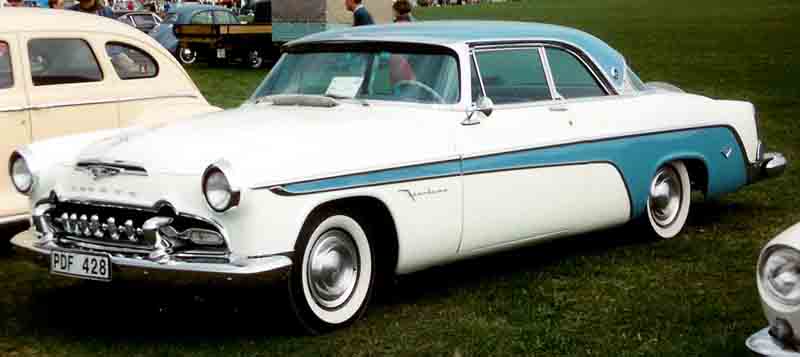 |
|
| Overview | |
| Production | 1955–1956 |
| Body and chassis | |
| Body style | 2-door coupe 4-door sedan 4-door station wagon 2-door convertible |
| Powertrain | |
| Engine | 291 cu in (4.8 L) V8 |
| Transmission | 2-speed automatic 3-speed manual |
| Dimensions | |
| Wheelbase | 116 in (2,946 mm) |
In 1955, Chrysler dropped its 6-cylinder DeSoto Powermaster series and added the topline Fireflite series, pushing the Firedome down to entry level status. Still, the Firedome was not a cheap offering, retaining its V8 engine, but increasing the 276 c.i. displacement to 291 c.i. with a larger bore, and coming with a host of features and interior upgrades that were lacking in the Powermaster series. While Powerflite 2-speed automatics were advertised as standard transmission equipment on the Firedome, officially the car was offered with a 3-speed manual, although few were produced.
Midline series 1957-59
| Third generation | |
|---|---|
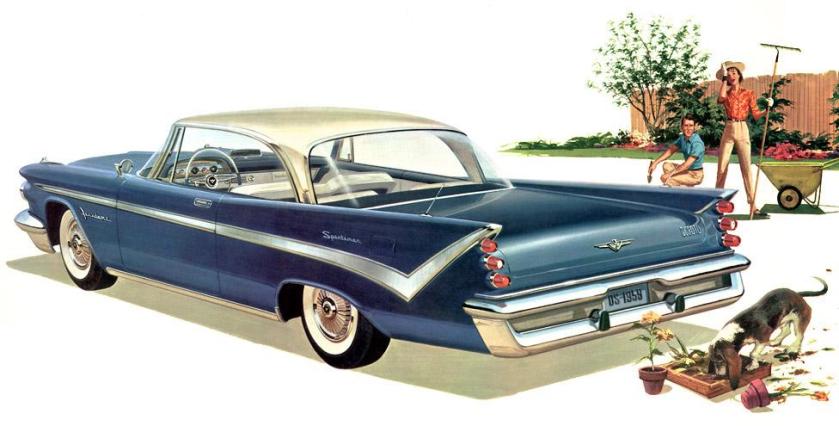 |
|
| Overview | |
| Production | 1957–1959 |
| Body and chassis | |
| Body style | 2-door coupe 4-door sedan 4-door station wagon 2-door convertible |
| Powertrain | |
| Engine | 361 cu in (5.9 L) V8 |
The series was pushed upmarket in the model offering when the 1957 DeSotos were introduced, with the Dodge-based Firesweep.
By 1958 the horsepower had increased to over 300 (220 kW) with the optional of the 361 cubic-inch (5,920 cc) V8 engine. Zero to 60 mph (100 km/h) now took just under eight seconds with a top speed of 115 mph (185 km/h). However 1958 DeSoto’s sales skidded by almost 60% from 1957’s model year output, partially due to the economy and partially because of build issues with the 1957 models.
In an attempt to attract buyers, Chrysler offered the 1959 DeSoto Firedome in 26 solid colors and 190 two-tone finishes. By the end of the 1959 model year, Chrysler was struggling to find buyers for its DeSoto automobiles. Despite the wide variety of models available, consumers shunned DeSoto automobiles as rumor circulated that Chrysler would phase out the marque. A padded dash was standard.
Firedome production ended at the end of the 1959 model year.
For the 1960 model year DeSoto offered two models, the Fireflite and the Adventurer. For model year 1961, a model named only “DeSoto” was sold as a two-door hardtop and four-door hardtop. The end of the DeSoto marque came on November 30, 1960, 48 days after the 1961 models were introduced, ending 32 years of production.
- DeSoto Fireflite (1955–1960)
1955-1960 DeSoto Fireflite
| DeSoto Fireflite | |
|---|---|
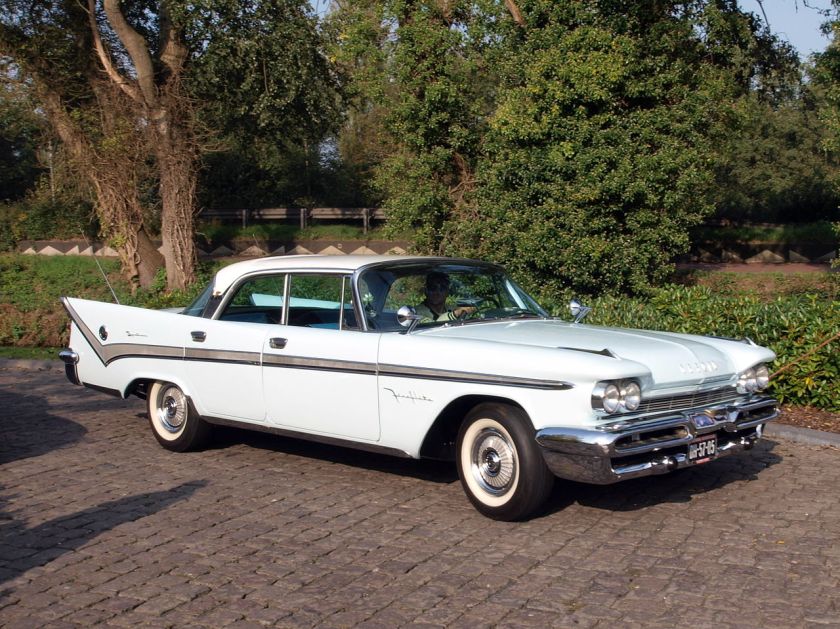
1959 DeSoto Fireflite 4-Door Sportsman
|
|
| Overview | |
| Manufacturer | Chrysler Corporation |
| Model years | 1955-1960 |
| Body and chassis | |
| Body style | 2-door coupe 4-door sedan 4-door hardtop 2-door convertible 4-door station wagon |
| Layout | FR layout |
| Powertrain | |
| Engine | 325 cu in (5.3 L) V8 330 cu in (5.4 L) V8 341 cu in (5.6 L) V8 |
| Dimensions | |
| Wheelbase | 126 in (3,200 mm) |
| Length | 217.9 in (5,535 mm) (1955) 220.9 in (5,611 mm) (1956) 218 in (5,537 mm) (1957) 222.1 in (5,641 mm)(1959) |
| Width | 77 in (1,956 mm) (1955) 78.2 in (1,986 mm) (1957) |
The DeSoto Fireflite is an automobile which was produced by the DeSoto Division of the Chrysler Corporation in the United States from 1955 to 1960.
Design
The Fireflite was introduced in 1955 as De Soto’s flagship model. It was wider and longer than previous DeSoto models and it came equipped with a V8 engine producing 255 hp (190 kW) and PowerFlite automatic transmission. The transmission was operated by a Flite-Control lever located on the dashboard. The car weighed 4,070 lb (1850 kg) and cost US$3,544. AM radio was a $110 option.
The car was best known for its long, tapering tail fins, often accentuated by a two-tone exterior finish. The interior offered bench seating that could accommodate six passengers. The Fireflite had a 0 to 60 mph (97 km/h) acceleration time of 11 seconds and a top speed of 110 mph (175 km/h).
Sales
The Fireflite’s bold design increased sales for DeSoto. In 1955, DeSotos sold well with over 114,765 examples produced, making 1955 the best year for the company since 1946. By 1956, DeSoto placed eleventh in U.S. production with an annual production of 110,418 cars. The success was short-lived, however, and Chrysler Corporation discontinued the DeSoto brand effective in November 1960.
Indianapolis 500 pace car
In 1956 a gold and white Fireflite convertible was the Official Pace Car for the 1956 Indianapolis 500. The Fireflite convertibles were rare, with only 186 produced. Indianapolis 500 President Tony Hulman said the DeSoto was chosen unanimously by the track committee because it delivered outstanding performance and had superb handling characteristics.
Modifications and specifications
The 1956 Fireflite had a longer stroke, 3.80 inches, giving a 330 cubic inch displacement. Compression ratio increased to 8.5:1 and power increased to 230 hp (172 kW). It made up 27.39% of DeSoto’s sales in 1956. Power seats were $70, while power brakes $40.
The Fireflite’s appearance for 1957 was redesigned with the help of Chrysler Corporation‘s head stylist, Virgil Exner. The design was bold and radical with large tail fins, dual oval exhaust and triple-lens taillights. The tail fins were not only aesthetic, but helped to stabilize the car at high speeds.
A four-headlight system was optional for both the Fireflite and DeSoto Firedome models in 1957. The DeSoto Firesweep polyhead V8s were introduced with a bore and stroke of 3.6875 in (94 mm) X 3.800 in (97 mm). for 325 cid. The two barrel V8 was rated at 240 hp (179 kW) while the four barrel version produced 260 hp (194 kW).
The 330 cid hemi engine was replaced by a hemi which was 341 cid. The two barrel carburetor produced 270 hp (201 kW). while the four barrel version was rated at 295 hp (220 kW). Both engines had a 9.25:1 compression ratio.
In 1957 the Fireflite was superseded by the DeSoto Adventurer as the premium DeSoto model. Nevertheless, Fireflites continued to offer high-grade appointments in a full line of body styles. Also in 1957, a station wagon was added to the Fireflite’s lineup. Back-up lights became standard.
In 1958, a new engine was added.
For 1959, the car was restyled. The electric clock became standard. A hand brake light was optional.
- DeSoto Firesweep (1957–1959)
1957-1959 DeSoto Firesweep
| DeSoto Firesweep | |
|---|---|
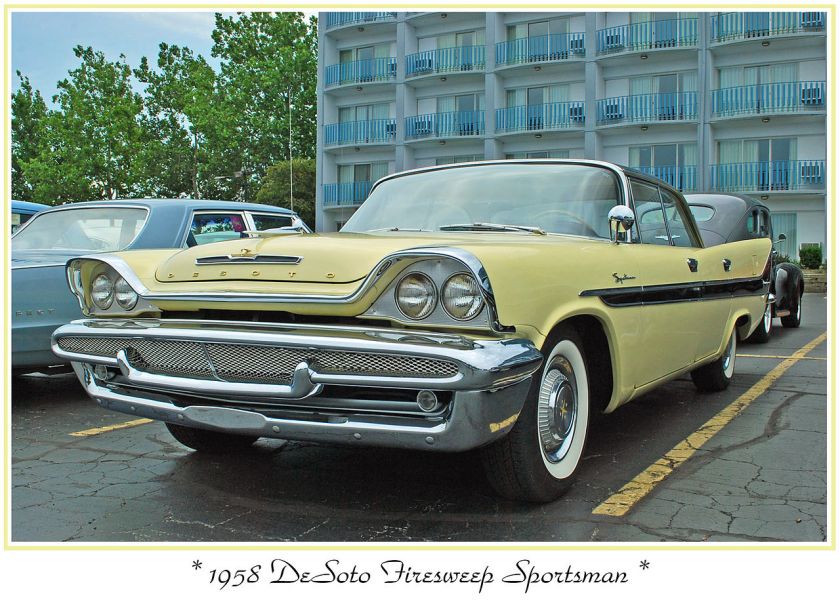
1958 DeSoto Firesweep 4-door Sportsman
|
|
| Overview | |
| Manufacturer | DeSoto Division of the Chrysler Corporation |
| Production | 1957-1959 |
| Assembly | United States Australia |
| Body and chassis | |
| Class | Full-size |
| Body style | 4-door sedan 2-door hardtop 4-door hardtop 2-door convertible 4-door station wagon |
| Layout | FR layout |
| Powertrain | |
| Engine | 325 cu in (5.3 L) V8 350 cu in (5.7 L) V8 361 cu in (5.9 L) V8 |
The DeSoto Firesweep is an automobile which was produced by the Chrysler Corporation and sold under its DeSoto brand from 1957 through 1959.
Interior and exterior description
The Firesweep was a lower-priced entry which combined a Dodge shell and chassis with a DeSoto bumper and grill. 1957 models were sold only as imports in Canada. While the Firesweep featured DeSoto’s signature tailfins, the front clip (the front section, forward of the firewall) was based on the Dodge Coronet. The most telling feature was the headlight design, housed under heavily chromed lids typical of Dodge. Firesweep grilles were similar to those on other contemporary DeSoto models.
The Firesweep could seat six passengers. It was available initially as a four-door sedan, four-door station wagon, two-door hardtop and four-door hardtop. A convertible was added for 1958. Depending on the body style, Firesweeps weighed between 3,660 and 3,980 lb (1,660 and 1,674 kg). The base price of the Firesweep (1957) was US$3,169 and it was offered in one and two-tone exterior finishes. Features includedpower steering, power brakes, dashboard clock, push-button radio and whitewall tires.
Production and sales
The first year of the car’s production, 1957, was the best year for Firesweep sales. A decline in DeSoto quality and increasing market pressures led to the end of the Firesweep’s production at the end of the 1959 model year. During 1959 Firesweep cars carried only DeSoto external nameplates.
For 1960, DeSoto automobiles came in two series, Fireflite and the Adventurer.
The final Desoto model, lacking a series name, was offered for the 1961 model year. DeSoto production ended in November 1960.
Engine specifications, transmission, options
In 1957, the DeSoto Firesweep was powered by the Dodge “Poly” 325 V8 with a 2bbl Stromberg down draft carburetor. The 325 was basically a detuned polyspherical combustion chambered version of the Dodge “Red Ram” 325 Hemi. With the optional power-pack four-barrel V8, the 1957 Firesweep produced 260 hp at 4400 rpm. This represented an increase of fifteen horsepower over the two-barrel engine.
The 1958 Firesweep was fitted with a 350 cu in (5.7 L) V8 and the 1959 model with a 361 cu in (5.9 L) V8
The Firesweep was offered with three different transmissions as well, a two-speed PowerFlite, a three-speed TorqueFlite, or a three-speed column-shifted manual.
The Firesweep was available with up to a three-color paint job (the body was a different color than the “sweep” on the side of the body, and the roof was a different color still). DeSoto offered a laundry list of options for the vehicle to include, but not limited to: clock, AM radio, rear speaker, air conditioning, carpeting, deluxe cloth seat inserts, dual rear antennae, deluxe interior lighting, stainless steel stone shields, power steering, and power brakes.
Australian production
The DeSoto Firesweep was also produced in Australia from 1958 to 1960. Production of the 1958 model began at Chrysler Australia’s Mile End facility in South Australia in early 1958, utilizing CKD components imported from Detroit. It was offered as a four-door sedan with a 350-cubic-inch V8 engine. The 1959 Firesweep, which was released in July 1959, was also assembled from CKD components, and was equipped with a 361-cubic-inch V8 engine and a push-button automatic transmission. The Firesweep was replaced on the Australian market in 1960 by the locally produced Dodge Phoenix.
- DeSoto Powermaster (1953–1954)
1952-1954 DeSoto Powermaster
| DeSoto Powermaster | |
|---|---|
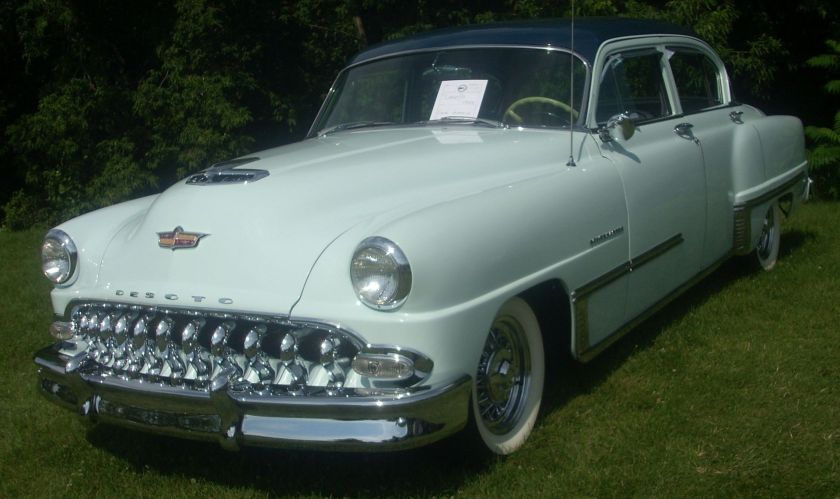 |
|
| Overview | |
| Manufacturer | Chrysler |
| Production | 1952-1954 |
| Assembly | Windsor, Ontario, Canada Los Angeles (Maywood) Assembly |
| Body and chassis | |
| Body style | 2-door coupe 4-door sedan |
| Layout | FR layout |
| Powertrain | |
| Engine | 251 cu in (4.1 L) I6 265 cu in (4.3 L) I6 |
| Dimensions | |
| Wheelbase | 139.5 in (3,543 mm) |
The DeSoto Powermaster was an automobile built by the Chrysler Corporation for sale through its DeSoto division during model years 1952 to 1954. The car debuted during DeSoto’s 25th anniversary, taking the place of both the entry-level DeSoto Deluxe and the DeSoto Custom.
The Powermaster was a full-size car, offered in pillared two and four-door sedan and station wagon models, and powered by Chrysler’s 251 in³ I6 engine. For both of its years in production, the Powermaster was available as an eight passenger sedan through the use of jump seats. The Powermaster was also built on a longer wheelbase (139.5 in (3,543 mm)) than regular six-passenger DeSotos (125.5 in (3,188 mm)). A version of the long wheelbase model was used as a basis for the DeSoto Taxi, seen in many Hollywood movies from the late 1930s through the mid-1950s.
The cars also featured a curved windshield, replacing the two piece windshield used on previous models. Passenger compartment heater, electric clock, power brakes, power steering and white sidewall tires were all available as options.
Powermasters built early in the 1953 model year had minimal chrome trim due to Korean War demands; more trim was added as defense demands decreased.
Chrysler of Canada built the DeSoto Powermaster in both 4-door sedan and 2-door hardtop body styles, the latter not offered in the United States. The Canadian DeSoto Powermaster also used Chrysler’s 265 in³ flahead I6, an engine that first appeared in the 1952 Chrysler Windsor.
The Powermaster was dropped at the beginning of the 1955 model year, when DeSoto transitioned all of its automotive models to V8 engines.
DeSoto Ambulances, Police, Fire and Rescue, Hearses, Limo’s,
Taxis, Specialities and Logo’s
- DeSoto Series K-SA (1929–1932)
- Desoto Series SC-SD (1933–1934)
- DeSoto Series S (1937–1942) (S-1 through S-10, except the Airstream and Airflow)
That’s it.
